Australian
and international
exploratory
performance and
media arts
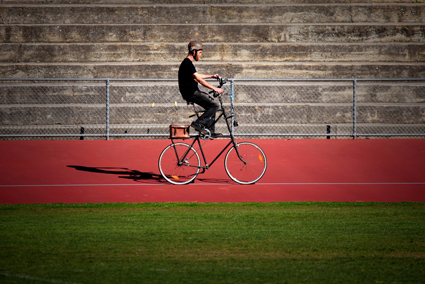
Eine Brise, Maurice Kagel
photo Jason Tavener
Eine Brise, Maurice Kagel
The second Bendigo International Festival of Exploratory Music (BIFEM) took place over a gloriously sunny weekend in the gold mining town of Bendigo. For those who have not visited Bendigo before (it was my first time), it is one of the best-preserved gold-rush towns in Australia with grandiose public buildings and sprawling parks. The Victorian public works somehow perfectly suited Australia’s most intense contemporary music festival.
It is not easy to ‘dip into’ BIFEM, as one is swept along a schedule of back-to-back concerts, panels, workshops and community events over three short days. The effect is ultimately challenging and stimulating, offering new perspectives on music to audiences, performers and composers alike.
Beyond the guest artists, the festival’s main attraction is its program of new and classic works of the 20th century curated by the festival’s Director David Chisholm. Geneva’s Vortex Ensemble brought an important theatrical inflection to the festival. Their first concert was a symbiotic dance of electronics and flesh as they performed naked in front of infra-red cameras in the Bendigo Art Gallery. The ensemble only performs new work, and usually that of ensemble members, so the next day we were treated to a concert of playful pieces by Swiss-based composers. In a valuable contribution to contemporary music theatre in Australia, Vortex staged Salvadorean composer Arturo Corrales’ piece Bug on Saturday night.
The festival was an opportunity to celebrate the dreamy lucidity of Melbourne’s Golden Fur, before they all rush off to California. Cellist Judith Hamann performed a solo recital combining installation art, lighting design and straight-up cello performance. Samuel Dunscombe teamed up with pianist Peter Dumsday to reboot the first ever piece for the Max program, Pluton. The pianist and composer James Rushford had several pieces performed in the festival, as well as performing a solo recital on the organ of the Sacred Heart Cathedral. Together, the group performed a surprisingly diverse and light-hearted program including works by David Chisholm, Anthony Pateras, Ivan Wyschnegradsky and others.
The festival’s house band, the Argonaut Ensemble, tried to inject some string culture and provided audiences with a rare opportunity to hear Grisey’s epic work Vortex Temporum under the baton of the award-winning conductor Maxime Pascal. Pascal’s energy was infectious, especially in Zipangu by the festival’s audience favourite, Claude Vivier.
Elsewhere the French composer Clara Maïda brought her charged electroacoustic atmospheres to the Bendigo Bank Theatre, piano virtuoso Zubin Kanga played a recital to infants and performance workshops were given by international superstar-flautist Eric Lamb and the Perth-based new music virtuoso clarinettist Ashley Smith. For musicology nerds like myself, the presence of Stockhausen’s teaching assistant and wide-ranging musicologist Richard Toop was a thrill. An all-star cast was imported (and retrieved, having flown the Australian coop) for the performance of Stockhausen’s music theatre piece Sirius, namely Nicholas Isherwood, Tristram Williams, Tiffany Du Mouchelle, Richard Haynes, with sound projection by Myles Mumford. Detailed reviews of these concerts can be read on my contemporary music blog Partial Durations.
This year the organisers decided to expand the discursive aspect of the festival with a series of lectures and discussion panels. To begin with, I had misgivings about the old-fashioned themes for the panels. “Duration and Durability” grew out of the performance of Morton Feldman’s six-hour String Quartet no.2 last year. “Wired” was to be yet another exploration of the place of electronics in contemporary music. Both were enormous successes, with the panellists and audience (both were convened more as open discussions than panels) quickly finding the contemporary resonance of the given topics.
After dancing around some different philosophical and musical definitions of duration (including some musing on the “adagio decade” of the 1970s by Toop) it became clear that the panel wasn’t very interested in the experience of extreme duration works, but wanted to know how and why one would compose with duration as a key consideration. David Chisholm saw one-idea pieces as fundamentally didactic, as sensitising the listener to a particular technique. Brett Dean raised the issue that a long piece exploring one idea was less risky because one had longer to find something that worked for any given listener. So much for the why, but how? Thomas Reiner brought up competing notions of “outside-in” and “inside-out” compositional strategies and James Rushford countered that either can fail and that what mattered was the intended effect. I would like to know whether composers have extended parts of scores because the ensuing moment didn’t ‘work’ without a longer preparation, much as certain effects in theatre don’t work before an hour or so has passed. The discussion foregrounded duration effects throughout the festival, making me ask what was being explored, what the intended pay-off was and whether the effect was interesting within the context of the piece.
The “Wired” panel quickly recognised the standardisation of music programming languages and technology today. This has led to a more fluid divide between engineers and composers, even though Clara Maïda pointed out that there are still many pieces with new technology and old art (as we were reminded when we heard Pluton). The panel used notions of technique and technology fairly interchangeably, but it is evident that there is often a lag or plain divide between compositional strategy and available music technology. The contemporaneity of technology and technique became a useful frame for evaluating the electronic contributions to some of the later concerts. The final question for the panel, “What do you want in the future?” dashed any hope of a greater integration of the two, with such technology-fetishist answers as “flying speakers” and “morphing nanotech mallet heads” (though both of those would be cool). At 90 minutes the discussions were just beginning to get interesting and I can only hope that these sessions are given two hours next year.
Two wonderful events took the festival outside of the concert halls and into the community. A performance of Mauricio Kagel’s Eine Brise, a “transient action” for 111 bicycles saw a much smaller peloton circle the Tom Flood velodrome whistling, singing and ringing their bells to the cheers of a few dozen supporters. The colourful and ultimately hilarious sonorous sculptures produced during Dale Gorfinkel’s children’s workshop were opened as an installation on Saturday, allowing adults to navigate a maze of interconnected bellows, balloons and bells.
A duration experience in itself, the marathon of BIFEM induces moments of delirious rapture, but also shortens one’s temper enough to provoke important questions such as, “Is this piece really worth my time?” Thankfully David Chisholm’s curatorial nous rarely leaves one with a negative answer.
Bendigo International Festival of Exploratory Music, Bendigo, 5-7 Sept
See Partial Durations for more reviews of BIFEM.
RealTime issue #123 Oct-Nov 2014 pg. 41
© Matthew Lorenzon; for permission to reproduce apply to realtime@realtimearts.net
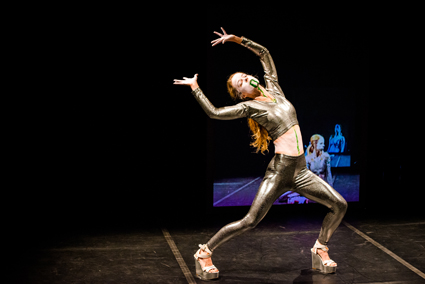
Atlanta Eke, Body of Work
photo Gregory Lorenzutti
Atlanta Eke, Body of Work
The importance of the Keir Choreographic Award cannot be underestimated in the challenging climate in which independent choreographers work in this country. The prizes not only alert us to emerging talents and reward them with heightened visibility and cash (the Judge’s award, $30,000; the People’s Choice Award, $10,000) but perhaps the Award also signals where contemporary dance is headed. The latter, moreso than the winners, was the subject muttered about in the Carriageworks foyer after the awards announcement, as it was during Performance Space’s SCORE season (see pp19-23).
I can’t recall when I’ve heard, post-show, so much uncritical enthusiasm on the one hand and scorn on the other. There were eight semi-finalists: Sarah Aiken (VIC); James Batchelor (VIC); Tim Darbyshire (VIC); Matthew Day (VIC); Atlanta Eke (VIC); Shaun Gladwell (NSW); Jane McKernan (NSW); and Brooke Stamp (VIC); their works were performed at Melbourne’s Dancehouse. The works of the four finalists Aiken, Eke, Day and McKernan were on show at Sydney’s Carriageworks. (Perhaps the next showings should be telecast from one venue to the other.) What triggered debate was form. Award-winner Atlanta Eke’s Body of Work was even less a dance work than Monster Body, her much acclaimed segueing of dance, performance art and installation. Body of Work’s media dimension—the performer’s manipulated view of her ‘actual’ and virtual selves—suggested potential which the Award money might help realise.
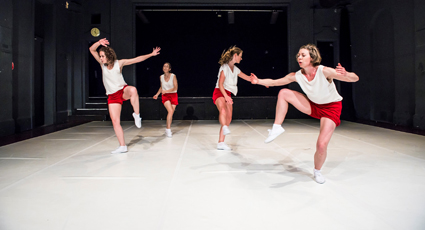
Carli Mellow, Angela Goh, Leeke Griffin, Lizzie Thomson, Mass Movement, Jane McKernan
photo Gregory Lorenzutti
Carli Mellow, Angela Goh, Leeke Griffin, Lizzie Thomson, Mass Movement, Jane McKernan
Matthew Day’s Rites (a take on Nijinsky’s The Rite of Spring) was critically limited by its short duration and an awkward dramatic structure, but the work did spring from his body, as ever not looking like any dance we’ve seen, for which I’m grateful. Sarah Aiken’s Three Short Dances was Bauhaus-lite, more installation than dance, its large geometric shapes moving unrevealingly and the artist’s balancing of long poles on head, hands and shoulders aesthetically inexpressive. Jane McKernan’s Mass Movement was based on an improvisational structure which gave the work cogency, a great sense of nervy fluidity (suspenseful even as we waited for various patterns to resolve into a singularity of purpose) and featured actual dancing. McKernan won the audience vote (if foyer talk was anything to go by, Eke was also highly popular).
If there was a shortage of remarkable dancing in the final of the Keir Choreographic Award, there were ample signs of a young generation’s preoccupation with the body relative to its mediatised self, states of being, game structure and installation, none of them particularly new but certainly warranting renewed and regenerative investigation. Matthew Day (as evident in previous works) is the most idiosyncratic choreographer but his durational approach doesn’t mesh well with a competition requiring 20-minute creations (he came in around 10 minutes). Although conventional notions of dance haven’t figured highly in the finals, there are choreographic sensibilities at work, if not to everyone’s taste.
Expressions of disgruntlement centred on a perceived appropriation of dance by other art forms, not least the electronic arts, hence disappointment at the selection of video artist Shaun Gladwell as a semi-finalist (the award is open to non-dance artists who don’t necessarily even work with dancers) and irritation with Atlanta Eke’s limited movement palette and a po-mo overload of references that don’t add up to dance. Ironically, the movement to centre-stage of other practices in dance has been fostered by a generation of successful Australian choreographers who have fruitfully collaborated with photographic, video, sound, fashion, music and installation artists to yield aesthetically and intellectually ambitious works in which dance is primary but at the same time one part of an array of forces corralled by artists who describe themselves first as directors, then as choreographers.
There are dance artists and followers who feel that dance is being buried alive beneath other artforms—or displaced by notions of what constitutes art. Therefore, Natalie Abbott’s Maximum is not a dance work, it’s ‘just conceptual;’ Antony Hamilton’s Keep Everything is ‘over-blown,’ ‘tricksy dance theatre’ (although the dancers’ virtuosic skills are much admired, as if not choreographed), but Narelle Benjamin’s Hiding in Plain Sight is ‘the real thing’—entirely a dance work, one comfortably rooted in the lyrically fluent modern dance tradition of the last century, if blessed with the choreographer’s idiosyncratic demands on the body’s flexibility. Angst has also been expressed about recent works by Philip Adams and Luke George (page 26) which evoke ritual, the spiritual and the paranormal, their creations more akin to live art than dance. Is dance about to go missing?
Modernism’s challenge to ballet early in the 20th century and the Postmodern upheavals of the 1960s are still being felt in an artform which is at once born of highly disciplined, inherently conservative training, often from childhood, and a sometimes surprising openness to experiment. A desire for purity of expression has been central to these movements, expression freed of theatricality, narrative and psychologising—pure dance, of itself and nothing more. The Trisha Brown: From All Angles (see p15) program in the Melbourne International Arts Festival in October will track the evolution of this artist’s seminal aesthetic from un-dancerly performance art-like events to highly integrated, collaborative stage works—without Brown ever abandoning first principles.
Dance in the early 21st century is hugely diverse, complex and rampantly hybrid; it’s not surprising that there’s a desire to return to something essential (as in certain improvisational practices) or to at least further the abstraction and clarity of line in the dance of the second half of the 20th century with its entwined lineage of ballet, Modernism and Postmodernism.
Is a (mostly) generational battle looming over form and a perceived subordination of dance to other forms, or was it just a Sydney thing—in a state without a major dance school, with small university dance courses under threat and inordinately strong competition for arts funding? Given the unusually passionate, if not loudly expressed, opinions about the Keir Choreographic Awards (predictably there were complaints about the appropriateness of the judging panel, which included Mårten Spångberg, “the acclaimed ‘bad boy’ of [European] contemporary dance” [press release]), it would be healthy for the Sydney dance scene, and beyond, if these views were publicly discussed rather than rumoured. Was there dancing? Will there be dancing?
It is critical, from time to time, to ask what constitutes dance and how it renews and extends and even perhaps limits itself—as in the 90s with the incorporation of a greater range of body regimes and technologies. Interviewed in Bodies of Thought: 12 Australian Choreographers (RealTime-Wakefield Press, 2014), choreographer Helen Herbertson says, “…there’s such an enormous scope for dance to be applied. I almost feel like it’s lost a kind of specificity of being about physicality… So I think we are slightly in danger of dance looking like it’s just a kind of tool to be used. I’m waiting for a kind of re-flowering of really specific, particular detailed language.”
Congratulations to Atlanta Eke and Jane McKernan and to Phillip Keir and his partners, Carriageworks and Dancehouse, for bravely supporting emergent choreography in whatever form it takes. Long may the Awards persist and, like many an art prize, controversially test our collective taste and judgment.
–
Carriageworks, Dancehouse and The Keir Foundation: Keir Choreographic Award, finals, Carriageworks, 17-19 July; Performance Space, SCORE, Carriageworks, Sydney, 1 Aug-7 Sept
RealTime issue #123 Oct-Nov 2014 pg. 29
© Keith Gallasch; for permission to reproduce apply to realtime@realtimearts.net
At Carriageworks on September 12, we celebrated 20 uninterrupted years of RealTime—its writers, editors, staff and clients, our Open City Inc Board of Management (publisher of RealTime) and especially our readers, supporters and the artists we treasure.
The evening commenced with the launch of Bodies of Thought: 12 Australian Choreographers, jointly published by RealTime and Wakefield Press. Choreographer Sue Healey, one of the book’s subjects, spoke of its importance for her and Carin Mistry (Dance, Australia Council) launched it. The editorial duo, Erin Brannigan and Virginia Baxter, thanked contributors, reflected on their labours of love and mused over some of the big questions about Australian dance the book confronts.
The birthday celebrations proper commenced with speeches of reflection and congratulation from Open City Chair Tony MacGregor, sponsor Andrew Findlay, Managing Director, Vertical Telecoms (Vertel) and Andrew Donovan, Director, Emerging & Experimental, Australia Council. Managing Editors Virginia Baxter and Keith Gallasch reciprocated with a curated suite of 20 one-minute performances (one for each of our 20 years) gifted to RealTime by Nigel Kellaway, Julie-Anne Long, Edward Scheer, Felicity Clark, Amanda Stewart, Nalina Wait, post [Mish Grigor, Natalie Rose], Miranda Wheen, Caroline Wake. Katia Molino, Ruark Lewis, Clare Britton & Matt Prest, Gail Priest, David Williams, Jason Noble [Ensemble Offspring], Vicki Van Hout, Rosie Dennis, Sam James and Keith and Virginia themselves, to a sound score by Gail Priest.
Thanks to all who spoke, performed and attended and to the generous Carriageworks team. This was a wonderfully affectionate and truly communal celebration.
Virginia, Keith, Gail, Katerina & Felicity
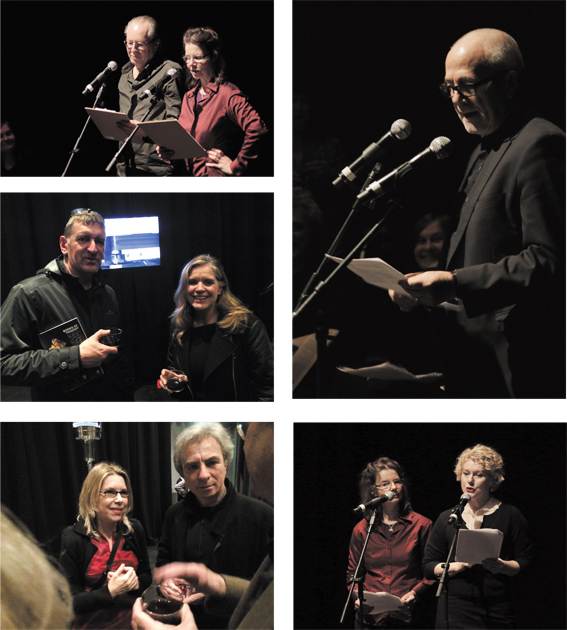
Clockwise from top right – Tony MacGregor, Open City Chair; Virginia Baxter and Erin Brannigan; Annemarie Jonson, Alessio Cavallaro, former OnScreen editors, photo Sandy Edwards; writer Edward Scheer, writer and former contributing editor Jacqueline Millner, photo Sandy Edwards; Keith Gallasch & Virginia Baxter
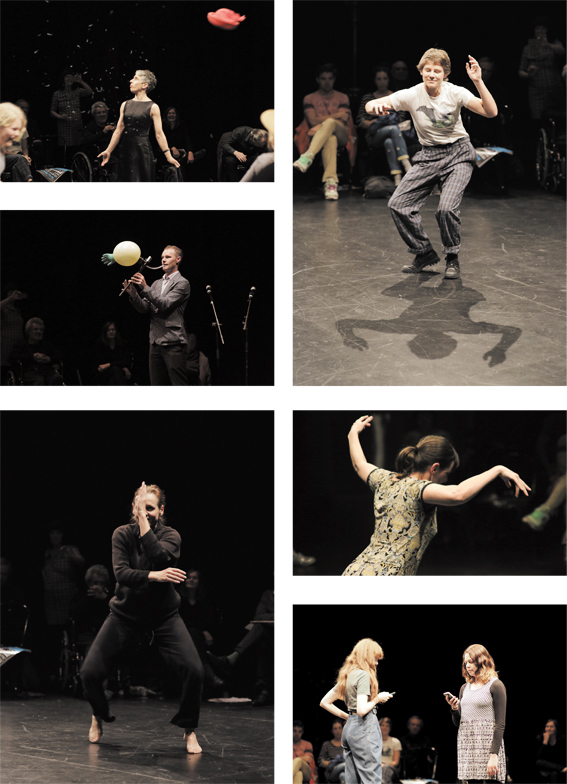
Clockwise from top rightMiranda Wheen, Nalina Wait, Mish Grigor & Natalie Rose, Vicki Van Hout, Jason Noble, Katia Molino
RealTime issue #123 Oct-Nov 2014 pg. 30-31
© RealTime ; for permission to reproduce apply to realtime@realtimearts.net
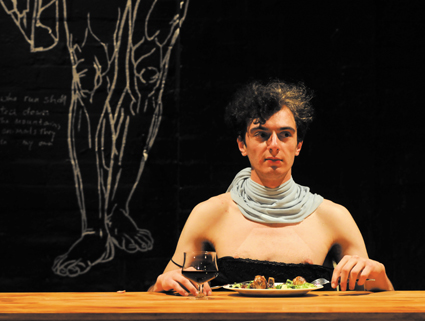
Sacha Cohen, The Three Minute Bacchae and other Extreme Acts, 2008, PACT
photo Heidrun Löhr 2007
Sacha Cohen, The Three Minute Bacchae and other Extreme Acts, 2008, PACT
For 50 years Sydney’s PACT has been a seedbed for artists of all kinds, most recently those engaging with contemporary performance and live art. In the late 60s and early 70s it was a vital hub for folk music, adventurous theatre (a multi-site production of Ibsen’s Peer Gynt) and happenings. In following decades it focused on youth theatre.
Nowadays titled PACT Centre for Emerging Artists, the organisation “supports, produces and presents interdisciplinary and experimental performance work by emerging artists from diverse backgrounds…providing a space (its home theatre in Erskinville in Sydney’s inner West) for artists, where all aspects of experimental performance can converge in a vibrant and holistic community.”
Originally housed on the edge of the Sydney CBD, near Darling Harbour, PACT was founded by a group led by Robert Allnutt, Jack Mannix and Patrick Milligan in response to the Federal Government’s Vincent Committee Report that “highlighted the dire state of Australia’s performing arts, film and television industries.” This was at a time when the arts landscape was thinly populated, largely prior to the emergence of state and independent theatre and dance companies in the late 60s and into the 70s and of an incipient film industry. PACT (Producers, Authors, Composers and Talent, and later Producers, Artists, Curators, Technicians) aimed to develop a range of practitioners who would enrich Australian culture.
Alumni include a kaleidoscope of significant names in Australian arts and entertainment including Peter Weir, Graham Bond, Zoe Carides, Lara Thoms, Matt Prest, Mish Grigor, Natalie Rose and Zoe Coombs Marr (post), Malcolm Whittaker, Alison Richardson, Augusta Supple, Sally Lewry, Ashley Dyer, Nick Atkins, Natalie Randall, Daniel Prypchan, Jane Grimley, Caroline Wake, Amity Yore and Ling Zhao. PACT has yielded directors, performers, writers, curators, choreographers, filmmakers, digital media artists, sound, lighting, set and costume designers, technicians, artistic directors, cultural producers and marketing managers.
As the cultural landscape transformed over 50 years, so too did PACT, focusing in recent decades on young and then specifically emerging artists—ranging from late teens well into their 20s, eager to learn, collaborate and engage directly with the public while on the cusp of their careers.
The PACT IS FIFTY birthday audience will be addressed by Lord Mayor of Sydney, Clover Moore, and entertained by past and present PACT artists and artistic directors (who have included Caitlin Newton Broad, Anna Mesariti, Cat Jones, Julie Vulcan and now Katrina Douglas). There’ll also be screenings of rare archival footage and the launch of PACT’s 2015 program.
In RealTime 124 we’ll report on the celebrations and take a close look at PACT’s distinctive history and the breadth and depth of its sense of community. A visit to the Previous Events pages of PACT’s website offers a glimpse of a decade of engagement with young artists, arts organisations, festivals and communities. An extra 40 years adds up to a remarkable achievement.
PACT IS FIFTY, PACT, 107 Railway Parade, Erskineville, Sydney Saturday 18 Oct 6-9pm
RealTime issue #123 Oct-Nov 2014 pg. 32
© RealTime ; for permission to reproduce apply to realtime@realtimearts.net
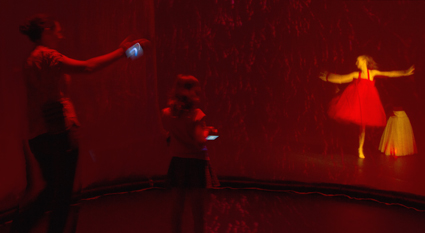
Nerve Engine, Bonemap
photo Tai Inoue
Nerve Engine, Bonemap
Bonemap invites one audience member every 15 minutes to participate in Nerve Engine. Designed to ensure a very personal experience, this interdisciplinary and immersive one-on-one format has been perfected by this Cairns-based company (new media artist Russell Milledge and performer and co-creator Rebecca Youdell) over the past four years.
The installation is made up of two large round netted and transparent scrims hanging from roof to floor in a darkened room. The participant, with an iPhone attached to the back of their hand, stands inside one scrim while the other, four metres in front, is empty.
I’m immediately submerged in an environment of sound and image. Four double projectors fill the corners of the room with digital imagery, all of which is stitched together by software developed by Milledge. At the same time I’m engulfed by a 4.1 sound system. The work is coordinated by Milledge from a control desk behind me. Along with the programmed light and sound, an extra layer of sound is triggered by the iPhone—influenced by my movements.
As Nerve Engine begins, a spotlight illuminates a dancer, Youdell, in a brilliant red dress dragging a treasure chest. She too has an iPhone attached to her hand and I’m gently enticed into a duet of movement, finding myself imitating her arm movements. Then through a series of gestures she almost becomes my puppet as I guide her into the chest and she disappears.
The experience lasts for approximately 10 minutes and crescendos with loud, all-encompassing drumming while the performer reappears making frenzied movements in a red tutu.
The images projected on the participant’s scrim are elemental—water, air, smoke and flames. At times there is sensory overload—images are layered, the sound is engulfing and attention repeatedly drawn to the performer—theatrically lit and always garbed in red: the red of blood, the life force and nerve engine of the work.
With Youdell suspended in space like a lab specimen in the middle of the second scrim, the work concludes with a projection of the dancer in the stance of Leonardo’s Vitruvian Man, linking Nerve Engine to Bonemap’s ongoing exploration into the relationship between body and universe.
Most impressive is the way image, sound, light and action combine seamlessly, the result of clever use of technology alongside physical performance. As a participant I come away feeling privileged to have been part of a unique experience—a performance orchestrated just for me.
2014 Cairns Festival, Nerve Engine, director, scenographic design, media Russell Milledge, co-director, choreographer, performer Rebecca Youdell, sound design Steven Campbell, programmer Jason Holdsworth; Cairns Entertainment Centre, 26-30 Aug
RealTime issue #123 Oct-Nov 2014 pg. 32
© George Dann; for permission to reproduce apply to realtime@realtimearts.net
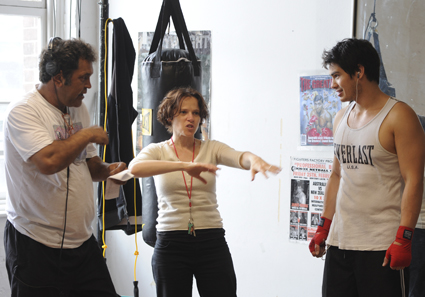
Billy McPherson, Roslyn Oades, John Shrimpton, I’m Your Man rehearsals
photo Heidrun Löhr
Billy McPherson, Roslyn Oades, John Shrimpton, I’m Your Man rehearsals
There is a certain self-consciousness that comes over a writer when faced with interviewing an artist who conducts, edits and restages interviews for a living. I speak, of course, of Roslyn Oades, a Sydney-born, Melbourne-based artist who has spent more than a decade pioneering the form she calls “headphone verbatim.” [Actors are fed edited audio via headphones which they reproduce with precision. Eds.]
Though we have talked previously, about everything from the merits of supra- versus circum-aural headphones to the ethics of sharing other people’s stories in performance, when I get the brief for this article it occurs to me that we have never really discussed gender. What follows derives from a telephone conversation we had on the evening of September 4, four days before Oades went into rehearsal for her latest project, Hello, Goodbye & Happy Birthday, which will premiere at the Melbourne Festival on October 9.
Art, theatre, voice, installation
Oades identifies four paths or practices that have led her to this moment, starting with her formal training at the College of Fine Arts at the University of New South Wales in the early 1990s. COFA had only recently merged with UNSW and Oades was among the first students who could take art classes at Paddington as well as humanities subjects at the main campus in Kensington. She speaks fondly and proudly of training in photomedia with Anne Zahalka and in theatre with John McCallum, among others. This would be more than enough for most students, but Oades also wanted to explore acting, leading to the second strand of her practice. While still at university, Oades won a guest role on A Country Practice, where she huffed and puffed her way through a teen pregnancy and labour.
Once she had graduated, Oades continued to work in television, doing small guest roles on shows such as Police Rescue (“Leah Purcell and I were rookie cops together”) before landing a larger role on Home and Away. From 1996 to 1998, she appeared in 25 episodes as Kylie Burton before being arrested at the altar and then dying of a drug overdose in prison. Such plotlines did not so much plant the seeds of doubt, as water them; Oades was still living in Bankstown, trying to reconcile its diversity with the very white world of Summer Bay, and wondering how she might go about making her own work. So she called the Bankstown Community Arts Officer, Tim Carroll, and asked him about what he did and how he got his job. Working with Carroll at the Bankstown Youth Development Service allowed Oades to start Westside (a publication for emerging writers from the western suburbs), investigate installation art (“we filled an empty bank with gravel”) and also introduced her to Alicia Talbot and Urban Theatre Projects, which would in turn lead to her first full-length theatrical production.
In the meantime, she had also started cultivating the fourth strand of her artistic practice—voice work. In 2000, her interest in voice took her to the United Kingdom, where she recorded every accent she could while also training and working with Mark Wing-Davey and his Non-Fiction Theatre company. She came home the following year to voice the character of Tracey McBean in the children’s program of the same name. More acting work followed, but when she appeared on All Saints for a second time, eight years after the first and playing yet another infanticidal mother (“I think I’ve killed six babies and a mother during my career”), she decided she’d had enough.
Headphone verbatim theatre
Oades’ first work, Fast Cars & Tractor Engines (2005), started life as the Bankstown Oral History Project. In 2000, she helped three young artists from the area perform some excerpts for the project’s launch. Two years later, she directed a 15-minute version for Urban Theatre Projects’ Short and Sharp season; three years after that, a full-length production premiered at the Bankstown RSL, to immediate and effusive praise (see David Williams in RT70). Since then Oades has made four more headphone verbatim works, including Stories of Love & Hate (2008; RT89) and I’m Your Man (2013; RealTime 117, Darwin Festival Feature).
While Oades calls these three plays her Acts of Courage trilogy, and Currency Press is about to publish them in a volume with that very title, I sometimes think they could just as easily be called the Australian Masculinities trilogy. It is fascinating to hear men from Bankstown, Cronulla and beyond trying to impress each other as well as their female interviewer while talking about love, violence and sacrifice. In I’m Your Man in particular one is often struck by the fact that Oades must have been the only woman in the room, moments before the big fight, trying to capture what she calls “adrenaline on tape.” Of course masculinity becomes all the more intriguing in performance when an actor like Katia Molino conjures it with a mere shift of the leg and tilt of the head. This “gap,” as Oades often calls it, between an actor and their character’s gender, race, ethnicity and age, is absolutely key to headphone verbatim if it is to be anything more than a “style.” For Oades, headphone verbatim is more than a theatrical “texture or technique;” it is a “dramatic device that enables us to think about who’s allowed to say what in Australia.”
The mention of masculinity brings us to gender more broadly and how it has shaped her career. Oades tells me how “at the start of every show, I have to be talked into making it; I feel as if I have an idea but I’m not sure if it’s any good.” Happily she has always been persuaded, but having sat in on artist pitching sessions since, she thinks that this is not a personal but rather a structural issue: male artists seem “better at stepping forward” whereas women often present themselves as “team players” and thus come across as less confident. On the contrary, when a woman is confident, and does pursue her artistic vision with the same focus as one of the many feted young men, she can be perceived as “difficult” or “demanding.” These insights have arrived in part thanks to Oades’ time as Malthouse Theatre’s Female Director in Residence in 2013. Like Anne-Louise Sarks (RT116), who was in residence at Malthouse in 2011, Oades is acutely aware of being in the “right place at the right time:” next door to Urban Theatre Projects when it moved to Bankstown; ready to take a production from the margins to the mainstream when Belvoir came knocking; and in Melbourne when Malthouse initiated its scheme. Indeed, it was there that she started work on her current project.
Hello, Goodbye & Happy Birthday, a Melbourne Festival Malthouse premiere headphone verbatim work drawing on responses from 18- and 80-year-olds, is not the first piece she has done outside the Acts of Courage trilogy—that was a Vitalstatistix commission, Cutaway: A Portrait (2012). It is, however, her first project without Katia Molino and Oades admits to feeling slightly lost without her. Perhaps this is why she thinks that this might also be her last headphone verbatim piece, at least for a while. She says she is interested in continuing audio work but without actors. One possibility involves the audience listening to recordings or re-enactments of conversations say, between a father in prison and the son who is allowed to speak with him for 12 minutes each week.
She’s also interested in creating an immersive piece, bringing her full circle back to those Bankstown installations all those years ago. When I ask Oades about what binds the many aspects of her practice, she says simply “storytelling,” to which I would add “listening”—a vital skill for every woman in a world of “mansplaining” (see Rebecca Solnit’s essay “Men Explain Things to Me” if you haven’t already (www.tomdispatch.com).
But do not confuse listening with passivity. Roslyn Oades says she loves nothing more than “disappearing in a room, when everyone else is speaking and I’m listening. I can look quite mousey and inconsequential, but really I have a microphone. I’m recording and that’s a very powerful thing.”
Melbourne Festival & Malthouse, Roslyn Oades, Hello, Goodbye & Happy Birthday, Malthouse, Melbourne, 9-26 Oct
RealTime issue #123 Oct-Nov 2014 pg. 33
© Caroline Wake; for permission to reproduce apply to realtime@realtimearts.net
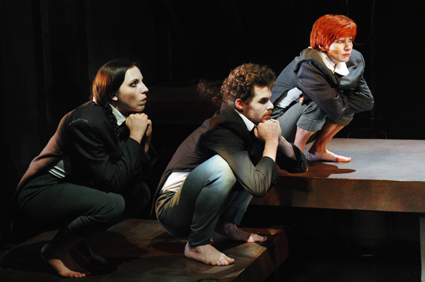
Eurydice, Red Stitch
photo Jodie Hutchinson
Eurydice, Red Stitch
When a performance purports to speak to a reality outside of itself, it’s fascinating how often we put absolute faith in that claim.
I’m not referring to the more profound ontological questions raised by philosophers and undergrad theatre alike, but the simple way in which we accept the honesty of an artist who apparently draws on experience, or presents something based on research, or includes found material, quotation or documentary. This is a good thing—think how much would be lost if we approached all art with paranoid suspicion—but it’s also just one of the many, many clauses in the unwritten contract we tend to agree upon in the creative sphere.
Red Stitch, Eurydice
US playwright Sarah Ruhl’s Eurydice maintains a very clear connection with a reality external to its fictional world. It retells the myth of Orpheus from the perspective of his wife, but in doing so also warps the story through an autobiographical lens. It’s a compelling proposition—merging a form of writing in which fabrication is almost unforgivable with a mythology that works on symbolic, allegorical and fantastic levels. When Eurydice arrives in the Underworld she finds her dead father there, but while her memory of him has been washed away by the river Styx, his own recollections have been imperfectly removed and he is able to reawaken their relationship.
Ruhl’s own father died of cancer in 1994 and the more effective elements of Eurydice deal with a similar loss. Nowhere in the play is explicit reference to the playwright’s own life made clear, but it is difficult not to read as honest her focus on retrieving something of one’s parent from the afterlife. This untenable quest is made possible by language, poetry, drama, imagination and, in the final telling, does not end well. Orpheus himself is mostly a supporting player in this retelling, and so it comes as no surprise that the reason Eurydice does not return with him to the waking world is here a result of her own actions. This is no soothing balm, of course, and to Ruhl’s credit she ensures that the tale remains a tragedy.
Red Stitch’s production brought out much of the work’s nuance and was commendably performed, with Ngaire Dawn Fair and Alex Menglet offering especially fine turns as Eurydice and her father, respectively. But the show’s strengths also highlighted its shortcomings, and were a reminder that this is a relatively early work in the playwright’s career. A trio of stones acts as Chorus in a manner not much beyond what you’d find in a high school exercise, and Hades’ earthly form as a “Nasty Interesting Man” suggests the way that rich and resonant mythology is made saccharine and twee here.
This is a recurrent characteristic of Ruhl’s writing: the invocation of grand themes such as love or death before a retreat into cliché or convention. It’s perhaps also why her works are so popular on mainstages around the world. They’re not particularly challenging, and seem construed not to elicit soul-shaking emotion from audiences but to simply meet the criteria desired by this play’s lord of the underworld—that of being “interesting…”
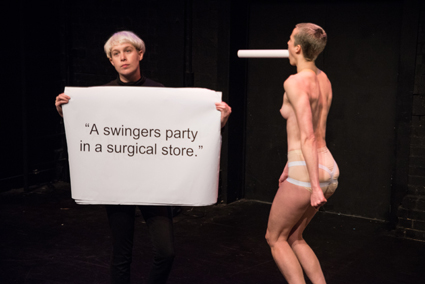
Lara Thoms, Liz Dunn, The Last Tuesday Society
photo Theresa Harrison
Lara Thoms, Liz Dunn, The Last Tuesday Society
The YouTube Comment Orchestra
By some coincidence, the first ever comment made on YouTube was just that: the word “interesting….” (followed by that infuriating four-dotted ellipsis). That’s if we’re to take as truth the delicious monologue that opens The Last Tuesday Society’s The YouTube Comment Orchestra. MC Richard Higgins walks us through the unexpectedly tortuous mystery of that first comment and its later disappearance, and the hilarious soliloquy is the perfect justification for a full 90 minutes dedicated to the truly bizarre phenomenon of online commentary.
What follows is a series of performances by a range of artists taking the notion of the online comment as a provocation. Last Tuesday co-creator Bron Batten herself enters into an online argument about a booty-shaking Nicki Minaj music video, interviews young people on the subject and finally presents an hilarious animal-suited dance routine. Post’s Mish Grigor delivers an art therapy experience that turns weirdly erotic and gently uncovers the role of power in the commenter’s relationship with her subject. Lara Thoms and Liz Dunn recreate notorious performance art videos and compare the responses of professional critics with those of confused or bemused online commenters.
These and other sequences don’t add up to any coherent thesis; the Society’s regular mission has always been to seek out polyphonic responses to a theme, rather than curating some kind of harmonic ensemble. There is a subversive overall effect to this otherwise light laughfest, however. Though we all know that a comments section is where good thoughts go to die, the comments themselves oddly emerge as the heroes of this work. For all the humour and odd-thinking these artists bring to the stage, many of the biggest laughs come from anonymous internet users mocking art in ways that are themselves wonderfully wry.
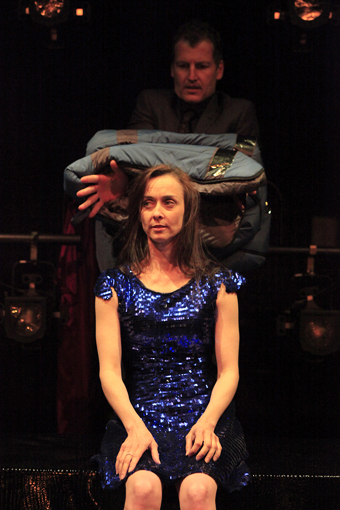
Michelle Ryan, Vincent Crowley, Intimacy, Torque Show
photo Rachel Roberts
Michelle Ryan, Vincent Crowley, Intimacy, Torque Show
Torque Show, Intimacy
Torque Show’s Intimacy is another work that draws much of its power from a real-world circumstance given creative treatment. Dancer Michelle Ryan was diagnosed with multiple sclerosis at age 30, and this work makes viscerally apparent the effects of the condition on the dancer’s own body. In solos and duets with Vincent Crowley, the exertion and focus Ryan requires in order to simply cross the traverse playing space is both painful to watch and impossible not to grasp. As with so many contemporary works that feature a performer with some kind of disability, this work is not ‘about’ that disability but also not able to exist without it.
Ryan relates humorous or dark dreams she may or may not have had; Emma Bathgate belts out sensational jazz numbers; duo Lavender vs Rose provide occasional accompaniment. The work, again, doesn’t necessarily add up to a coherent whole, but Ryan’s engaging presence and, especially, a number of stirring moments of what appears to be genuine intimacy are more than enough to keep this experience alive in the mind for some time to come.
Red Stitch Actors Theatre, Eurydice, writer Sarah Ruhl, director Luke Kerridge, performers Ngaire Dawn Fair, Olga Makeeva, Dion Mills, Johnathan Peck, Alexandra Aldrich, Sam Duncan, Alex Menglet, 3 Sept-4 Oct; Last Tuesday Society, The YouTube Comment Orchestra, co-curators, performers Richard Higgins, Bron Batten, performers Zoey Dawson, Nicola Gunn, Mish Grigor, Grit Theatre, The List Operators, Telia Nevile, Lara Thoms, Malthouse 17-27 Sept; Torque Show, Intimacy, by Michelle Ryan, Lavender v Rose, director, choreographer Ingrid Weisfelt with Ross Ganf, performers Michelle Ryan, Vincent Crowley, Emma Bathgate, Malthouse Theatre, Melbourne, 13-23 Aug
RealTime issue #123 Oct-Nov 2014 pg. 34
© John Bailey; for permission to reproduce apply to realtime@realtimearts.net
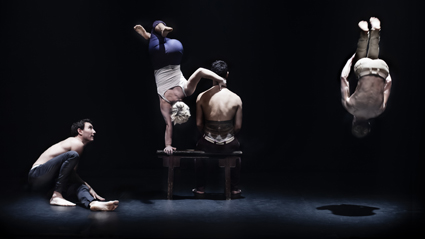
Casus, Finding the Silence, photo Sean Young, SYC Studios
The perilous follow-up to a smash hit is the subject of David Burton and Claire Christian’s new play Hedonism’s Second Album for La Boite Indie and the reality for Brisbane circus collective Casus (Emma Serjeant, Jesse Scott, Lachlan McAulay & Vincent Van Berkel). Finding the Silence is the latter’s follow-up to their internationally acclaimed Knee Deep and there was a palpable sense of anticipation at the Judith Wright Centre premiere.
Director and ensemble member Jesse Scott described the show as being about “that moment of inner silence before every trick…In that moment of solitude you are truly alive and aware, defying danger, fear, gravity.” Program notes can sometimes be abstruse or pretentious but in typical Casus understatement, these words sum up beautifully the experience of watching the show and its aesthetic of austere and vulnerable contemplation. Unlike the warm earth and honey tones of Knee Deep, Finding the Silence has clearly been infected by the white lights of hotel corridors, the low horizons of European winters and the craving for stillness in a ‘whirlwind’ of touring.
The work begins with a stripped-back stage, covered by a long rectangular training mat and a bank of lights to the right. Dan Carberry’s subtle score works underneath the action of the bodies, almost imperceptibly, resisting dramatic peaks and at key moments in the show almost falling away, like sound sometimes does when you close your eyes. You watch, engrossed as the flow of bodies passes before you, solo and duo mostly, with two or three climactic group routines that mark the half-way and then the endpoint of the show.
While founding Casus member Natano Fa’anana is sadly missed due to injury, newbie ensemble member Vincent Van Berkel maintains the intense, almost loving complicity that exists between each member of Casus. You feel like you are watching private moments as the tricks build from sequences on the mat to a bench and a gobsmacking aerial routine. There are blindfolds, cartwheels and spinning bodies. Yet somehow each extraordinary sequence, while it showcases a gently implacable strength from each of the performers, eschews the razzle-dazzle of ostentatious circus ‘stand and deliver’ tricks. The show felt to me like circus for circus-makers: complex, self-referential and tautly disciplined.
This is such a brave choice for that critical follow-up work. Casus has not sought to repeat a formula for success, to regurgitate Knee Deep in any discernible way. The sequences felt fresh and distinctive and this is the hallmark of true artistic risk-taking. While I suspect that Finding the Silence may not have the same popular appeal as Knee Deep it cements Casus’ place in Australian circus as a powerhouse of innovation, risk-taking and integrity.
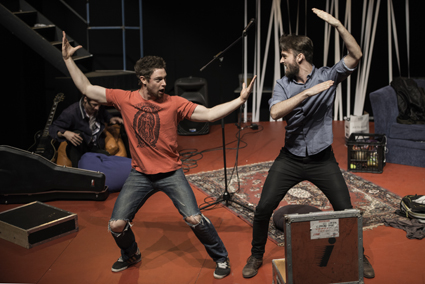
Hedonism’s Second Album, La Boite Indie
Another new powerhouse on the local Brisbane scene is the playwriting team of David Burton and Claire Christian. Hedonism’s Second Album follows Sumo, Chimney, Michael and Gareth and their rapacious band manager Charlie as she pushes them to pump out their second album in the space of a week to placate their furious record company after a recording of the band trashing the studio appears on the internet.
The show belts along at rapid-fire pace. Band members harangue, comfort, confess to and manipulate one another. The unreconstructed Australian male drummer, Sumo, steals the show with all the best lines and a surprising tenderness for his closeted band-mate, Michael, who is unable to break away from a violent relationship. Yet the other men, ostensibly less damaged, seem to evade deeper investigation. I think this is because the plot is driven largely by band clichés, aka the lead songwriter wants to go solo, the drummer isn’t good enough and the girl breaks up the band (almost). What lifts the work into something arresting is both the superb directorial work of Margi Brown Ash and the quality of the writing. Ash makes the bodies on stage seem one beast, moving, snarling, bouncing, holding each other with fierce intensity. This is matched by a vernacular that sounds like flat naturalism but is rich with a kind of generational cadence—an attack that exploits the vernacular of band grunge and pushes it into a dark poetry of masculinity in crisis. Both Finding the Silence and Hedonism’s Second Album were full-blooded works that confirmed the talent of their creative teams and their promising futures.
Casus, Finding the Silence, performer-creators Emma Serjeant, Jesse Scott, Lachlan McAuley, Vincent Van Berkel, director Jesse Scott, sound design Dan Carberry, lighting Rob Scott, Judith Wright Centre for Contemporary Arts, 15-23 Aug; La Boite Indie, Hedonism’s Second Album, writers David Burton, Claire Christian, director Margi Brown Ash, performers Patrick Dwyer, Gavin Edwards, Nicholas Gell, Thomas Hutchins, Ngoc Phan, designer Josh McIntosh, lighting Ben Hunt, La Boite, Brisbane, 13-30 Aug
RealTime issue #123 Oct-Nov 2014 pg. 35
© Kathryn Kelly; for permission to reproduce apply to realtime@realtimearts.net
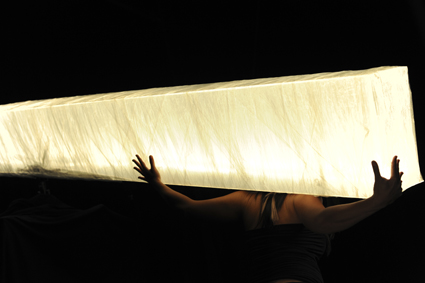
Jade Dewi Tyas Tunggal, Mantle, My Darling Patricia
photo Heidrun Löhr
Jade Dewi Tyas Tunggal, Mantle, My Darling Patricia
“What am I for?” asks the voice that has been speaking since we were first planted into a sustained, unsparing darkness. This voice has transported us from suburban mayhem—a few too many sherries in the car before forgotten veggies bake to burning, a glimmer of someone sick and dying, eyebrows plucked to vanishing—to the edges of an ominous hole in the road and down into its abyss.
The voice that we hear while we do not see paints us into a stock Australian domesticity. The ‘she’ who speaks in both third and first person is at once inside and outside of her own scene-making. She sounds dry and a bit ocker, as if she is, in part, the voice of nostalgia or even gendered myth itself.
Since the early 1990s when Jenny Kemp first dressed the Australian stage in what has since been called an externalised dynamics of the female psyche, the national theatre has wrestled with the knottedness of female experiences and narratives, myths about them and the limits and possibilities of an increasingly experimental non-narrative stage. In Kemp’s works, it was writing for and at the edge of performance that seemed to land a form that was both implicitly national and explicitly ‘female,’ offering a transformative spatial rendering of those post-structural fractured subjectivities whose ghosts we now know a little too well.
In Mantle, My Darling Patricia reveal a debt to this lineage but also aim to cast their own poetics into the readily twinned spaces of psyche and theatre. We never learn the name of our narrator, but her figure arrives in the shape-shifting movement episodes that visualise the plight of a woman who has been plunged to the centre of the Earth (Jade Dewi Tyas Tunggal). On the edge of visibility, her body writhes and twists, twitches gently, throbs and curves to varyingly thudding, sensuous and pulsating sound. In less effective scenes she is clambering against the scrim, acting out entrapment. In others, she seems seductively caught in the sort of ecstasy that might just come with freefalling grief.
If the figure’s movements shift undecidedly between the literal and the abstract, the speaking voice also jumps too neatly between a fictive elsewhere and the metaphor that renders it. Her story, we come to learn, is less about being enclosed in earth than it is about the kind of descent that occurs when the self is cut to its core by despair. As she appears and disappears, the stage invisibly moves around her—its objects also somewhat undecided, hovering ambiguously between symbol and substance. A large fluorescent ice beam appears out of nowhere, and then vanishes. A large black sphere casts a tall shadow of a hole, and then is gone. A cone enshrouds the woman’s body which by then is reaching tremulously towards a surface.
The components, individually, are interesting imaginings: text (Halcyon Macleod) is rhythmic; design (Clare Britton) is stark and vibrant. Both are often outdone by sound (Jack Prest) that radiates in and out of recognisability with moments of lonely jazz, a distorted car horn, a penetratingly dirty electric guitar. And yet, in moving us between the twin realms of this story—inside and out, fictive dream and fictive real—the artists contain us in a kind of pretense that, despite experiments in visual form, feels somewhat narratively closed. Jenny Kemp opened out the stage by playing with non-linear text and its relationship to an abstract and painterly mise-en-scéne. Twenty years later, Mantle doesn’t quite find a meta-theatrical language to sequel Kemp: the kind that could make those of us sitting in the dark alive to our own psychic imaginings, seeing and feeling the theatres in our minds.
My Darling Patricia, Mantle, co-creator, writer, narrator Halcyon Macleod, co-creator and images Clare Britton, lighting Matt Marshall, composition, sound design Jack Prest, performer, choreographer Jade Dewi Tyas Tunggal, dramaturg, script editor Janice Muller; Campbelltown Arts Centre, 11-13 Sept
RealTime issue #123 Oct-Nov 2014 pg. 36
© Bryoni Trezise; for permission to reproduce apply to realtime@realtimearts.net
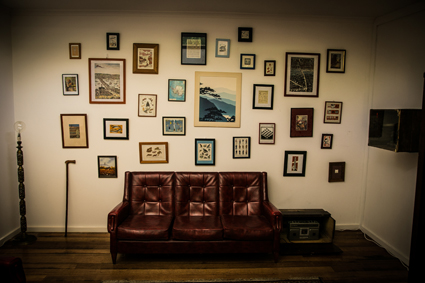
Escape Room Melbourne.
courtesy the artists
Escape Room Melbourne.
You’re in a bungalow at the back of a garden in suburban Melbourne. The game runner, who met you at the door and explained the experience you were about to have, locks the door behind you and the room is dim. You have torches and an hour to work out how to get out.
Escape Rooms are a new form of interactive entertainment in which participants are locked inside a room and must complete a series of puzzles and challenges in order to escape. Inspired by the digital Escape the Room games designed in 2005 by Toshimitsu Takagi, such as Crimson Room, real life versions of the game began to appear around 2007 including Takao Kato’s room in Japan and Kazuya Iwata’s room in the USA.
Escape Room Melbourne, run by Dr Ali Cheetham and Dr Owen Spear, was the first to open in Australia and since then new rooms have opened in Sydney, Perth and a second in Melbourne. Cheetham and Spear first encountered Escape Rooms in Budapest, where the form is so popular that over a hundred rooms have opened. Spear recalls, “Some of the rooms had an interesting, old nostalgic feel; others would be a little bit creepy and run down. It felt to me like being a kid again, exploring a room, trying to find a hidden object.”
Each Escape Room tends to be unique, expressing itself through the aesthetic choices of the designer, the kinds of challenges and the depth of narrative. The active puzzle-solving and teamwork elements can lend themselves to less nuanced purposing of the experience, of course, and there are many versions that lean heavily on genre—there’s no shortage of zombies and safe crackers in these rooms, be assured. The experience can also be lyrical, suspenseful and magical.
Escape Room Melbourne, for two-four people in a 70-minute session in a medium size room, has a quality of haunted suburban mystery to it. There is a sense that something urgent once occurred in this room. A letter gives the room its fictional context, laying out just enough exposition to give a narrative explanation for your presence in the room. Each puzzle and challenge has antiquity: the furniture, the objects, the clues, all come from a Melbourne long past. It’s a little like discovering that your grandparents were Cold War spies.
In this way the environment is made to perform around you. The sense of significance gradually focuses the longer you play. As you work out how the puzzles have been constructed around you, a grid of narrative meaning is layered over your physical experience. At the end it’s possible to trace your own experience through the room by following the path of solved puzzles.
Spear describes the participant experience of their Escape Room, saying “most people start off a little uneasy, and then really get into it once they’re in. There’s huge variety in the way people interact with the room. No team seems the same, and they range from speaking very little, and acting quite seriously, to screaming and laughing.”
A crucial aspect of Escape Room is the feedback mechanism that helps players move through the tasks. This varies from live in-character performances to no feedback at all. In the case of Escape Room Melbourne it’s a simple voice over. The Game Runner who let you into the room is also monitoring your progress as you play. If you need a clue you can ask for one. If the runner sees that you are very off-track or running out of time they will sometimes offer advice. Spear says, “I think they interrupt it slightly, but it’s sort of a necessity, otherwise the puzzles would have to be made too easy. We’re thinking of having a note system set up in the next one, where hints are sitting round the room in envelopes.”
Players are able to listen to the prompts in an ‘out of game’ framework which keeps the mechanics of the game very apparent without impacting on the immersive nature of the experience and lends it a sense of security. Other escape rooms are much more immersive, designing all their interactions as ‘In Game,’ which heightens the potential for immersion but demands more commitment to performing over playing.
Escape Rooms are part of the growing trend towards immersive and participatory experiences that includes work as diverse as that of Blast Theory, Punchdrunk, Slingshot and Coney (see my articles in RT115, and RT117). As Frank Lantz, director of the NYU Games Center, told CNBC, “Games used to be a form of experience. The thing that got left out of that equation was human bodies and face-to-face interaction. I think we’re seeing a return to those qualities.”
Escape Room Melbourne, book online: www.escaperoom.com.au
RealTime issue #123 Oct-Nov 2014 pg. 36
© Robert Reid; for permission to reproduce apply to realtime@realtimearts.net
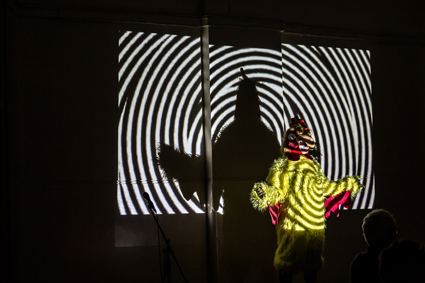
Use Your Illusion, Bron Batten
photo Bryony Jackson
Use Your Illusion, Bron Batten
Co-Curator of Melbourne’s eclectic Last Tuesday Society, Bron Batten, invited audiences into the dingily appropriate Collingwood Masonic Lodge in late August for her esoteric exploration of the art of hypnosis, Use Your Illusion. Supplied with voyeuristic pleasures, audience participation, cheese cubes and sliced kabana, spectators were drawn into a world of swinging pendulums and optical illusions; and equally, seduced by the mesmeric art of performance itself.
The venue’s somewhat clandestine side entry promises its own mysteries; entering the dimly-lit hall, three raised stages are apparent, the audience placed between them. We’re seated at large round tables dotted with tea-light candles and provisioned with the aforementioned snacks. A portrait of the young Queen Elizabeth II, muted to sepia over decades and too high for dusting, presides watchfully from the Lodge’s rear wall. On a side stage, Batten appears in a chicken suit, bathed in the light of a swirling, hypnotic spiral.
In a perhaps trance-inducing tone over spooky, meditative music, Batten gently, firmly and repeatedly issues her instructions: “You are going to enjoy the show immensely;” “Breathe deeply…let it all go;” “You will love me, you will love my show.” Her work done, the chicken exits. Next, there’s projected video of Batten on a couch, sobbing inconsolably, with a male (therapist’s?) voice crooning, “Take your time, Bron. We can wait till you’re ready.” But before we can become confused, it’s show time: pumping music, smoke and dancing laser-light draw us to the main stage where a now lamé-clad Batten reappears to introduce us to our ‘host’: professional hypnotist Charles Mercier.
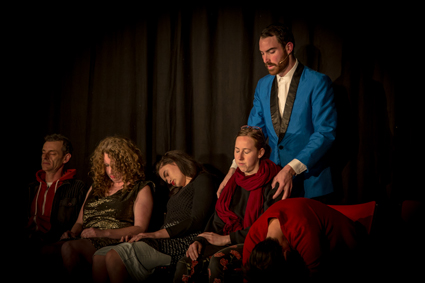
Use Your Illusion, Charles Mercier
photo Bryony Jackson
Use Your Illusion, Charles Mercier
The ensuing lengthy (and very funny) demonstration of auto-suggestive techniques—which Mercier tells us are really just permission to release one’s inhibitions—uncovers rich territories of voyeurism and vulnerability, blurring the real and unreal. Mercier delivers his explanations like a serious professional while gesturing like a cheesy showman. After bringing 10 audience volunteers onstage alongside Batten, he hypnotises his subjects, inducing them to perform simple scenarios. They respond in varying degrees to requests to ‘walk down stairs,’ ‘be in a tropical resort,’ ‘walk the catwalk’ and so on. In watching, we, of course, are mesmerised too, enslaved to a fascination that’s tinged with the discomfort of our own laughter, as we watch people just like us doing slightly embarrassing things for our amusement.
It’s all rather silly—some of the volunteers themselves slip out of ‘trance’ to giggle as Mercier ups the ante with increasingly awkward requests. Gradually the ‘least receptive’ volunteers are culled, and those remaining ‘perform’ each new action in a state that may or may not be actual, but is riveting to watch because it is so free. Mercier uses his showman’s commentary to implant deeper ideas: at one point he describes these uninhibited behaviours in terms of the power and love that we all have in our bodies. I forget myself completely in the pleasure of watching a middle-aged ‘hypnotee’ dance for us, radiant and projecting joy like a woman in love. It’s magical, and a privilege to watch, regardless of what has unlocked her freedom.
Finally, only Batten is left on the stage. Mercier presents a final challenge, inducing her to perform a particularly physically uncomfortable task. Watching, the audience becomes complicit in a vulnerability that none of us moves to prevent, exposing the flipside of the ‘hypnosis’ created by the stage/audience divide.
The rest of Use Your Illusion leaps from the heartfelt to the wacky to the arcane to the self-helpy, without ever allowing the audience the safety of knowing what’s truth and what’s playful deception. There are self-critical confessions and positive affirmations, another chicken in a suit and a further scene of hypnosis that leaves far behind the showman’s piercing eyes and flashy tux.
Throughout the show, and around the long, central ‘demonstration,’ Bron Batten manages to juggle disparate scenes and styles, held together by our collective attention. Cohesion seems secondary to exploration: the ‘devised’ nature of the work is writ large, and ideas float free with all the plurality and contradiction of the things in life that are just a bit mysterious. One minute the feeling is ‘Be who you are!’ and the next, I know we’ve been duped. And in the next, I find myself reflecting on performing and watching: on who we are, who we think we are, how we ‘perform ourselves’ and who we might be if we really just relaxed.
And then I also think: what if that chicken at the start actually DID hypnotise us into loving the show? How would we know?
Bron Batten, Use Your Illusion, performers/devisers Bron Batten, Charles Purcell, Ben Liston, Beth Sometimes, composer Edward Gould; Collingwood Masonic Lodge, Melbourne, 21–24 Aug
RealTime issue #123 Oct-Nov 2014 pg. 37
© Urszula Dawkins; for permission to reproduce apply to realtime@realtimearts.net
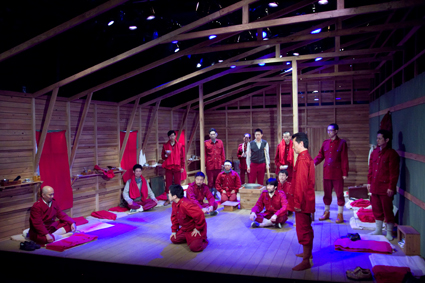
Cowra no Honcho Kaigi/Honchos Meeting in Cowra
photo Michihiro Furumoto
Cowra no Honcho Kaigi/Honchos Meeting in Cowra
Written and directed by prominent Japanese playwright Yoji Sakate, Honchos Meeting in Cowra sits within a post-WWII ‘small theatre’ tradition influenced by Chekhov and Ibsen as much as by Japanese Noh and Kyogen. The subject of this play is the Cowra breakout of August 1944 when 1,104 Japanese POWs escaped, 231 of whom were killed in the subsequent recapture, along with four Australians. The play’s focus is the redemption of identity and ‘face’ (or omote) by Japanese soldiers shamed by being captured. Hoping to be shot, the escapees possibly sought the means to die honourably by fighting or effectively committing suicide.
The play also looks to the contemporary context where the public in Japan remain misinformed of the effects of the recent Fukushima accident, unable to face the realities of that disaster.
The set represents a hut in the Cowra camp, replicating flimsy, fibro-thin walls (a pitched pine frame, joists exposed) with props such as tatami mats, toothbrushes, cups and forks and the bucket in which illicit sake is brewing. The details are significant, as we come to learn that this is actually a film set, part of an exercise where two contemporary, young Australian film students and their mentors from Australian and Japanese film schools are undertaking an ‘exercise’ to test their hypotheses as to why the POWS took the actions they did.
There are significant cross-cultural tensions, questions of honour and identity, the collective versus the individual, under investigation here. It is not just the POWs who suffer the effects of capture but also their relatives in Japan, who’d be subjected to extreme humiliation if it were known the men were captive. In many ways, this play is an attempt to understand, subvert and overwhelm that imperative. The final scene sees the young Australians urge the POWs to choose a different path from heading into suicide.
In this version of the story, the filmmakers being Australian smacks of Western imperialism, the superior, individualist, outsider view. The Tokyo original had these roles played by 15 young Japanese, which instead makes the questioning an inter-generational provocation. But within both conventions, the capacity to call ‘cut’ and have the final scene achieve a different outcome highlights the human capacity to create and remake different worlds.
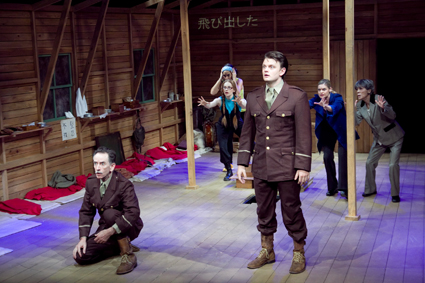
Cowra no Honcho Kaigi/Honchos Meeting in Cowra
photo Michihiro Furumoto
Cowra no Honcho Kaigi/Honchos Meeting in Cowra
The strongest part of the play, however—in both imaginings—is surely when the POWs indulge the students’ wishful thinking but suddenly enact their own ‘cut’ and return to ‘what really happened.’ The men’s sense of shame cannot realistically be changed. So the play’s form is both linear and spiral, winding into the vortex, out into a world of different possibilities and then back in again.
The play passes from rather clunky didactic scenes, which serve to fill in historical detail, to disciplined comedic routines which borrow from their condensed, sharply-realised characterisations rooted in Kyogen (the lads in the barn, passing time), and then to intensely moving final scenes which combine both the refined stillness of Noh drama with the psychological depth of character and soul-searching we associate more with Western theatre, such as when the former group leader Murata, converses with the film producer, thinking she is his ghost. He is unsure who he has become, being incarcerated for so long. The part is beautifully played by Takahiro Onishi, his conscience stirred like turbulence deep within a lake.
Similarly, the ballot scene, where each POW is clearly expected to cast the vote to die rather than choose to live, is finely realised, each approaching the ballot box with an enormous sense of dignity and conscience. One man casts a vote to live. The one who seemed weakest in resolve but votes to die shows the full weight of a society unable to reveal what it feels resting on his shoulders. He is horrified. There is, perhaps, no one to blame. His fabric—the fabric of them all—has been frayed.
The set is lofty rather than claustrophobic, and the lighting its weakest element, too stark to be the dream it seems for re-thinking an historical event. Then again, its sharpness keeps the play from becoming an enactment of ‘forgiving the past, which I think it is not. The physicalisation of the Australian actors (building on a previous exchange between Sakate and NIDA in 2004) emulates the discipline of the Japanese actors but is odd in comparison: not that the Australian cast is weaker, rather their presence does not emerge out of a centuries old, deep-rooted practice where words and hieratic movement have evolved together. The slapstick in earlier scenes is particularly odd, not quite matching the sense of chiselled caricature of the POWs (although Matthew Crosby comes close in his various characterisations).
The intoning of both Japanese and English texts is almost identical from one performance to another, as in a musical score. Perhaps the characters are indeed dreaming each other. In Cowra—perhaps too in Japan—nothing in fact remains of these men apart from their headstones marked with false names. Members of the public—several from Cowra, whom I met both in the Canberra and Sydney showings—seemed deeply touched by a production that reveals hidden worlds in both sides of the experience.
Cowra no Honcho Kaigi/Honchos Meeting in Cowra, writer, director Yoji Sakatem, design Jiro Shima, lighting Isao Takebayashi, sound Takeshi Shima, costume Nobumo Miyamoto, choreography Mikuni Yanaihara; Cowra Civic Centre, Street Theatre, Canberra, NIDA Parade Theatres, Sydney, 1-10 Aug
RealTime issue #123 Oct-Nov 2014 pg. 38
© Zsuzsanna Soboslay; for permission to reproduce apply to realtime@realtimearts.net
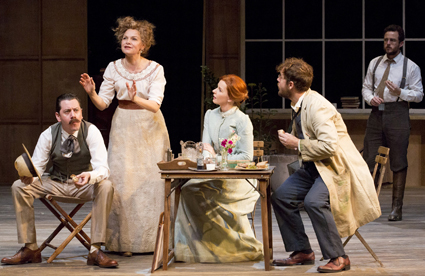
Hamish Michael, Justine Clarke, Jacqueline Mackenzie, Toby Truslove, Chris Ryan, Children of the Sun, Sydney Theatre Company
photo Brett Boardman
Hamish Michael, Justine Clarke, Jacqueline Mackenzie, Toby Truslove, Chris Ryan, Children of the Sun, Sydney Theatre Company
In a short period, Sydney Chamber Opera has presented Mayakovsky (p42) and Sydney Theatre Company Maxim Gorky’s Children of the Sun (1905). A generation older than the poet Mayakovsky, Gorky was at various times harassed and gaoled (he wrote Children of the Sun in prison) for fomenting revolution with his plays. Both poet and playwright became key cultural figures in the Russian Revolution and both were dispirited by Stalinism. Mayakovsky suicided in 1929, Gorky died in 1935 of natural causes at the time Stalin’s Terror was escalating.
Gorky’s playwriting is commonly considered structurally ungainly but rich in social observation and deft characterisations. Belvoir’s 2011 production The Business (RT104, p 18), an updated adaptation by Jonathan Gavin of Gorky’s grimly comic Vassa Zheleznova (1911)—a favourite of Stalin who saw it many times, presumably enjoying the agonies of a bourgeois family in their act of self-destruction (and the enforced changes to the play in 1935 to suit his tastes)—retained the playwright’s essential virtues, not least his strong focus on women. Coming into his stage career in the wake of his friend Anton Chekhov was certainly not an advantage and he was lambasted by left and right for lacking subtlety or political solutions. Subsequently the blend of humour and high drama in his best plays has been recognised indeed as Chekhovian but with political intent and a voice all its own.
Andrew Upton’s adaptation (originally for the Royal National Theatre, London production 2013) and Kip Williams’ direction of Children of the Sun realise the comedy-drama dynamic right to the play’s bitter end, our emotions and allegiances tossed about and our sense of the inevitability of revolution—with a self-preoccupied intelligentsia indifferent to a superstitious and violent peasantry—confirmed. While adhering in good part to Gorky’s dialogue, texturing it lightly with contemporary touches and the odd four letter word (these alarmed the British but are deftly integrated), Upton has very cleverly re-shaped the play. A few minor characters are deleted or merged, providing a tighter sense of community and, more significantly, key exchanges (like the estate owner and chemical scientist Protasov’s admonition of the worker Yegor for beating his wife) are held off in order to more effectively delineate character and control plot momentum.
The largest change, and the most effective, comes in the play’s fourth act, partly making the climax sparer but also re-ordering it and adding a final image, quietly inherent in the original but here writ large—the physical and emotional collapse of Protasov, unable to comprehend the fact and extent of his losses, his property burned by rioters who think he has poisoned them to procure business for the local doctors (whom they execute) and of his wife, the spirited Yelena who yearns for an artist’s life and will leave him. The riot is offstage which means we don’t get to see her shoot a peasant (this scene had a frightened audience scrambling for the exits in the volatile climate of 1906) after trying her best to help the locals manage what is in fact a cholera outbreak. Gun in hand, she heads off with everyone else to do battle while Protasov lingers helplessly, curling into himself, the epitome of the landowning class-cum-intelligentsia blind to its failings. It’s a powerful ending, and certainly an improvement.
The production is mounted on a large revolve on which the house is segmented, so that when rotated we see large rooms and small private spaces but also the construction behind, adding an appropriate sense of fragility as well as an excellent depth of field for witnessing comings and goings and frequent wanted and unwanted encounters. As in Chekhov, entrances and exits in the production are very telling, and here often funny.
Humour is everywhere from the very beginning, with a buzzing, argumentative household, bossy servants, Protasov and Yelena uselessly insisting on quiet. Protasov’s admirer, the wealthy widow Melaniya, courts him disastrously—climaxing in a humiliating egg-throwing scene and a subsequent confession to Yelena. The pompous artist Vageen (who hilariously wields the act of portrait drawing like a weapon) courts Yelena who is in turn grateful for the friendship while he assumes she loves him. Yelena’s frustration deepens, but her dilemma is nowhere as deep as her sister’s. Lisa is a fragile Cassandra. Her gory visions of mob violence, inspired by newspapers and rumour, are more prophetic than paranoid. Everyone cares for her, if not really listening, including the bitterly cynical Boris, the estranged brother of Melaniya who realises to his astonishment that he is in love with her. Lisa’s own like-minded realisation comes too late with tragic consequences. This dark strand is tautly woven with the comic stand-offs, everyday crises (a maid resigns) and revelations (a marriage has run its course).
Kip Williams’ direction is precise, fluent and finely graded, his ensemble performing as one. Toby Truslove’s wonderfully realised Protasov is self-centred, easily distracted and unconsciously funny, his arrogance disguised by his apparent affability and the ease with which he avoids or moves on from clashes—a state of denial which will deal him a pathetic end. Justine Clarke judiciously delineates Yelena’s growing sense of herself, one of the family but moving beyond it. Helen Thomson’s Melaniya is hilariously naïve and subsequently sadly wise, another fine transformation. Jacqueline Mackenzie’s portrayal of Lisa is richly detailed—ailing, analytical but volatile, trapped and tragic, but then resolute. Chris Ryan, Valerie Bader, Hamish Michael, Yuri Govich, Jay Laga’aia and Contessa Treffone all bring subtleties and insights to their roles.
What is truly bracing about Children of the Sun, is that in an era of deracinated adaptations, Gorky’s breadth of vision has been sustained—with all the complexities of class, work, ideas, progress and ignorance and their stressful interplay. The play calls to mind our challenged intelligentsia (as neoliberalism sucks the air out of thought), women still fighting for equality and the widespread validation of ignorance—it’s not peasant ignorance about science that hinders us today, incredibly it’s wealthy, educated climate change denialists and parents refusing their children inoculation thereby putting others as risk. I left Children of the Sun in equal parts exhilarated—by the wit and wisdom of the play and its production—and depressed, mindful of the huge gap opening up between rich and poor in the West to which so many are blind.
Sydney Theatre Company, Children of the Sun, writer Maxim Gorky, adaptation Andrew Upton, director Kip Williams, designer David Fleischer, costumes Renee Mulder, lighting Damien Cooper, composer, sound design Max Lyandvert; Drama Theatre, Sydney Opera House, 12 Sept-25 Oct
RealTime issue #123 Oct-Nov 2014 pg. 40
© Keith Gallasch; for permission to reproduce apply to realtime@realtimearts.net
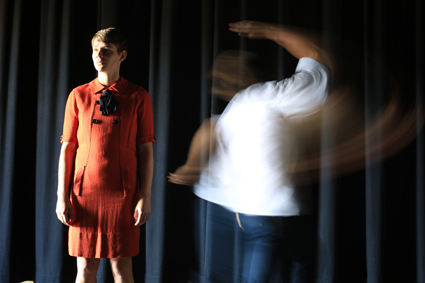
Miranda Wheen, Matt Cornell, Between Two & Zero
courtesy FORM Dance Projects
Miranda Wheen, Matt Cornell, Between Two & Zero
Miranda Wheen’s first work in this FORM triple bill, Safe Hands, is a short, cartoonish satirical take on demagoguery in which the initially suited dancer plays male-politician-as-celebrity—mutating from the crowd stirrer to a man-of-the-people mover (with excruciatingly protracted dancing and twitching to ironically selected rock and pop numbers) and, finally, the sportsman, pushing himself towards limits visibly beyond his reach but nonetheless wrapping (actually masking) himself victoriously in Australian icons (to “We don’t need another hero”).
It’s broadbrush commentary, but a reminder of how Tony Abbott (the suit, the blue tie; the hard hat, the safety vest; the army apparel; the bike, the water and any other challenge) has followed in the footsteps of John Howard (whose guises included the ‘RM Williams’ man on the land). The most striking image in this work has Wheen on all-fours convulsively dropping torso and abdomen floorward (to Janis Joplin’s “Cry Baby”), suggesting a masochistic dimension to the narcissistic power figure.
A more impressive work, Between Two and Zero, created in collaboration with co-performer Matt Cornell, is also an exercise in testing limits, this time in an initially delicate but soon assertively physical courtship. Informal party dancing is followed by cautious, almost courtly tracking of each other, her sudden, funny headfirst dash into him (desire as violence?) and a repeated series of tightly intimate face-to-face lifts which appear tortuously close to separating head from neck. This obsessive ritual is hauntingly realised in the dancers’ acuity of movement, physical strength and the dreamlike lighting transitions (Guy Harding) that increasingly close in the space around the pair. Wheen and Cornell reveal substantial choreographic potential, transforming an everyday universal into a very specific vision of the tangle that is coupling.
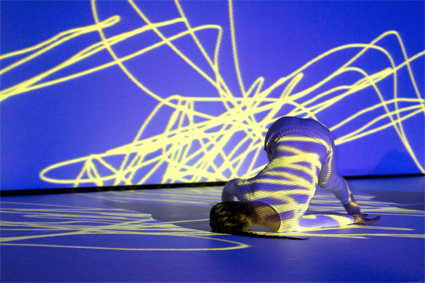
Sketch, Carl Sciberras (video still)
Carl Sciberras’ Sketch is an adventurous meeting of dance and digital artistry, bringing together a trio of dancers, composer Mitchell Mollison and visual artist Todd Fuller (both onstage), in which the latter alternately leads the dancers with his overhead-projected live sketches of body shapes into which they step, or accompanies them with richly coloured iPad finger swipes of increasing density, daring and complexity. The music is likewise responsive, crisply realised, nicely textured and more than a little evocative of the electronic music I grew up with in the 1960s—hard edged, metallic, static washes, shifting wavelengths and, finally in Sketch, great oceanic waves of sound.
There are several problems with Sketch. First, it is hugely overwrought: the not very interesting matching of sketched bodies and dancers and the much more fascinating digital brush-stroking of screen and the colouring-in of dancers are both far too long. Many good ideas are simply wasted. Second, the choreography, although adroitly and confidently realised, never breaks free of its formality, resulting in an unresolved dialectic between the dancing on the one hand and the freedom of expression of the sound and image collaborators on the other, especially the visual artist whose display of inventiveness appears limitless, eventually upstaging any attempt at dialogue or break-through synthesis. I treasured the few moments when the dancers appeared to take control of the imagery. Sketch is the potential from which a more succinctly powerful work might evolve.
FORM, Dance Bites 2014: Dance Makers’ Collective, Triple Bill: Safe Hands, choreographer, performer Miranda Wheen; Between Two & Zero, choreographers, performers Matt Cornell, Miranda Wheen; Sketch, choreographer Carl Sciberras, visual artist Todd Fuller, live composition Mitchell Mollison, performers Katina Olsen, Carl Sciberras, Rosslyn Wythes; Lennox Theatre, Riverside Parramatta, 11-13 Sept; http://form.org.au
RealTime issue #123 Oct-Nov 2014 pg. 28
© Keith Gallasch; for permission to reproduce apply to realtime@realtimearts.net
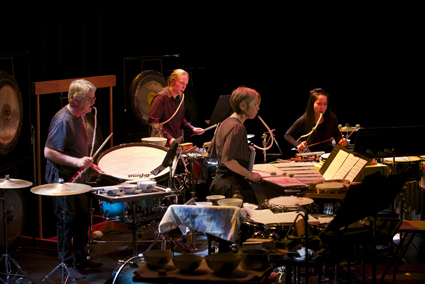
Early Warning System, Give us this Day—Five Sonic Adventures
photo Greg Harm
Early Warning System, Give us this Day—Five Sonic Adventures
Increased exposure to Indian, African and Asian music has made the last 100 years or so pretty good for Euro-Western percussion lovers. Enter Early Warning System with a beautifully programmed selection of recent works—by Erik Griswold, Vanessa Tomlinson, Kate Neal, Anthony Pateras and Michael Askill—that reflect the influence of that exposure on the Western classical tradition.
First up is the premiere of Erik Griswold’s Give us this day. The piece begins stately and processional (more Java than Bali) then moves through sections of quite different sonorities as is common with Griswold’s work. Not all percussive, at one stage Griswold’s much loved melodicas are introduced along with bowed cymbals to develop a beautiful tonespace of slowly overlapping chords. With the percussion the playing is sometimes soft and gentle, allowing the sound of touching skins with hand or beater to dominate the resonant boom of the drum, giving a percussion that is as much about touching and manipulating a surface as it is about dividing time into predictable chunks. Give us this day is very much a work that refines earlier concerns and demonstrates the continuing maturation of Griswold’s distinctive voice.
Vanessa Tomlinson continues exploring the theatre and physicality of sound production in her conceptual soundscape Static. The performers line up along the front of the stage each with a small table of bits and pieces and a bass drum at their feet. Electric static is soft in the air, the performers make soundless gestures—silent playing. Later these same gestures will be harder and faster, whipping sticks in the air, scraping shoe soles on the floor, scribbling with stones on steel bowls to bend and modulate pitch into speechless, gliding voice. Static is a fascinating work that draws attention to the link between gesture and the production of sound using commonplace actions.
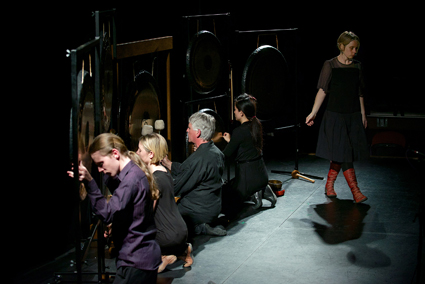
Early Warning System, Give us this Day—Five Sonic Adventures
photo Greg Harm
Early Warning System, Give us this Day—Five Sonic Adventures
Similarly performative is Kate Neal’s What Hath II, a Kraftwerk-does-Beckett piece of music theatre that presents the performers as slaves to the rhythm—moving their heads in rapid and unnatural gesture to the beat of the music or flashing small projectors in an inscrutable machinic code. The body driven by an external mechanism—in this case the tempo—echoes the long history of representing people as dehumanised functional components (Metropolis, The Matrix). Watching the dehumanised performers is unsettling, even a little embarrassing. Why? Drumming is expressed through ballistic control and group synchrony of that control creates solidarity, a sense of group membership arising through shared motor action. And where there is a group there is a leader. People identify leadership with the person who most predicts the behaviour of the group, and in this case the leader is a metronome, a machine.
The performers rigidly moving their heads to the metronomic tempo have no other purpose than to comply with a machine. But there is no coercion, the performers are compliant in their own subjugation. Watching people willingly give up their autonomy like this is embarrassing, upsetting, disturbing. Both here and elsewhere.
Early Warning System: Give us this Day—Five Sonic Adventures, performers Vanessa Tomlinson, Michael Askill, Nozomi Omote, Rebecca-Lloyd Jones, Cameron Kennedy; Visy Theatre, Brisbane Powerhouse, 9 July
RealTime issue #123 Oct-Nov 2014 pg. 42
© Greg Hooper; for permission to reproduce apply to realtime@realtimearts.net
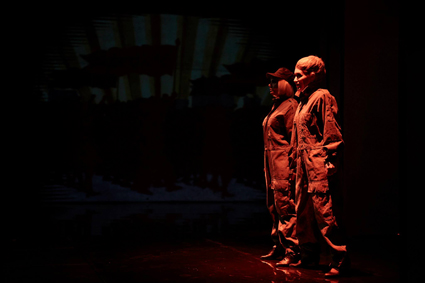
Mayakovsky, Sydney Chamber Opera
photo Zan Wimberley
Mayakovsky, Sydney Chamber Opera
In an evocation of the life of Vladimir Mayakovsky, composer Michael Smetanin, librettist Alison Croggon and Sydney Chamber Opera splinter the great Russian poet’s psyche into multiple voices (sung and spoken), personae and video images in a multimedia fantasia that belies the simplicity of the poet’s heroic public recitations, if not the complexity of his verse—at once populist and startlingly modernist before Soviet Realism erased every conceivable kind of formalism and many artists’ lives.
The dramatic structure of Michael Smetanin and Alison Croggon’s Mayakovsky is above all, as a fellow audience member quipped, “bio-pic.” It tracks key events of the poet’s life—his fame, a love affair, despair (political and romantic) and suicide, interwoven with appearances by Lenin, Stalin and agitprop revolutionary workers who delineate the narrowing political compass of the Russian Revolution. The chronological narrative is however framed as interplay between present and future, opening with Rorschach Test-like video projections and a grimly realised version of the Phosphorescent Woman from Mayakovsky’s satirical comedy The Bathhouse, in which she’s an emissary from a glorious Communist state a millennium hence. A more immediate future subsequently manifests in the form of the poet’s cynical alter ego, the Author, walking from the audience into Mayakovsky’s presence a century ago. The hectoring Author torments Mayakovsky with the failure of the revolution, the compromising of his art and his sanctification by Stalin as the Poet of the People. Once the latter acclamation would have meant almost everything to a poet, who regarded the practice of his arts as self-sacrifice for the greater good. But as conformism becomes the order of the day, Mayakovsky’s inordinate idealism is collapsing.
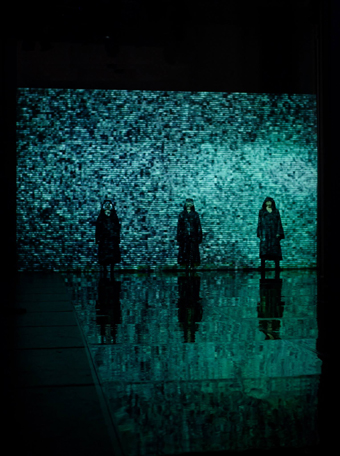
Mayakovsky, Sydney Chamber Opera
photo Zan Wimberley
Mayakovsky, Sydney Chamber Opera
The externalisation of the poet’s inner anxieties via an accusatory alter ego is a familiar device, which provides the opera with a certain amount of tension but inclines the Mayakovsky character towards the mono-dimensional, until the weight of his failures overwhelms him—even then it’s a bloody tussle with the Author. Baritone Simon Lobelson is a vocally powerful Mayakovsky—obtuse, strident, grandiose, suffering—but his role as the people’s poet is undercut by having the poems intimately voiced-over by Alex Menglet. It’s interesting to hear the Russian (while straining to read subtitles, right angled to the stage!) but I wanted to see Mayakovsky addressing the masses, with or without microphone or megaphone, in full voice (English would have been fine) and standing tall on the illuminated platform that Lenin and Stalin otherwise occupy. We also hear the voice of the actual Mayakovsky from a 1914 recording (which in extended, treated form is also used to structurally underpin the opera; see the interview with the composer, RealTime Profiler, 2 July).
The splitting of the man—into poet, Author, a Russian reciter and Mayakovsky himself as voice—might heighten our sense of the man’s contradictions and the pain they, the state and lover Lilya Brik (Jessica O’Donoghue) cause him but the fragmentation doesn’t necessarily add up. His character becomes diffuse regardless of Croggon and Smetanin’s considered working of his poems and phrases and images from them into the vocal score.
Mayakovsky’s enduring love for Lilya Brik (initially realised in a ménage a trois with her husband Osip Brik) was as impossible to fulfil as his political idealism and just as destructive. This dimension of the poet’s life is simply told, amusingly with “The Cloud in Trousers” as a courting song and affectingly when Lilya explains to him once more, here in urgent, rising notes that his passion exhausts her. She withdraws from him, as does the state. The combination of incredible neediness on the one hand and aggressive expressiveness on the other is associated with artists, but the suicidal outcome (one of several attempts) is extreme. Both drives demand emotional reciprocity, from a lover and from an audience—where the lover is also audience and the people bestow love. To the end Mayakovsky suffered as much for his love (too vast for a lover) as for his Cultural Bolshevik idealism (too singular, too personal for the state). With its structural mechanics focused on the latter, the opera’s diffusiveness denies us a cogent vision of Mayakovsky, however much his life defies a single view.
Alison Croggon’s libretto is in fine sync with Michael Smetanin’s score; together they capture the urgency of Mayakovsky’s declamatory verse and highlight its ever-surprising imagery. The music for the small but powerful instrumental ensemble with electronics is bracing, from opening monumental brassy thunder to static-challenged fanfare, revolutionary workers’ choruses (almost out of Brecht) and the final cataclysmic roar of radio waves and a lone siren’s lament. There are rarer, scintillating passages of quiet, subtly textured beauty. Early electronic music is evoked and the diverse musical forms that coalesced in the 20s are finely woven through the score without resorting to pastiche. The vocal scoring however was neither as subtle, varied or embracing, feeling less like song than hyper-articulated speech or latter-day recitative, as in much 20th century opera, with the orchestra filling out the lyricism and passion.
Mayakovsky suffered from a superfluity of theatrical and thematic devices, the sheer volume of surtitle reading and Kat Henry’s ultra busy conventional direction (with young opera actors grappling with an awkward mix of naturalistic and stylised moves). Hanna Sandgren’s design (six metre-wide drops suggestive of columns that become Stalin’s wall against art) doubled as a screen for a plethora of visual effects. The sculpture above made little sense—perhaps a nod in the direction of early Modernism or even Constructivism (which might have inspired a more cogent design). The decision to show the surtitles and video on a wall to the hard left of the audience reduced the work’s intelligibility and the impact of the Phosphorescent Woman who, above all, should have been addressing us directly as well as the characters onstage.
With Mayakovsky, Sydney Chamber Opera continues its brave commitment to 20th and 21st century opera. If design and direction are not of the company’s usual high standard, the opera will doubtless benefit from its first outing. It cries out for re-thinking by its creators and a less encumbered production. Smetanin and Croggon’s de-centred Mayakovsky doesn’t have the charisma that could enthral masses of workers. He is denied the introspection that would convey a tragic sense of self presaging the poet’s downfall. Instead, we have pathos rather than tragedy. Yes, the words, music and multimedia dynamics of the opera spell out Mayakovsky’s unresolvable plight with varying degrees of intensity and insight, but no more than that.
I can vividly recall the All Out Ensemble’s Selling Ourselves for Dinner in Jim Sharman’s 1982 Adelaide Festival. Performed in a carpark and scripted by another Cultural Bolshevik, Chris Barnett, it realised Mayakovsky’s spirit with frightening, almost overwhelming vigour and clarity, portraying an artist consumed by his art, politics and love. We soared with Mayakovsky, and we fell with him.
Sydney Chamber Opera & Carriageworks, Mayakovsky, composer Michael Smetanin, librettist Alison Croggon, conductor Jack Symonds, director Kat Henry performers Simon Lobelson, Jessica O’Donoghue, Sarah Toth, Lotte Betts-Dean, Mitchell Riley, Brenton Spiteri, design Hanna Sandgren, lighting Guy Harding, AV design, Davros, Carriageworks, Sydney, 28 July-2 Aug
RealTime issue #123 Oct-Nov 2014 pg. 42
© Keith Gallasch; for permission to reproduce apply to realtime@realtimearts.net
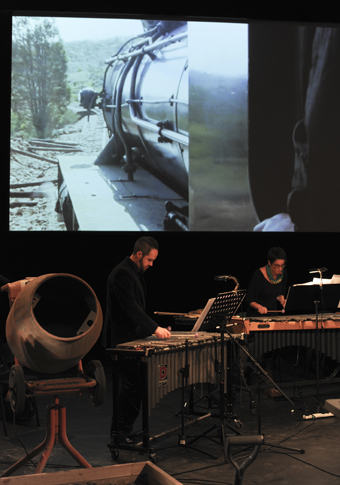
Eugene Ughetti, Claire Edwardes, Ghan Tracks
photo Heidrum Löhr
Eugene Ughetti, Claire Edwardes, Ghan Tracks
The Old Ghan, the train and the 3,000km of track on which it once ran, is almost mythical. It symbolises the Red Centre which Australia’s white colonists thought to harness and control. Its narrow-gauge tracks were first laid in 1878 and completed in 1929, the full track to Darwin only completed in 2004.
The train’s delivery of goods and passengers between Port August and Alice Springs (a seven day trip at best) fell foul of both the Wet and the Dry, the track regularly drowned in sand and/or water. In the late 1940s, there was a standard joke about when the train might arrive: this month, next month or December. Afghan cameleers not only distributed goods east and west of the track, but also stepped in when the train got bogged.
The train and its journey is a metaphor for white Australia’s long history of struggle to cross borders, join isolated towns and pretend Australians are ‘one people’ with a shared goal—to produce, to provide, to survive and to conquer. Jon Rose’s Ghan Tracks includes footage taken by Rose and Mark Patterson of the huffing, muscle-bound contemporary Pichi Richi Railway (the only part of the Afghan Express still operating) and the Old Ghan rusting in retirement, against archival footage of her heyday when she was a ‘slow silver ribbon’ with polished interior finishes and plush dining-cars.
Rose—an artist who has staged his work on, along or across boundaries such as fences dissecting the Strzelecki Desert, the USA-Mexico border and the Separation Fence in the Israeli Occupied Territories—excavates the romance, the struggles and the ironies of this mythology in a sound/performance/installation work involving seven musicians, a lighting artist, a sound technician and himself—a white-haired, hyper-charged piston engine driving the work through transitions by waving pieces of numbered, coloured paper at his orchestra.
Along with clarinet, tympanum, sousaphone, piccolo and corrugated iron, the ensemble also includes a rain machine harnessed by pedal-power and a canvas draped like pastry over a turning pin, which is wound like an oversized meat-mincer to create the sound of wind. Several times, Jennifer Torrence shovels gravel into a cement mixer, walks behind, turns the mixer, and then tips it out into the pit again. The steady dryness of this action, the brittle grind of the sound and the measure of Torrence’s footsteps is enthralling. This above all else serves as a synecdoche of the desert, of the hopes that people kept pinning on ‘good prospects’ and full crops (which all failed) north of the Goyder line, representing the gap between expansionist dreams and the moisture desperately longed for but which never returned. This dry truth is also echoed in the gap in tuning between the equal- and just-tempered vibraphones, to my eye matched also by the footage of coiffed women with slender fingers pointing to a dream outside the train window that we never get to see. Not quite visible or audible.
What I appreciate most is the delicacy in the use of film, a rhythmic/visual intervention appearing and disappearing in and out of score as do the instruments themselves. There are archival stills of Aboriginal children posed in stiff dresses beside sombre, starched white women, or taken on camel-rides by the Afghans. Another camel carries a pianola strapped to its back; where we might expect romantic keyboard tones, Rose overdubs the camel’s screaming song. A low POV shot, taken from the track itself as the Ghan passes over, is an apt symbol of obsession overrunning reason. Footage of the last run of the Old Ghan, pulling up its own tracks as it passes, like a spider eating its own young, is a sad homage to the folly of its past. As if we too could hoist up our limbs and say goodbye to dreams laid in sand.
Readings from old newspapers performed by Patrick Dickson and Lucy Bell capture the dashed hopes of the early settlers. The only strange element here is the full downlight on them, suggesting human superiority in the telling of this tale while the stage is otherwise discretely lit, spotting the curve of the sousaphone, the bell of the tympanum, the gleaming edge of the vibes.
Rose has been careful to document what the train meant to desert elders. A shot of the engine appearing like a caterpillar around the corner of a fat gravelly mountain is accompanied by a voiceover of Peter Paltharre Wallis telling the story of the black ‘devil dog’ eating up the ground. There follows a beautiful tract of Arrernte language, unmitigated and untranslated, holding its own.
Copious program notes unwind of Rose’s critical politics. Yet Ghan Tracks is a curiously conservative listening experience, its structure built on regular metre (appropriate, perhaps to the rhythmic forces of a train, but certainly not to the Old Ghan’s breakdowns!), albeit full of surprises and textures of which I value the reminder to take heed. The Ghan is less a radical take on the world around us than a reminder of the constancies of the battle between us and the environment, but yes, a cautionary tale (as Rose would have it) on how we may lay tracks into our future.
Ghan Tracks was commissioned by Ensemble Offspring in conjunction with Performance Space and with the support of ABC RN’s Creative Audio Unit.
–
Performance Space: Jon Rose, Ensemble Offspring, Ghan Tracks, composer, multi-media, texts, conductor Jon Rose, musicians Claire Edwardes, Clayton Thomas, Eugene Ughetti, Jennifer Torrence, Lamorna Nightingale, Jason Noble, Damien Ricketson, Carolyn Johns, actors Lucy Bell, Patrick Dickson, sound Lachlan Vercoe, lighting, AV Aaron Clarke; Carriageworks, Sydney, 7-9 Aug
RealTime issue #123 Oct-Nov 2014 pg. 43
© Zsuzsanna Soboslay; for permission to reproduce apply to realtime@realtimearts.net
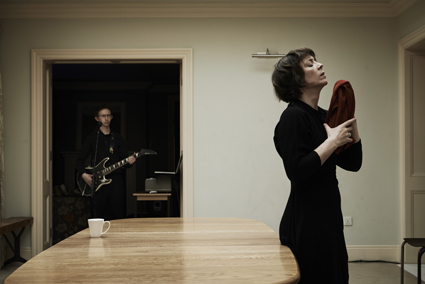
Tom Lane, Katherine O’Malley, Wake, Chamber Made Opera
photo Ros Kavanagh
Tom Lane, Katherine O’Malley, Wake, Chamber Made Opera
What looks like a coffin but sounds like a musical instrument? Rory Grubb’s original electric ceramophone, as seen in Chamber Made Opera’s Irish-Australian production Wake as part of Limerick City of Culture.
What first appears to be a rather macabre white coffin, funereally draped outside the back garden patio door of an exquisite Limerick family home, later reveals itself to be embedded with tuned ceramic pots and clever electronic components. The metaphoric significance of flowerpots embedded into a coffin is quite poignant, if you stop and think about it. But apparently that was all my own projection, as their functional raison d’être, invented by Grubb, who plays them, is genuinely acoustic.
That’s the thing about this open, subtle show—directed by Maeve Stone in association with an eclectic pantheon of collaborators—it offers space for the spectator to make his or her own associations, and is not at all pushy. It creeps up on you and suddenly you find yourself in its grip, all emotional, and wondering ‘how did that happen?’
When you set foot across the threshold of this dream home in South Circular Road, you are invited to take your shoes off and roam freely around the entire ground floor, to sink into the sofas, listen to the grand piano being played nonchalantly by Fionnuala Gygax, or hang out with the sombre Katherine O’Malley in her slo-mo sandwich making (you’ll be eating them later, as at any wake you have ever attended). Here, there are clever video projections, by the staircase, on the ceiling, in the media room, all by Australian Christie Stott. There, on the table in the drawing room is a pile of sympathy cards, all addressed to “The Ryan Family.”
We accompany the bereaved O’Malley on her thoughtful, pathos-imbued domestic preparations for a familiar ritual that is more than likely about to take place. It feels like being in a hyper-real movie at points. Even though as we wander around the beautiful home at our own volition, we wonder, is this it? Will anything happen? Grubb plays a bicycle wheel like a cello. Tom Lane dons his electric guitar.
In our own time, all 25 of us one by one take a seat around the large sandwich-making table and O’Malley, the woman of the house, executes a subtle choreography around and on top of it, sometimes catching it and shaking it. She locates a crumpled piece of paper with her personal, lowly uttered speech written out on it. Okay, she has to deliver this. Reluctantly, accompanied by a few bars from Lane on electric guitar, she articulates her fragmented few words about her mother, whom she had, she says, for 39 years of her life. The ceramophone kicks into action outside the window.
Then the bit we were all hoping would happen, to bring this poignant ritual to a close—we are offered sandwiches, whiskey and port.
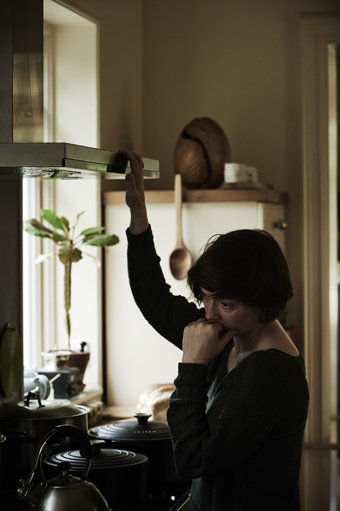
Katherine O’Malley, Wake, Chamber Made Opera
photo Ros Kavanagh
Katherine O’Malley, Wake, Chamber Made Opera
The eternal topic of death can be approached in a number of different ways. While over at the Galway International Arts Festival, the play Ballyturk is wowing crowds with a high-octane, frantic, hyper-charged Enda Walsh attack on the subject, here in a leafy Limerick suburb, Chamber Made Opera is adopting a subtle, less is more strategy to deal with the same unavoidable fact of our mortality.
The Australian company, imported by Limerick City of Culture to collaborate with an array of talented Irish artists, manifests its mission statement of re-inventing our bellowing, big-lunged impressions of what opera can be, with quirky little instruments, the unsaid, heartfelt mutterings and careful installations and interventions in an actual family home. Catch this gorgeous experience if you can.
This review originally appeared in the online magazine Vulgo and is reproduced with permission.
Limerick City of Culture Commission: Chamber Made Opera, Wake, concept, director Maeve Stone [IRE], concept John Rodgers [AUS], performer, choreographer Katherine O’Malley, composer, sound design Tom Lane [IRE], video design Christie Stott [AUS], dramaturg Tamara Saulwick [AUS], musician, sound design Roy Grubb [IRE]; Limerick, Ireland, 15-20 July
RealTime issue #123 Oct-Nov 2014 pg. 44
© Deirdre Mulrooney; for permission to reproduce apply to realtime@realtimearts.net
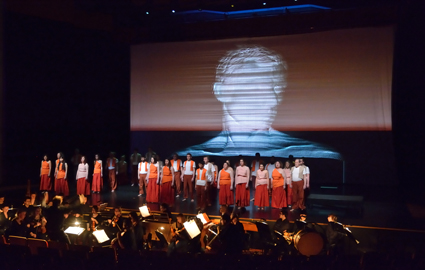
L’Orfeo
photo Peter Hislop
L’Orfeo
The story of this early (1607) opera is based on the mythic journey of Orpheus to the Underworld to retrieve the love he lost to snakebite on their wedding day. Orpheus’ divine music persuades Pluto to allow Eurydice to return with him to the human world, but Orpheus’ weakness has him look back to make sure she is following. He thus breaks the barter, and she disappears forever. The story represents music’s capacity to celebrate and persuade, reflect love and despair, and to struggle with human fallibility—as musicians daily do with their instruments. At the end, Apollo pities Orpheus’ compassion for suffering and raises him to the heavens.
Monteverdi’s opera, with its delicate Baroque vocal ornamentation, coupled with a restless continuo and peppered with harmonic discords, holds together these worlds of contradiction between human effort and transcendence. Although I’m not sure these delicate tensions are successfully realised in this production—a joint effort between national and international designers, specialist period instrumentalists and singers and the Research School of Astronomy & Astrophysics along with School of Music alumni and current students—it certainly has its achievements.
Conductor and Head of the School of Music Peter Tregear wanted the production to be “generation defeating” by virtue of its digital elements. Certainly, Llewellyn Hall packed in the younger crowds. A digital set is also “cost-effective, infinitely recyclable and already receiving interest from other productions overseas.” Indeed, there were gorgeous moments in Andrew Quinn’s design: when the ‘forest’ of columns bows to Orpheus’ arrival (a reference to Shakespeare’s Henry VIII where trees “did bow themselves when he did sing”); in the depiction of the journey across the river Styx, the boat a stunning row of shingles, sea-water shimmering below; and in Hades’ dark-plinthed mausoleum, which called to mind the ‘grief museums’ designed by Daniel Libeskind.
Perhaps if the oscillograph—a projection for the audience tracking the musical score, manipulated by the digital operator—could become more responsive to the actual dynamics of the orchestra, it would be a less plodding device. Even so, I’m not sure that ‘seeing’ the shape-of-music-made-literal really works. It begs the question of what we see in theatre’s ‘empty space.’ It’s the role of director and performers to realise just how active, engaged and relational it already is.
Despite Liz Lea’s sprightly choreography, Orpheus and Eurydice’s wedding is strangely unjoyous, although some of its sombre tone must be attributable to Allessandro Chiodo’s rather stark lighting design. Other key dramatic interactions were lost: for example, Orpheus’s Act III aria to the Ferryman does not seem sung to the space between the two of them—which surely it is: Charon is mesmerised and charmed by Orpheus’ desperate need to have him sleep, as much as by the song’s melodic contours. A key dramatic interaction is lost.
The diction of young graduates, Lachlan McIntyre and Nicholas Beecher, were exceptional, as were the vocal, dramatic and emotional power of Krystle Innes as the messenger of Eurydice’s death and Paul McMahon as Apollo. As for other title roles, the visuals projector was so loud that many times singers could hardly be heard. What a strain for such fine performers.
Chiodo’s lighting design is at its best in the Underworld scenes, where figures seem to float and emerge from the darkness—occasionally reminding me of Brian Thomson’s design for Britten’s Death in Venice for the Australian Opera in the 1990s, but the bright spotlight on Eurydice just when she is lost to Orpheus forevermore is very strange. There is also some awkward plotting at sensitive moments in Act III when tenor Nicholas Mulroy as Orpheus struggled to move cross-stage into patches of light, disrupting the superb poignancy of his aria. In the final scene, Apollo’s digitised ‘exploding star’ seemed gauche against the delicacy of the music.
The Baroque style is generally less rich than the more familiar Bel Canto, partly due to the nature of baroque instruments—thinner gut for strings and harpsichord, smaller reeds and bores for winds. But L’Orfeo’s richness comes from the tensions layered between the continuum motion of orchestral instruments and the plaintive qualities of voice expanded into expressive bouts of melisma. One singer confided that her training in jazz helped her meet the music’s demands. Like the quality of light and shade created by wind through leaves, Monteverdi’s melismas catch more emotion and nuance than any literal interpretation.
The ANU School of Music with the School of Art and the Research School of Astronomy & Astrophysics: L’Orfeo, composer, Claudio Monteverdi, libretto Alessandro Striggio, translation Anne Ridler, musical director Peter Tregear, director Cate Clelland, digital set Andrew Quinn, lighting Allessandro Chiodo, costumes Nadine Geary-James, Deul Seo, choreographer Liz Lea; Llewellyn Hall, ANU School of Music, Canberra, 21-22 Aug
RealTime issue #123 Oct-Nov 2014 pg. 45
© Zsuzsanna Soboslay; for permission to reproduce apply to realtime@realtimearts.net
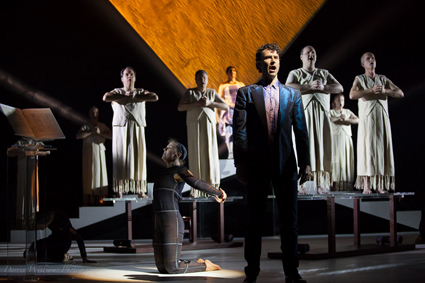
Philip Glass Trilogy, Akhnaten
photo Darren Williams, courtesy State Opera of SA
Philip Glass Trilogy, Akhnaten
Though considered radically experimental when first produced, Philip Glass’s early operas have become standard repertoire because of their enduring musical strength and originality. Glass’s initial three—Einstein on the Beach (co-written with director Robert Wilson and choreographer Lucinda Childs, 1976), Akhnaten (1980) and Satyagraha (1983)—form what he called a portrait trilogy, paying homage to significant figures: Einstein the physicist, Mahatma Gandhi the civil rights champion and Akhnaten, the Egyptian pharaoh who revolutionised religious belief during his reign, all legendary figures who have god-like status.
But these operas are not conventional theatrical stories—Einstein on the Beach is not a story at all, but a choral, instrumental and dance performance with spoken texts addressing contemporary society.
It was with Einstein on the Beach that Glass and Wilson broke new ground, introducing a unique kind of formalism into the territory of conservative opera culture. Wilson had previously created theatre pieces of many hours’ or even days’ duration, dissolving the barrier between theatre and life. Einstein on the Beach is intended to run four–five hours without a break, during which the audience can come and go. But in its 2014 production, State Opera SA breaks it into four discrete acts, each of 50 minutes, with intervals, while still retaining the five “knee plays” linking the four acts. State Opera has reinvented Einstein on the Beach, retaining its essential character while enabling a high level of concentrated performance by the dancers and singers. Importantly, it changes the dynamic for the audience, so that instead of the opera appearing as one long immersion with which you interact as you wish, you now focus on the four parts. The result is breathtakingly intense.
State Opera does not use the original set design. Nor is the violinist, the wonderful Carolyn Lam, who also doubles on keyboard, dressed as Einstein but is instead seated with the other musicians centre-stage—except when she briefly engages in a dance passage while playing. Thus we hear but don’t see the figure of Einstein. State Opera’s design is spare, emphasising the dancers and the music while reducing visual cues to essentials. The central visual feature is a huge floating black triangular form that hovers above the performers.
The highlight of the trilogy is dancer Rebecca Jones’ performance in Einstein on the Beach, superbly delivering the Supermarket speech while en pointe. Her exquisite execution of classical ballet moves is in startling contrast to her rumination on mundane urban life—she’s a creative soul searching for meaning. The choreography throughout Einstein is superb, as the dancers move around the stage in close proximity to the musicians, as if feeding off the music. The five musicians form a central visual element, as does Timothy Sexton’s conducting, which links all the movement on stage to the complex musical structure with mathematical precision.
The State Opera Chorus is the driving force in all three operas. Producing a peerless sound, their controlled, tireless repetition of Glass’s musical figures creates hypnotic rhythms, building a chant that overwhelms all other thought, as if music represents the laws of physics governing the universe. As the musical patterns repeat and mutate, we are reminded of the repeating behaviours that characterise life on Earth and its evolution. In Einstein, the chorus repeats the solfege scale or a series of numerals as if they are mantras. The three operas are meditations and an education in the appreciation of mathematical complexity rendered as music. Throughout the trilogy, Sexton directs both musicians and chorus, managing entrances and multiple rhythms. The musicians are superb, brilliantly rendering Glass’s music. Vocal soloists Adam Goodburn (an excellent Ghandi), Cherie Boogaart and Deborah Caddy are outstanding, all having roles in both Akhnaten and Satyagraha in the same week.
State Opera’s most significant move in producing this trilogy is in inviting choreographer Leigh Warren to direct. Dance is a central element of Einstein, and Warren also recreates Akhnaten and Satyagraha through some wonderful choreography. In Akhnaten, the black-clad dancers swirl around the white-robed chorus and the soloists who are in contemporary western clothes. The dancers appear as a life force, their vitality and suppleness contrasting the measured, ritualised movement of the soloists.
Again in Satyagraha (the word refers to non-violent protest), the dancers envelop the singers in movement representing turbulent human and cosmic forces, or they become crowds or mimic forms such as lotus flowers opening. The most conventional of the operas, Satyagraha is exquisitely slow. There is a narrative element but the music, the singing (in Sanskrit) and the dance overwhelm it—unlike the other two operas, there is no outline in the program notes, implicitly inviting us to treat Satyagraha as a visual and musical experience to be appreciated rather than a story to be understood.
While thematically the operas represent science, politics and religion, the overarching framework becomes religion, or rather a raised level of spiritual consciousness. Refraining from any didactic or evaluative position, the operas are a celebration of three ideal, heroic figures. This trilogy is the core of Glass’s oeuvre, and through their musical linking, the three operas appear as a single work that is greater than the sum of the parts. Staging the three so successfully is a huge achievement.
State Opera of SA, Philip Glass Trilogy: Akhnaten, Einstein on the Beach, Satyagraha, director, choreographer Leigh Warren, director, conductor, chorus master Tim Sexton, Leigh Warren Dancers, Adelaide College of the Arts Dance Ensemble, Members of the Adelaide Symphony Orchestra and Adelaide Art Orchestra, designer Mary Moore, lighting Geoff Cobham; Her Majesty’s Theatre, Adelaide, 5, 7, 9 Aug
RealTime issue #123 Oct-Nov 2014 pg. 46
© Chris Reid; for permission to reproduce apply to realtime@realtimearts.net
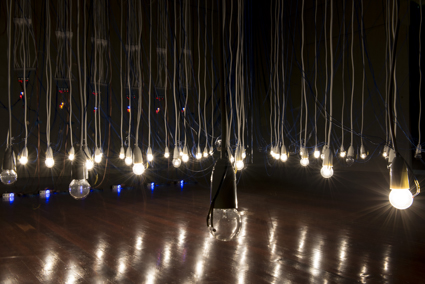
Matt Gingold, Filament Orkestra, 2014, What I See When I Look At Sound
photo Alessandro Bianchetti
Matt Gingold, Filament Orkestra, 2014, What I See When I Look At Sound
In Stanley Kubrick’s 1964 film Dr Strangelove a group of mad military men are hunkered down in an underground bunker watching missiles fly around the world. As with much of the most paranoid science fiction, this setting was based on fact, in a command centre buried under the mountains of Colorado that is designed to withstand a nuclear hit.
In an exhibition at the Perth Institute of Contemporary Art, Kynan Tan has created what looks like a contemporary version of this sort of bunker. We are immersed in darkness among screens animated by mute colours and thin lines. The biggest of these is a large, dual screen projection that flickers into a world map, upon which topographies and population statistics appear and disappear in a fantasy of total visibility.
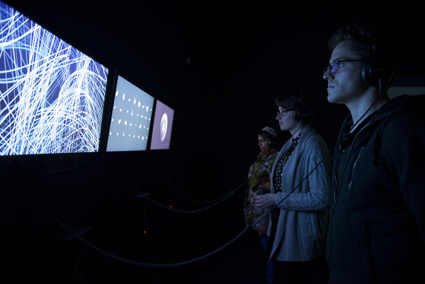
Kynan Tan, What I See When I Look At Sound
photo Alessandro Bianchetti
Kynan Tan, What I See When I Look At Sound
Tan’s is a deep space aesthetic, one enabled by the era of information, while using this data to reimagine the earth. Contour profiles and cameras on aircraft reveal terrain that is both alien and familiar, flattening our experience of the Earth only to render it in four dimensions once more. The installation would look good in a biennale somewhere, as it makes more than a metaphor for the globalisation of information, making us feel as if we are both inside the world and out of it, immersed and abstracted from the planet all at once.
As if to completely reverse the immersive effects of this information bunker the other works in the exhibition rely on more analogue ideas. Cat Hope creates a temple of low frequency out of a dangerous looking pile of bass guitars and dirty amplifiers. The volume knobs and the placement of the guitars is just right to produce a well of bass, its density and texture shifting as we move about the room.
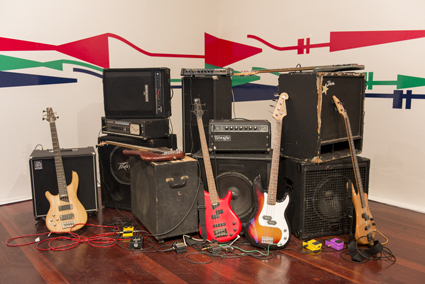
Cat Hope, What I See When I Look At Sound
photo Alessandro Bianchetti
Cat Hope, What I See When I Look At Sound
Hope creates a bunker of a different kind from Tan’s, but her piece also resonates strangely with the outside world, as it creates a highly tuned awareness of subsonic and low frequencies. After meditating on Hope’s strings, my ears and body were tuned to find bass wells everywhere, sites where low frequency sounds are trapped as they echo out of air conditioners and other ambient machines.
If Hope creates some kind of 1980s-style cyberpunk temple and ashram of bass, Lyndon Blue’s Altar harks back to a psychedelic era. He places an interactive Theremin in front of a trippy, warped projection so that putting your hand into the instrument’s field distorts old footage of airships exploding and crystals forming in a laboratory. Meanwhile the sound of tape wheezes back and forth, to create something akin to a bad trip watching the History Channel, when the bright colours go muddy at 3am.
The main PICA room is dedicated to two other installations. One by Lauren Brown features headphones that produce no sound, as if to deconstruct the whole exhibition. Brown alludes to sounds by writing a column of word-sounds under ultra-violet light, in a long poem to everyday listening.
The biggest single installation here is a dense and complex arrangement of light bulbs, electrical wires, radios and relays that runs as precisely as a toy train set. In Matthew Gingold’s Filament Orkestra bulbs switch on and off in different orders, triggered by sensors that are then hooked up to speakers that also hang from the ceiling.
With the passion of a technically gifted child, Gingold can play his instrument with an intuitive sense of how his abstract grid of light can be turned into a machine of beauty. His contraption is obsessive and strange, a steampunk factory designed to solve obscure riddles. Like a template for something greater than itself, Filament Orkestra looks like an experimental model that has yet to betray its true purpose.
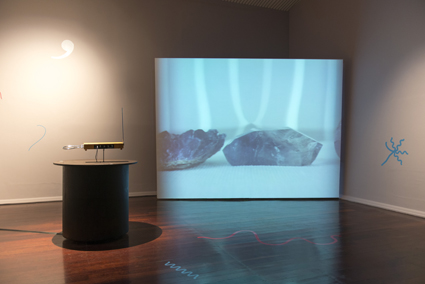
Lyndon Blue, Altar, What I See When I Look At Sound
photo Alessandro Bianchetti
Lyndon Blue, Altar, What I See When I Look At Sound
There is a sense of occasion around this exhibition, that marks a coming of age for a couple of Perth artists, Lyndon Blue and Kynan Tan, who have long been lingering in local universities. Blue is a local polymath who plays everything from big band jazz to neo-folk and krautrock, while Tan has been creating impressive experimental sound pieces for some time.
This exhibition proves Blue and Tan can work with bigger installation spaces, while Hope used the occasion to announce she is folding her improvisational bass project Abe Sada to play more with the compositionally focused Bass Orchestra. A book launched at PICA, titled The End of Abe Sada (PICA Press, 2014), testifies to this shifting scene of low frequency improvisation.
While all of these artists work with completely different technologies, they are unified by an obsessive interest in their materials. From a set of older machines, such as bass guitars and light bulbs to Tan’s synchronised immersions and Blue’s hypnotic and hallucinatory device, the exhibition is like a poem to bunkers in space and time, illuminating a will to make caves out of wires.
In utopian fiction, there are always two characters. The first is the visionary who inspires others with his ideas about changing the world, while the second is the tinkerer, who will get madly enthusiastic about the details. Each of these installations shifts between the two points of view, as its artists realise some grand idea but only through an obsessive-compulsive attention to detail.
The wires of Gingold’s light bulb system extending to the PICA ceiling, the ridiculous collection of bass guitars and the old school optical distortions of Blue’s psychic projection all testify to the madness of artists at work. They come together because each of them displays a certain eccentricity, an interest in fiddling with things when others would have lost interest.
The evidence—making things work, and showing them off—is something that is often lost when art is taken into bigger galleries. Here the banality of the materials, the evidence of an artist’s madness, pulls this exhibition into a tactile realm. The mediation of sound and vision takes place as we listen to switches and watch the vibration of strings.
What I See When I Look At Sound, curator Leigh Robb, Perth Institute of Contemporary Art, Perth, 12 July-31 Aug
RealTime issue #123 Oct-Nov 2014 pg. 47
© Darren Jorgensen; for permission to reproduce apply to realtime@realtimearts.net
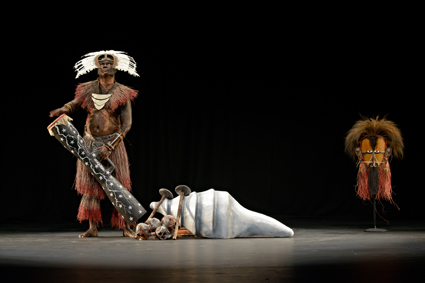
Alick Tipoti, Poeypiyam Angayk 2014, video
photo Mick Richards
Alick Tipoti, Poeypiyam Angayk 2014, video
Saltwater Country: Aboriginal and Torres Strait Islander art from the coastline, from the islands, from the beach. Places of tidal movement, silt deposition, cyclonic storms and fishing. A shoreline where people meet for the first time—perhaps in the expansion of empire or on holidays at Christmas.
Saltwater Country is social, with workshops into the Gold Coast community and Erub Island in the Torres Strait. Workshops funded through a chance meeting of one of the curators, Virginia Rigney, with Hal Morris, the CEO of the Gold Coast Waterways Authority at a talk Rigney was giving about architecture. (This being the Gold Coast the talk was held on a cruise boat.) Rigney pointed out the value of highlighting Indigenous knowledge and culture to build community engagement and the Authority came on board with funding for public programs including a five day artist camp on Stradbroke Island run by Judy Watson.
Stingrays snooze half buried in the sandy shallows all along the coast, leaving flat-loafed depressions that Watson has cast in bronze then set to float just above the gallery floor. She has also cast the detritus of the shoreline: turtle heads, kelp roots, fishing floats, chest bones. Drifting and detritus are themes for other artists as well—not surprisingly given the role of the ocean as both a slow medium for exchange and the world’s largest dump. Laurie Nilsen creates barbed wire cages for urban rubbish that finds it way from shop to trolley to car to the drains then to the mouth of the Brisbane River. Barbed wire—from his younger days as a fencer out towards Roma. Wire grew barbs in the 1870s during the colonisation of the range lands in the USA. The barbs hurt the cattle just enough so they won’t lean on the fences and break them. Country museums almost always have a small display of different types; there’s a surprising variety. It’s a strange metaphor, wrapping discarded packaging with the tool for dividing land into parcels.
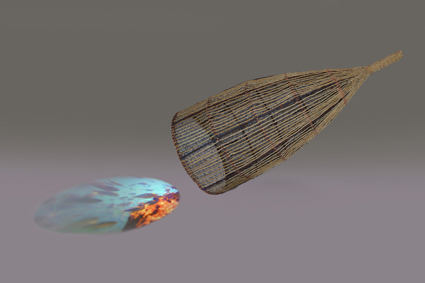
Erub Arts, GhostNet Weres 2014, installation,
photo Gold Coast City Gallery
Erub Arts, GhostNet Weres 2014, installation,
More drifting, more rubbish transformed. This time from way north. The Aru Islands are south from Papua. From here Willem Janszoon set off in the Duyfken in 1606 for the newly formed Dutch East India Company to become the first European to land in Australia, near Weipa. Nowadays maybe a fishing trawler heads out from Aru and a net gets tangled in a coral outcrop to be cut loose and drift away through the Arafura Sea. Six kilometres of plastic netting drifting along, a ghost net catching turtles for no-one then washing up on the beach at Erub Island in the Torres Strait. Erub Erwer Meta (Darnley Island Arts Centre) people take the net, free the turtles if they can, pull out the rubbish, pull apart the net, weave it into an oversized version of their traditional tool for scooping sardines in the shallows. For most people sardines come in a tin, from Portugal, Norway, Coles. For the people on Erub this is about who they are and have been, made into art and then traded to the mainland.
Also from the north is Alick Tipoti (see RealBlak, RT111) with a series of short videoed performances. Tipoti is best known for his linocuts but here we see his choreography and dance. The stage is dark and spare, the camera low, eye level for someone seated on the ground. Tipoti enters from the side, out of frame, out of darkness and into the light. He is dressed in what I take as traditional—long grass type skirt and leggings, arm bands, shell necklace and a mask that confronts the viewer with an unyielding, penetrating stare. Familiar items that can seem somewhat empty when viewed by someone with little personal cultural context in a museum but here they are transformative. It is a striking performance.
Saltwater Country next travels to the Australian Embassy in Washington and then to AAMU in Utrecht, a dedicated Museum of Contemporary Aboriginal Art set up by an ex-ambassador to Australia from the Netherlands. An exhibition traded across borders and across oceans to bring in the tourists and bring into being a binding chain of social relations.
And it is right that this exhibition starts at the Gold Coast, in a city that grew purely from the pleasures of the beach and at a venue originally called The Keith Hunt Community Entertainment and Arts Centre. Named after a-good-Labor-man who came up from Sydney in the 50s to run a snack bar on the Coast. Fish and Chips then local government. Years trying to get an arts centre off the ground. Became Mayor and the first civic leader in Australia to sign the petition calling for an Aboriginal Treaty. Front page news. 1981.
Saltwater Country, curators Virginia Rigney, Michael Aird, artists Vernon Ah Kee, Daniel Boyd, Michael Cook, Megan Cope, Erub Erwa Meta, Fiona Foley, Rosella Namok, Napolean Oui, Laurie Nilsen, Ryan Presley, Brian Robinson, Ken Thaiday, Alick Tipoti, Ian Waldron, Judy Watson, Gold Coast, City Gallery, 19 July-31 Aug
RealTime issue #123 Oct-Nov 2014 pg. 48
© Greg Hooper; for permission to reproduce apply to realtime@realtimearts.net
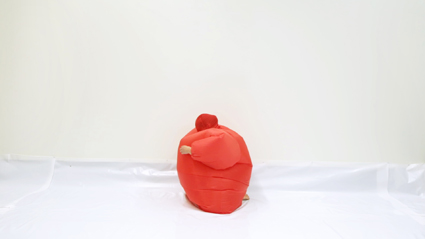
Cherine Fahd, Blown-Up, video still courtesy the artist
Strong political undercurrents rose to the surface in The Sceptical Image, an exhibition of 11 artists interested in unpicking the relationship between contemporary art and documentary practices. Offering new work by academic artists and researchers comprising the Art and the Document research cluster at Sydney College of the Arts, and presented in conjunction with The Image In Question conference, the exhibition sought to locate itself as a generative site for research.
The exhibition pursued a number of critically relevant threads and the politically charged nature of several of the artists’ practices was apparent such as Merilyn Fairskye’s MARCH on the annexation of the Crimea and Janelle Evans’ Eliza Fraser: The Blackening.
Spread across several spaces in the recently repurposed sculpture studios now home to the SCA Galleries, The Sceptical Image’s installation felt rabbit warren-ish in parts and was overshadowed by the vaulted architecture in others. The subtle potency of many of the works was not entirely lost however; Tanya Peterson’s Available Light conjured images of a bushfire smoke-obscured sun from an otherworldly sky. Taken at the start of Summer last year, these images captured nature in a state of imbalance. Peterson commented that on the same day she took them, Australia’s first ever request to activate the International Charter for Space and Major Disasters was made, allowing for satellite data and imagery of the bushfires to be received. Given that Peterson’s practice has been concerned with photography, light and the production of failure this coincidence seemed particularly apt.
On the opposite wall, Justin Trendall’s embroidered Helpless attempted to contravene images elevating industrial progress. Boldly disrupting the monumental modernist forms of factories, silos and skyscrapers using red thread, he undertook an act of resistance to their presence on the landscape and the interlinked economic system that drives them.
Drawing on industrial complexes of a different kind, Margaret Seymour’s Remote Sensing utilised an image of a National Security Agency surveillance compound made freely available by American artist Trevor Paglen. An iteration of her interactive Tracker robotic video works, Remote Sensing created an elusive experience for the viewer as it moved across the gallery floor, echoing the slippery and secretive way mass surveillance operates in today’s society.
Stefan Popescu’s engaging (un)identified contended with the speculative and the absurd as it highlighted the supposed concurrence of football and unidentified flying objects in Australia. His use of Tom Drury’s 1953 grainy UFO-capturing match footage (which has been called “the holy grail of Australian ufology”) served to destabilise not only the concept of truth in historical documentation but also notions of nation-building as they coalesce around male sports.
One of the most striking pieces was Blown-Up by Cherine Fahd. The twisted ‘selfie’ performance video challenged the viewer with the awkward political incorrectness of gazing at a person dancing in a fat suit. Blown-Up encapsulated the trajectory of humans looking at other humans—from Eadweard Muybridge’s early studies, politically contested images of prisoners and so-called degenerates, to reality TV and YouTube videos.
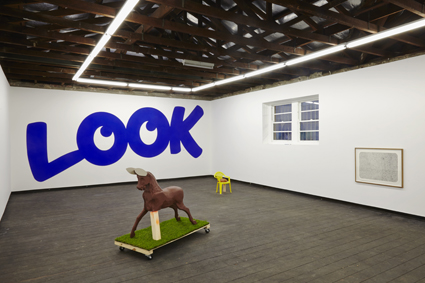
Kenzee Patterson, Bergie Seltzer, Firstdraft
Firstdraft: Bergie Seltzer
Across town at Firstdraft’s new space in Woolloomooloo, seven predominantly Sydney College of the Arts alumni presented the self-curated group exhibition, Bergie Seltzer. In contrast to the hodgepodge of works that can typify such endeavours, Bergie Seltzer was a well thought out, cohesive exhibition.
Borrowing from 20th century artistic tropes—pop, ready-made and text-based forms—and born from a shared appreciation of each other’s practices, the exhibition as a whole could be read as a conversation among artists, filled with witty one-liners and lines ripe to be read between.
While the title might have pointed towards the ‘thought bubble’ over the spoken word (bergie seltzer is the fizzing sound generated by trapped air being released from a melting iceberg), the exhibition elucidated matters of language and modes of communication through its inclusion of writing instruments, signage, advertising and broadcast content.
Due to their deft, interwoven arrangement in the space, many of the works entered a dialogue with one another. Playful tensions could be sensed however as the bright, colourful works vied for the viewer’s attention. Kenzee Patterson’s large wall text, Look, implored the viewer in deep Kleinean blue at the far end of the gallery behind Ben Terakes’ scatalogical Broken chair with poo and Frankensteined rocking horse after the late American artist Jason Rhoades. In front of this were two of the quieter, and possibly more nuanced, works in the show: Patterson’s Return to Form sculptures, a pair of sinuous ampersand forms teased out of a bar of galvanised steel reinforcement—a material prized for its rigidity and capacity to enable multi-storey construction.
Simpatico among the artists could be found in the adjacent room as Kevin Platt’s curly bracketed neon lips, Scripture/Cable Management, smiled benignly at Sean Rafferty’s suntanned plywood Fady Lingers (a word play on Lady Fingers and fruit and vegetable boxes) while in the opposite corner Will French’s bright yellow inflatable figure, an appropriated marketing character, rose with a kind of manic optimism and fell with a pathetic impotence.
In an exhibition that also celebrated materiality and process, French’s ink on paper TVSNOW took two years to complete. Produced while he was watching television, French painstakingly carved eucalyptus twigs into pixel shaped stamps and used their impressions to build a picture of screen static. Given that TV snow contains traces of cosmic radiation from the Big Bang more than 13 billion years ago, this work was a particularly poetic homage to the analogue signal as it fades from view in the digital age.
Echoing this, Emma White’s Waste of Potentia pondered the value of the individual gesture with a seemingly discarded pencil and eraser and a slight, pathos-filled sentence. “I was here” initially appeared to have been scrawled on the gallery wall by some anonymous vandal but, typical of White’s work, was an artistic facsimile laboriously rendered from polymer clay.
Both The Sceptical Image and Bergie Seltzer reinvigorate the at times facile discussions around artist-organised exhibitions and the sophisticated exchanges they have with one another about and through their work. As with icebergs there is always much more going on below the surface.
The Sceptical Image: Ryszard Dabek, John Di Stefano, Janelle Evans, Cherine Fahd, Merilyn Fairskye, Anne Ferran, Tanya Peterson, Stefan Popescu, Margaret Seymour, Yanai Toister and Justin Trendall, SCA Galleries, Sydney College of the Arts, Lilyfield, 2-30 Aug; Bergie Seltzer: Will French, Kevin Platt, Sean Rafferty, Kenzee Patterson, Kate Mitchell, Ben Terakes, Emma White, Firsdraft Gallery, Woolloomooloo, Sydney, 23 July-15 Aug
RealTime issue #123 Oct-Nov 2014 pg. 49
© Holly Williams; for permission to reproduce apply to realtime@realtimearts.net
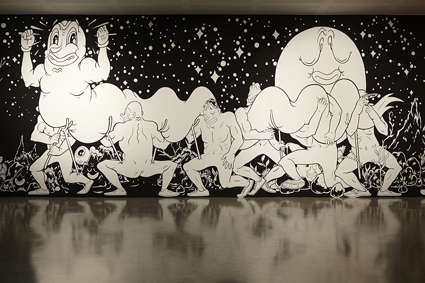
Uji Handoko Eko Saputro, Past/Present/Future, 2014
photo Zan Wimberly
Uji Handoko Eko Saputro, Past/Present/Future, 2014
Titled somewhat tongue-in-cheek with a reference to A-listers and celebrity culture, The List, at the Campbelltown Arts Centre gallery, is a youth-focused group show that ever so lightly sends itself up while investigating suburban politics and culture.
Famously and shamelessly Westie, on the outer reaches of Sydney’s suburban fringes, there’s only one train stop further than Campbelltown, and the freeway soon gives way to the open road to the ACT. In the tradition of humour celebrating a certain impoverishment, Tom Polo’s hand-painted billboards kick off the show and can only properly be seen in the Minto paddocks if you happen to be sitting on the right side of the train. As if in a stumbling, hesitant voice the billboards are spaced at quite a distance from each other: single words and brief phrases spell out “All I Know” “Is That” “We” “Just Keep” “Doubting” “Ourselves.” For a group exhibition targeted at local youth, Polo captures the tension between self-perceived limitations and the ludic tone of self-deprecation.
George Tillianakis worked with a group of seven or so teens on a horror flick which is shown across two video screens in the gallery. On the left, shot in negative, life in the ‘burbs is summed up as a group zombie walk. In long, tacky wigs like witches’ locks, the troupe makes its way across the park towards a sign saying, “No Access to Hospital.” On the opposite screen, in colour, various scenarios play out against a brick wall, a metaphor for “up against the wall” and “hitting your head against a brick wall.” A teenager on the floor has a fit while another uselessly “shines a light on” him with a torch, hardly likely to attract political attention. A tall figure dons a sheet with two peep-holes in reference to the local legend of Fisher’s Ghost, then folds it into a burqa in a gesture of cross-cultural solidarity.
Given that curator Megan Monte aimed to engage local youth from within the popular cultural frameworks through which youth perceive themselves, Tillianakis, raised in nearby Blacktown, admirably succeeds. There’s nothing high art, but rather B-movie horror informing this take on disenfranchised political reality (the no hospital access a comment on recent Federal budget cuts or general lack of services?). Tillianakis’ tone is light, not afraid to play out dark subject matter through teen antics of ‘acting stupid.’
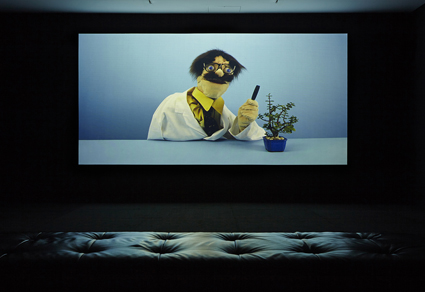
Robin Hungerford
photo Zan Wimberly
Robin Hungerford
Pilar Mata Dupont (see video interview, RealTime Profiler 4) placed the viewer on a sofa, under spotlights, to watch the horror show of contemporary political reality performed as a cheery musical with dance numbers and choruses: “We are the force that keeps us safe. You are missing documentation. I’m sorry you can’t get through. Please go to office for intrusive interview.” Robin Hungerford’s hand puppet scientist was as mad as Sesame Street, and in delirious conversation with a head in the sky straight out of The Wizard of Oz. As a comment on the dampening down of visionary thinkers, it soon became apparent that this scientist engaged in saving the world’s energy crisis needed to see a doctor and be locked away.
The dark political commentary eased somewhat in Uji Handoko Eko Saputro’s giant mural of a ghost, depicted as a long, heavy worm propped up Salvador Dali-style by naked footballers bearing crutches. In case you didn’t get the connection, a banner tells you the name of the local football team, “Campbelltown Rugby League Ghosts.” Additionally, a baseball cap on a plinth spells out the further association of Fisher’s Ghost with Campbelltown’s biggest art prize. (In the 1860s the ghost of a murdered local chap called Fisher apparently pointed out where to find his body.) However, a small figurine of Casper, the Friendly Ghost, also on a plinth, was needed, it seems, to boost the story with international comic book lingua franca, as if to say that even with the aid of football references local culture still needs help.
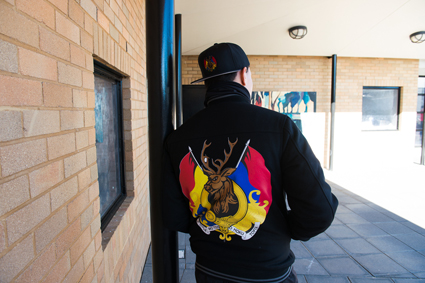
Zanny Begg,
photo Alex Wisser
Zanny Begg,
Zanny Begg moved beyond football and TV into what may be bleakly called local industry. In keeping with the times, and the proliferation of incarceration centres, her focus was on Indigenous youth filmed inside Reiby juvenile justice detention centre. Supplementary photographs showed boys alone, their backs turned, in their rooms, such that attention was on the identifiers on the walls: a patch saying ‘Koori Brothers 2014,’ another ‘Koori Family Boys,’ Adidas and heraldic blazonry adapted with Koori flag colours. The dominant video showed boys playing cards, riding bikes and walking around inside the enclosure, gang-like, in black handkerchief masks, like Jesse James. This was for legal reasons of anonymity but hinted at the outlaw activities that would have landed the boys in detention. With a deflated sense of the future the boys talked about life, dodging school and freedoms lost.
Michaela Gleave sealed viewers off from her installation. The audience had to look into the room through a glass panel, as if in the visiting room of a prison, in slightly unnerving resonance with the Zanny Begg work. Inside this plain and relatively empty room, again resonant with the rather empty cells of the Koori boys, was a pile of glitter and a vacuum cleaner, as if the fun had been cleaned up, held in abeyance for later. A series of what Deleuze would have called ‘order words’— or big abstract signifiers—was projected as if by random association, one after the other, on the back wall. These came from Gleave’s surveys of locals for the words which defined their lives. A selection read: Autonomy, Sacrifice, Commitment, Luck, Relationships, Economy, Realism, Conflict, Reliance, Respect, Persecution, Destruction, Togetherness, Happiness, Knowledge, Control. “Happiness” appeared more than once in this list sourced from a survey of locals. A further component invited viewers to don headphones and listen to a deep synth track while peering through the glass. This added an abject note to the installation, distancing and distracting the viewer from what mattered most.
Like Shaun Gladwell’s video installation, Gleave’s was a sobering work that referenced compromised opportunity and political reality. Recently back from Afghanistan and the practice of troop gifting to local people for political gain, Gladwell experimented with giving new skate decks to Campbelltown skate-boarders in exchange for appearing in his video. Less innocent than it seemed, skaters had to weigh up whether this was a fair exchange, and whether they were really being given something for nothing.
Campbelltown Arts Centre, The List, curator Megan Monte, artists Abdul Abdullah, Abdul-Rahman Abdullah, Zanny Begg, Kate Blackmore, Marvyn Gaye Chetwynd, Shaun Gladwell, Michaela Gleave, Uji Eko Saputro (aka Hahan), Robin Hungerford, Pilar Mata Dupont, Daniel McKewan, Tom Polo, George Tillianakis; Campbelltown Arts Centre Gallery, 9 Aug-12 October
RealTime issue #123 Oct-Nov 2014 pg. 50
© Ann Finnegan; for permission to reproduce apply to realtime@realtimearts.net
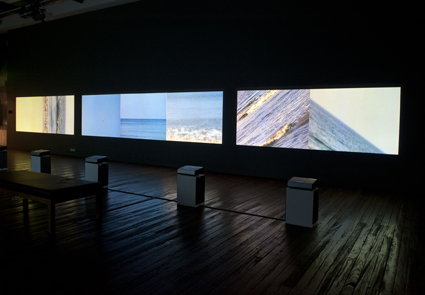
Jan Dibbetts, Horizon Sea I-III, 1971
photo Peter Morgan
Jan Dibbetts, Horizon Sea I-III, 1971
When RealTime talked with MAAP Director Kim Machan about the Land Sea Sky exhibition at the end of last year its 2014 international touring schedule looked ambitious—Shanghai, Seoul and Brisbane—particularly as the organisation had just been declined further triennial funding by Arts Queensland (see RT119). Despite this, Sydney has since been added to the list with a slightly smaller manifestation: 13 artists instead of the full complement of 20, exhibited across two floors of the National Art School Gallery.
Machan’s curatorial style grounds contemporary media-based works with the inclusion of a seminal historic work. For MAAP2004 in Singapore, themed Gravity, she used two works by Yves Klein—the magic of the collaged photograph Le Saut dans le vide (Leap into the Void) and the International Yves Klein blue series, presenting a hue similar to the blue channel of the RGB video signal—to re-assert continuity between visual arts history and the media art present (see our MAAP2004 festival feature). For Land Sea Sky she anchors the exhibition with Dutch artist Jan Dibbetts’ 1971 video series Horizon Sea I-III in which the meeting point of sea and sky is rotated in a number of orientations across split screens so that the landscape loses its figurative impact and becomes about line, angles and neat abstract geometries. Dibbets’ work thus reinforces both the land, sea and sky of the exhibition title as well as the sub-titular provocation to revisit “spatiality in video art.”
Positioned next to this work is a more contemporaneous version by Korean artist Kimsooja. For Bottari—Alfa Beach (2001) Kimsooja has filmed a stretch of sea and sky on the Nigerian coast, the place from which slaves were dispatched to the colonies. By splitting the screen horizontally and inverting the image in two ways—placing upturned sky on the bottom, and upside down sea on the top—the artist intends to negate the romantic ideal of a seascape. While the work certainly manifests an aura of gloom, this an instance where the artwork requires the roomsheet notes provided to convey its deeper import.
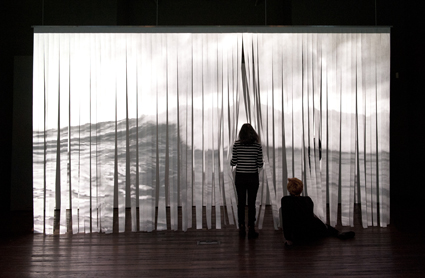
Derek Kreckler’s Littoral (2014)
photo Peter Morgan
Derek Kreckler’s Littoral (2014)
Also accompanying the Dibbets series is Australian artist Derek Kreckler’s Littoral (2014). Kreckler offers a low-tech approach to expanded video that is playful and effective. Projecting onto a wall-sized screen made from vertical strips, he presents three black and white sequences of wavescapes, each sequence increasing in closeness. Behind the strip-screen is an oscillating fan and the resultant billowing lends a remarkably satisfying three-dimensionality to the image, waves surging out towards the viewer. Kreckler undercuts the implied power and grandeur of the images with his gently comic use of a domestic fan. This, in addition to the strip-curtain allusion and the black and white of the image give Littoral a sense of nostalgia—the seascape often integral to Australian childhood perhaps.
Adding a little land to the watery second level of the exhibition is an understated piece by Shilpa Gupta. The artist asked 100 Indian adults to draw a map of India from memory.100 Hand drawn maps of India (2007-08) is simply what it is and something more. The highly variable outlines are down-projected onto a plinth resulting in a quietly powerful comment on ideas of identity, border and nationalism.
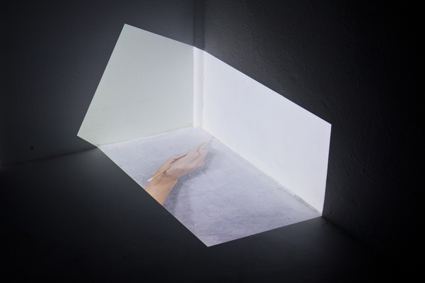
Zhu Jia, It’s Beyond my Control, 2014
photo Peter Morgan
Zhu Jia, It’s Beyond my Control, 2014
There is a nice resonance between Gupta’s piece and pioneering Chinese artist Zhu Jia’s It’s Beyond my Control (2014). His is also small and intimate, projected onto a small alcove at the top of the gallery’s impressive semi-circular staircase. Jia’s work most directly addresses the manipulation of spatiality in the video medium. It consists of a hand holding a pencil which is outlining the edges of the corner into/onto which it is projected, the joins between walls and floor. Here the virtual attempts to actualise and define, to demarcate the real world. While not quite flawless in execution—the projection is stretched to fit the corner (as the title implies, as part of a touring exhibition it is beyond Jia’s control)—it is still a very neat conceptual conceit.
Positioned near the gallery entrance—which unfortunately washes the vision with excess light—Barbara Campbell’s interactive close, close (2014) also deals figuratively with the Land Sea Sky thematic explored by second floor works. The viewer controls a horizontal image strip which moves up and down the screen according to your proximity. From the furthest distance you are offered a view of the sky and as you walk towards the screen the image moves downward displaying the tops of sails, a grassy sand dune and a strip of beach populated by birds. At the closest point you ‘enter’ the water, the sound implying submersion. Within the short video loop (filmed by Gary Warner who also contributed the sound) there is a strong dynamic that works effectively with the interactivity. When I played with the work at first there were birds on the shore but as I moved the image to the sky the flocks were on the move. As I brought the image back to the beach it was empty and I felt the loss. The very deftly managed visual and sonic interactivity (by John Tonkin) is perfectly integrated into the overall concept of the shifting territories of migratory shorebirds.
In Lauren Brincat’s This Time Tomorrow, Tempelhof (2011) we leave the sea behind to concentrate purely on land and sky—a strip of grey runway leading into a hazy distance. The perfect symmetrical perspective is reinforced by the mounting of the screen on a triangular frame. A figure walks into shot and down the centre of the runway to gradually become a black dot in the landscape. Near the end of the cycle, if you peer hard enough you see two distant figures emerging though we are denied the closure of their arrival. The work’s precise geometry and sense of shifting scale is mesmerising.
Other works on the ground floor offer more oblique though no less intriguing interpretations of the exhibition’s theme, concentrating more perhaps on the idea of spatiality of video and the frame as a landscape—such as Wang Peng’s Feel North Korea (2005) which uses the split screen with one part often blacked out to echo the political situation in this country. His second piece, Beyond (2014), is perhaps the most oblique, featuring three screens depicting subtley moving images of a pair shoes and a head of hair, both in extreme close-up. A shot of a distant aeroplane and vapour trail separates them, the connection to be read in the negative space between the screens. Wang Gonxin’s The Other Rule in Ping Pong (2014) splits the action of a bouncing ball across three screens one of which is embedded in a plinth in the space, implying a spatial and sculptural relation between the surfaces. Both Chinese/Australian artist Paul Bai’s Untitled (Wind charm) (2013) and Italian artist Giovanni Ozzola’s Garage—sometimes you can see much more (2009) use subtle manipulation of video footage to question perception of the image, the depicted space and the architecture of the gallery itself.
Kim Machan’s curatorial combination of figurative and conceptual makes Land Sea Sky a satisfyingly cohesive exhibition, a compelling showcase of Australian and Asian artists—something MAAP has consistently offered for over 15 years. May it continue to do so.
MAAP: Land Sea Sky: revisiting spatiality in video art, National Art School Gallery, Sydney, 21 Aug-11 Oct; http://www.maap.org.au/projects/landseasky-revisting-spatiality-in-video-art-sydney-australia/
RealTime issue #123 Oct-Nov 2014 pg. 52
© Gail Priest; for permission to reproduce apply to realtime@realtimearts.net
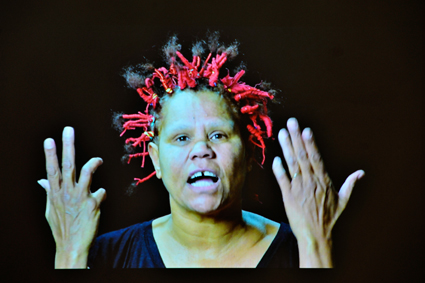
Faye Rosas Blanch, It’s so Hip to be BLAK, 2014
photo Denys Finney
Faye Rosas Blanch, It’s so Hip to be BLAK, 2014
Above Adelaide’s Fontanelle Gallery is a banner saying, “Occupied and Enjoyed.” The gallery is being occupied by a group of artists staging Bound and Unbound: Sovereign Acts—decolonising methodologies of the lived and spoken. As we arrive at the exhibition, attendants in lab coats ask us to sign a register—we are now under surveillance.
Bound and Unbound is a group exhibition of videos, texts, a ceiling-high stack of books, a field of red sand representing desert country, family photos and a representation of a traditional bush camp. But the key elements are the performances and the key issue is the exhibition’s agenda.
Performers Ali Gumillya Baker, Simone Ulalka Tur, Faye Rosas Blanche and Natalie Harkin are lecturers at Flinders University’s Yunggorendi First Nations Centre for Higher Education and Research, which provides support for Indigenous students at the university, engages in Indigenous research and education and is involved in communities of practice.
Bound and Unbound curator Baker also has her studio at Fontanelle. In the exhibition press release, she writes, “This experimental work aims to explore complex ideas of being both bound and free; what we are bound to historically and, as sovereign people, what we choose to (un)bind ourselves to and from, both now and into the future. The core themes include: interrogations of State colonial archives; notions of ethical practice and responsibility; enacting memory and storytelling; and sovereign identity and (re)representation.”
The performances are powerful and eloquent: Baker announces the exhibition’s aims; Yunggorendi Director Simone Ulalka Tur sings, accompanied by her niece Katie Inawantji Morrison on violin, and reads her mother’s poetry. Poet Natalie Harkin pastes up a text on the wall that reads, “Attention record keepers of the State we have you under surveillance!” referring to the surveillance of Indigenous people during South Australia’s colonial history and the retention of records of Indigenous communities held in the State Archives. Baker tells me that she needed written permission to access her family’s records, having had to sign a confidentiality agreement, and that Indigenous South Australians still feel under surveillance as if outside the community. Her video Archive Fever Paradox, of a performance by Harkin, also addresses the issue of the Archives, and her video of Tur and Blanche’s My Pen is My Weapon announces the group’s philosophy.
The family photographs recall and honour ancestors. The books in the stack are anthropological texts concerning the habits and nature of Indigenous people and their history. Baker declares these books racist; the artists’ intention is to address what has been written about Indigenous people in order to reclaim their history, change the way in which Indigenous people are understood and to re-present themselves. She cites Judith Butler’s concept of subjection and the process of becoming a subject of power as indicative of the colonial past and notes that Indigenous people are still defined racially. Their artwork is about how representations of Indigenous people still shape the lives of these people and our perceptions of them.
This is activist, community art. When viewers at the exhibition register on entry, they will subconsciously identify as Indigenous or otherwise and implicitly are asked whether they are in solidarity. The group demands decolonisation, reclaims Indigenous sovereignty and seeks mutual respect, inclusion and understanding. Indigenous people in SA lived under the Aborigines Act and this exhibition represents a symbolic emergence from it — to become unbound.
Baker and Tur tell me they are undertaking an educative process that is intended to complement their roles as lecturers at Yunggorendi. They teach Indigenous culture to non-indigenous university students and the artistic material they have developed will be used in their teaching. Using Fontanelle for the exhibition allows them to step outside their university roles and to develop their art in a space that supports experimental and interdisciplinary artwork. They use the space to promote dialogue between cultures and across art forms—theatre, installation, video, poetry—and they are interested in how experimental art might be used, citing as influences Richard Bell and the proppaNOW collective. It is a transforming experience for the artists themselves—they are undertaking PhDs and will use this experience in thinking through their research.
Bound and Unbound is described as Act 1 in a project that is planned to continue into 2015 with the production of further videos and possibly street art in key locations. It forms part of a broader project including the Tall Ships performance (recorded on video by Baker) at the opening of the Historia group exhibition, Adelaide Town Hall, earlier this year, which reconsidered Adelaide’s history.
Bound and Unbound: Sovereign Acts—decolonising methodologies of the lived and spoken, Ali Gumillya Baker (curator), Simone Ulalka Tur, Faye Rosas Blanch, Natalie Harkin, Fontanelle Gallery, Adelaide, 24 Aug-21 Sept
RealTime issue #123 Oct-Nov 2014 pg. 53
© Chris Reid; for permission to reproduce apply to realtime@realtimearts.net
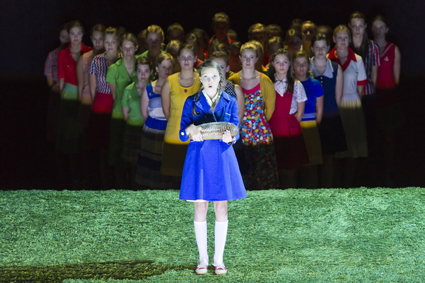
When the Mountain Changed Its Clothing, Heiner Goebbels, Melbourne International Arts Festival
photo Wonge Bergmann for the Ruhrtriennale.
When the Mountain Changed Its Clothing, Heiner Goebbels, Melbourne International Arts Festival
If you’re wondering what choices to make for the 2014 Melbourne International Arts Festival, there are several major productions that might take you out of yourself, or deep inside, as the best art does: Heiner Goebbels’ When the Mountain Changed Its Clothing; Trisha Brown, From All Angles and Chunky Move’s Complexity of Belonging.
These should be seen alongside the festival’s expansive circus program, Dewey Dell’s Marzo (from the progeny of Italy’s Castellucci family) and Roslyn Oades’ Hello, Goodbye & Happy Birthday (see Caroline Wake’s interview with Oades), and there’s much else to experience.
Heiner Goebbels, When the Mountain Changed Its Clothing
Master theatre maker Heiner Goebbels has been a recurrent guest of Australia’s international arts festivals, always surprising us with large-scale works with strong musical foundations, exquisite design and a mind-bending theatrical sensibility. The visits commenced with Black on White, with Ensemble Modern (Adelaide, 1998), Max Black (Adelaide, 2000), Surrogate Cities (Queensland Music Festival, 2003), Stifters Dinge (Melbourne, 2010) and Eraritjaritjaka (Sydney 2013), the latter featuring a very brave string quartet, an actor reciting phrases from the work of Elias Canetti in a dissociative meditation, and, as ever, magical design. Goebbels’ design, collaboratively created, often has the stand-alone quality of an installation, not least in the performative but performer-less Stifters Dinge. We can expect nothing less than immersion in a strange world in the 2012 production When The Mountain Changed Its Clothing with its oscillation between a functional everyday and a vivid truth-telling fantasy world.
The title, drawing on a Slovenian folk song, refers to the changing of the seasons, which provides the work with both its structure and an analogy with the transitional Twilight Zone of adolescence, realised in performance by 40 girls between the ages of 11 and 20—Vocal Theatre Carmina Slovenica. These young people come from a region which has endured great social and political upheaval, reflected in Goebbels’ choice of music (indie pop, folk, propaganda and choral works), the games these young women play and diverse texts. Shirley Apthorp writes in the UK Financial Review (27 Sept, 2012), “Two teenage girls, their faces calm as a Vermeer portrait, disembowel stuffed toys with dispassionate precision as they recite Gertrude Stein’s views on the rich, the poor and the very poor. Then younger girls take the teddy-bear innards and make them float like clouds over a plastic lawn.”
As revelations about the appalling extent of child abuse escalate an increasing number of films and stage works attempt to provide insight into young lives (What Maisie Knew, Boyhood, We’re the Best) or give them the stage as in Belgium’s Ontroerend Goed’s Once and For All We’re Gonna Tell You Who We Are So Shut Up And Listen (Melbourne, Sydney, Aug 2009) and Teenage Riot (Melbourne Festival, 2013). Of course not a few Australian young people’s theatre groups have consistently worked this territory. Will When The Mountain Changed Its Clothing be an adult reverie about childhood or give its performers, so powerful in song, credence in their own right—or bring adolescent and adult together in revealing collaboration?
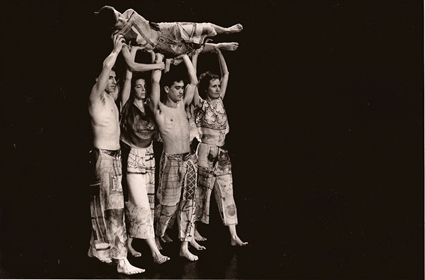
Trisha Brown Company, Set & Reset
photo John Waite
Trisha Brown Company, Set & Reset
Trisha Brown: From All Angles
This series of works, talks and films from the career of a major and highly innovative figure in 20th century American dance is a Melbourne Festival centrepiece. Acclaimed for her design sensibility, intelligence and wit, choreographer Trisha Brown was one of the artists from various practices who gathered and collaborated at the Judson Memorial Church in the early 1960s, fomenting postmodern dance—anti-theatrical, non-narrative, improvisational and rooted in everyday movement. In the 70s Brown created works in which harnessed dancers walked along walls, that were performed on rooftops or operated according to game rules, mathematical sets or cellular imperatives—patterned creations that generated mobile spatial design from human movement and mostly danced without music, until 1983.
Since then, in theatre works of larger scale and design, Brown has deployed the music of Bach, Webern, Schubert, Robert Ashley and Laurie Anderson (the exhilarating Set & Reset of 1983 which you’ll see in the festival and can preview on YouTube), as well as jazz and opera. Brown’s choreography, although meticulously phrased and making unusual demands on the body (and her own in solos), continues to magically flow out of stillness or walking with an ease that defies the effort applied.
Trisha Brown: From All Angles is a once only opportunity to immerse yourself in the dance works and thinking of a great artist. In the two programs titled Pure Movement, nine works from 1978-1994, including Set & Reset, will be performed, accompanied by pre- and post show discussions. Another nine works, 1970-73, will appear in the Early Works program and nine films, including a 72-minute interview with Brown, will further extend our appreciation of the artist’s body of work. Brown retired from her company in 2011; these Melbourne Festival performances are part of the Trisha Brown Company’s farewell tour led by Associate Artistic Director Carolyn Lucas who has been with the company since 1984 and, as a dancer, originated key roles in Brown’s body of work.
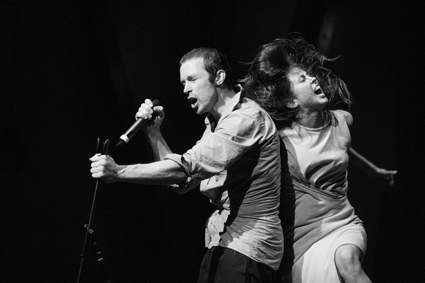
Stephen Phillips and Lauren Langlois, Complexity of Belonging, Chunky Move
photo Sarah Walker
Stephen Phillips and Lauren Langlois, Complexity of Belonging, Chunky Move
Chunky Move, Complexity of Belonging
In the beginning, the internet was heralded as utopian, a promulgator of democracy and a simplifier of just about everything. Quickly appropriated by extant and emergent commercial interests—some of them, like Google, born of the internet itself—the global online networking system has yielded increased totalitarian control (in democracies and dictatorships alike) and an illusion of freedom (to have your privacy invaded and identity stolen). Life has become more complex. Chunky Move’s new work Complexity of Belonging tackles the issue head-on: “a theatrical exposé into the daily trials of surviving in a hyper-connected, hyper-sensitive, globalised society” (press release). The work focuses on nine figures (a mix of actors and dancers) and their sense of identity, in terms of nationality, gender, sexuality and history. Leading German playwright Falk Richter (writing here in English) and also the director of this production, has drawn on the lives of the performers, but they will not be playing themselves. Typically his writing borders on the surreal while being bluntly and sometimes satirically political.
But Complexity of Belonging is not a play. It is choreographed and co-created by Chunky Move’s artistic director, the Belgian Anouk van Dijk, in her fifth collaboration with Richter (the others are Nothing Hurts [1999], TRUST [2009, PROTECT ME [2010] and Rausch [2012]). Nor is it a dance work, or dance theatre. When Virginia Baxter and I saw the Richter-van Dijk Trust at the Schaubühne in Berlin in 2009 (a last minute invitation and following a rushed reading of half the inhouse English translation before entering the theatre) we were swept away by the theatre-dance synthesis, the work seamlessly slipping in and out of and merging dance and theatre. As Richter has said of the collaboration, “We were experimenting on a new art form,” in which words and movement have the same weight, where a naturalistic movement becomes dance, or words spring into telling physical shape.
In an interview for the Goethe Institut, van Dijk explains the partnership with Richter: “We share a strong interest in communicating energy, be it verbal or in movement. When we work together, Falk’s language and my choreographic eye meet as equals. We need one another to express what moves us.”
Melbourne International Arts Festival, 9-26 Oct; https://www.melbournefestival.com.au
See also the RealTime TV interview with Director Josephine Ridge
RealTime issue #123 Oct-Nov 2014 pg. 15
© Keith Gallasch; for permission to reproduce apply to realtime@realtimearts.net
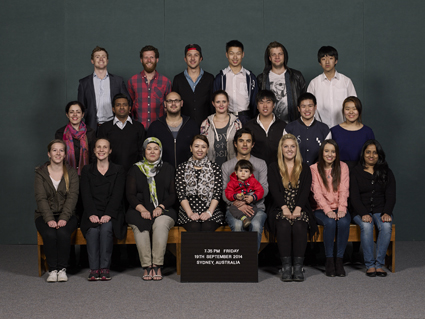
Treasured Photos of Random Strangers, James Dive, The Glue Society for Art and About Sydney
Right time, right place during the City of Sydney’s annual Art & About you could find yourself part of a group portrait taken by James Dive of the aptly titled Glue Society in the series Treasured Photos of Random Strangers. Why not celebrate the joys of randomness? Nice change.
Celebrating art is big and getting bigger. The long Spring-Summer festival season is underway. We report on OzAsia, Darwin Festival, Launceston’s Junction Festival, look back to the European Summer’s Avignon Festival and Odin Teatret’s Holstebro Festuge in Denmark and preview the Melbourne International Arts Festival and the Proximity Festival of one-on-one short works.
Philip Brophy and Dan Edwards were impressed by films about music from Nepal, Britain, Bali and India in the documentary program of the Melbourne International Film Festival, surely countering psychologist Stephen Pinker’s view that, in terms of human evolution, music is now merely “auditory cheesecake for the mind.”
There’s plenty of reading for dance fanciers with reviews of new works in Perth, Townsville (a Dancenorth-Tasdance collaboration), Cairns, Parramatta, Adelaide (Leigh Warren and the Glass Operas), Dunedin (NZ) and Performance Space’s SCORE season, plus an interview with American dancer Michael Schumacher who will be in Perth in November for the MoveMe Improvisation Festival.
RealTime issue #123 Oct-Nov 2014 pg. 3
© RealTime ; for permission to reproduce apply to realtime@realtimearts.net
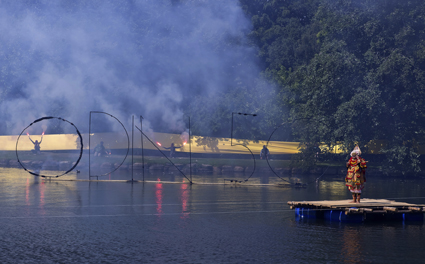
If the Grain of Wheat Does Not Die, closing performance Odin Teatret, 50th Anniversary
photo Tommy Bay
If the Grain of Wheat Does Not Die, closing performance Odin Teatret, 50th Anniversary
Odin Teatret’s 9th triennial Holstebro Festuge, a large-scale, public performance event, invited groups of international artists from diverse backgrounds to stage community collaborations, performances and cultural interventions in the Danish municipality of Holstebro and its surrounding villages.
In keeping with the theme Faces of the Future, Ghosts and Fictions, the festival’s artists were predominantly groups of young people trained in distinct performance styles. Facilitated by Odin Teatret and Odin’s emerging artist associates, international groups collaborated with local youth, staging actions that materialised as apparitions across the towns, in multiple shifting locations. The works wove formal aspects of performative and everyday life together to transform public life in the towns for the nine days and nights of the festival.
My perspective on the festival is framed by my role as participant, observer and, in the month preceding the festival, as an intern at Odin Teatret. My experience reflects the creative and pedagogical opportunities the festival offered its participants. It also attests to the festival’s disorienting nature, which the company’s director Eugenio Barba assured me on arrival would be an important part of the process, and through it I would find my own thread. The thread I found ultimately led me to a reflection on Odin’s examination of theatrical language over its 50 years as well as the language that it has developed itself, a unique material dialogue with the fictions embedded in performance and everyday life.
Over the festival I was primarily involved with two projects, Altamira Laboratory’s (Italy) collaboration with Wagnerhus Kindergarten (Denmark) and Isadora Pei’s and The Jasonites’ (Italy, Spain, Brazil) Living Island, two examples of the festival’s multiple collaborations with schools (of which there were five in the festival) on one hand, and the festival as a stage for exchanges between participants (Odin artists, international colleagues, emerging associate artists, local and international youth) on the other.
Altamira workshopped with children aged three to five over three months at Wagnerhus preceding the festival, composing dance and movement sequences using large pieces of coloured cloth. In the final performance children moved to live and recorded music, dancing in different cultural styles around the cloths, on top of them, hiding beneath them, and chasing them through a field. The movement scores had a kaleidoscopic quality suggesting the vital relationship between bodies, sounds and materials. The piece was presented as a performance exchange, first with the The Koinonia Children’s Team (from Nairobi’s periphery, trained in acrobatics by Father Kizito as an alternative to street life) and then with the local Taekwondo club. It had a marked effect on the kindergarten, teachers commenting children had become more outgoing over the collaboration.
Living Island was a floating performance space on rafts built by local Scouts ritually setting fire to ‘the past’ and hosting visiting performance groups. The space, on the town’s central river, was framed by large sail-like patchworks sewn with invented emblems, evoking the cultures of the participating groups. The island was surrounded by an installation of ‘relics,’ an auto-ethnographic museum of everyday life.
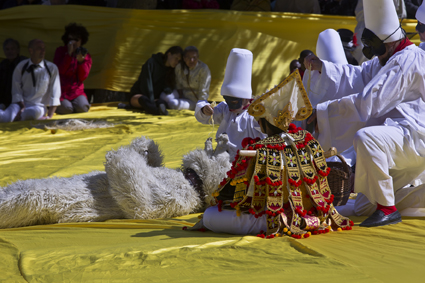
The 9th Holstebro Festuge, Faces of the Future, Ghosts and Fictions; Odin Teatret 50th Anniversary
Each day of the performance, Scouts sailed a new raft up the river, joining it to the others and hosting a different combination of performance events. The week began with a single raft and lone dancer from the Balinese Sanggar Seni Tri Suari school, accompanied by fire and instrumental music played on the bridge. Across the week performances included Odin actors Roberta Carerri, Jan Faslav and Tage Larsen, the Mercurial Family (Odin’s Julia Varley, associates Deborah Hunt, Carolina Pizzaro and Francesca Palombo), Lle Omolu Orixa dancers (Brazil), a local clown group and the Scouts themselves. The island was ushered and managed by Pei’s team of zombie Scouts (of which I was one). The work functioned as a parade of otherworldly, comic, archetypical and intercultural performance images that emerged from the Scouts’ fire. Their burning of ‘the past’ was a means of transforming and transcending everyday life. The piece climaxed with a final bonfire, after which the space was emptied completely, leaving participants haunted by the interactions that had taken place.
As with the other events at the festival Living Island was remarkably well attended, audiences returning daily to follow its progression over the week. In all, audiences paid avid attention to the festival program and were skilled in navigating its culturally diverse practices. Artistic literacy across the festival was a visible result of Odin’s half-century collaboration with Holstebro Municipality, where cultural awareness has developed through working with locals, as well as through the works presented at the theatre’s laboratorium.
The festival’s closing performance, If The Grain of Wheat Does Not Die, attracted hundreds of spectators. Staged in the town’s main park it ended with letters spelling Odin 50 in flames on the lake. Barba curated fragments of performance from across the festival for this final piece, arranging them to create a dialogue between performance styles. Junior Banda de Spina (Italy) marched through the centre of the cloth where Dynamis Teatro (Italy) were fighting: a sharp crease in a chaotic field. Kenyan acrobats exchanged their grass skirts for tutus, forming a conga line with the ballerinas. Paolo Comentale (of Casa di Pulcinella, Italy) and Kai Bredholt’s (Odin) polar bear, Otto, fed spaghetti to the young Balinese soloist while Mr Peanuts (Julia Varley’s skeleton in a tux) sang Peking Opera in conversation with an accordion, violin and instruments from the Barong.
The montage became a frame for the performance fragment featuring Odin’s parade of characters: Roberta Carreri’s Geronimo, a mistral clown with duck whistle, Julia Varley’s Mr Peanuts, Jan Ferlev’s Doggy (a dog skeleton in a suit playing the guitar), Tage Larsen’s Munken (a robed and masked monk), Kai Bredholt’s Otto and Iben Rasmussen’s half masked Trickster, each of the figures composed of a montage of performance images and materials. Working between performance archetypes to open up a new, rejuvenating space they function as curios or ambassadors of a still unknown tradition. They are emblematic of Odin’s work, founded on and yet creating openings within performance codes. Their fragmented singing of “We Are the World” presented an ironically anachronistic image of youth working between codes, stepping into the unknown—a youthfulness paradoxically derived from 50 years of dedicated work.
Clear Enigma, an outdoor retrospective following the festival, celebrating the company’s anniversary, exhumed material from the Odin Teatret oeuvre from Ornithofille (1965) on. The performance of these fragments, enacted first on a fortress made of dirt and then aboard the ship Talabot, blurred the distinction between bodies that enacted past performances and the physicality of past performances that animated the bodies of the actors now. The work concluded with children invading the space and piling Odin’s costumes and props onto a conveyer belt that dropped it all into a large pit which a bulldozer filled. A wooden frame with ropes was installed—a swing above the newly levelled ground.
The Holstebro Festuge and Clear Enigma reflected the importance of tradition and innovation for Odin Teatret. They formed a cyclical, ritual event that provided opportunities for youth as well as creating actions that revived the youthfulness of the theatre itself in a gesture of celebration and negation—or “disorientation” that opened onto a new space of the unknown.
The 9th Holstebro Festuge, Faces of the Future, Ghosts and Fictions; Odin Teatret 50th Anniversary, Holstebro, Denmark, 14-22 June; http://www.odinteatret.dk/events/holstebro-festuge-(festive-week).aspx
RealTime issue #123 Oct-Nov 2014 pg. 8
© Alice Williams; for permission to reproduce apply to realtime@realtimearts.net
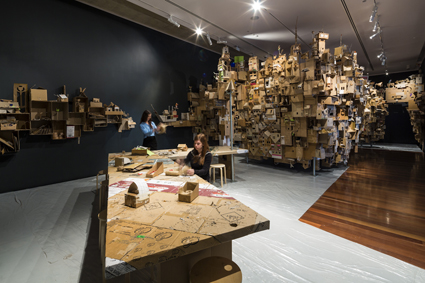
Alfredo and Isabel Aquilizan, In-Habit: Project Another Country, 2014, installation detail, Samstag Museum of Art, University of South Australia
photo Sam Noonan
Alfredo and Isabel Aquilizan, In-Habit: Project Another Country, 2014, installation detail, Samstag Museum of Art, University of South Australia
Adelaide’s annual OzAsia Festival, which began in 2007 as a cultural bridge to Asia, spotlights the cultures of the disparate nations of the region. Elements include the family-oriented Moon Lantern Festival, symposia on cultural exchange and politics, a film festival, crafts, cuisine, workshops and traditional and contemporary theatre, dance, music and visual art. Such a wide-ranging and illuminating exposition also sows developmental seeds.
Visual Art
The Samstag Museum is hosting two contrasting exhibitions highlighting postcolonial South East Asia and extending the perennial consideration of the nature of art: Alfredo and Isabel Aquilizan’s In-Habit: Project Another Country, and Berlin-based art dealer Matthias Arndt’s Mooi Indie—Beautiful Indies. ‘Mooi Indie’ refers to the early 20th century Indonesian art movement that used Western forms to depict sanitised, beautiful images of the Dutch colony. The term is now used ironically, as the artists parody colonial, Western culture. Jumaldi Alfi’s Rereading Landscape—Mooi Indie (I know where I am going) is a painting of an unframed Mooi Indie painting. He reframes and thus reconsiders the traditional Mooi Indie landscape subject. Wedhar Riyadi makes enlarged copies of found historical photographs of people posing in Western outfits, and then overlays them with vividly contrasting cartoon graphics, questioning the culture that spawned the photos and the imported values they represent.
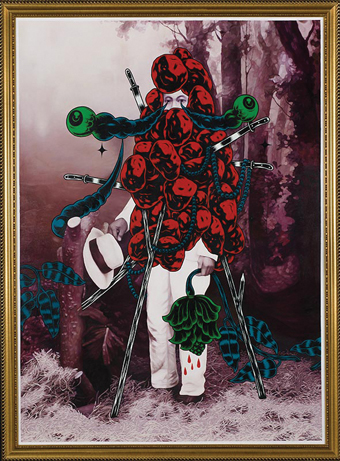
Riyadi Wedhar, Keributan, 2011, Mooi Indie
courtesy the artist
Riyadi Wedhar, Keributan, 2011, Mooi Indie
Eko Nugroho’s sculpture Under Pillow Ideology is a mannequin in a traditional Javanese mask hiding under a quilt and cushions, suggesting a traditional performer obscured by contemporary interior decoration. His La Rue Parle #9, made in France, is a tableau of images rendered in machine-embroidery that speak of urban European life, clashing the concept of urban culture with the mechanised form of a traditional handicraft. The Tromarama collective’s Ons Aller Belang is a set of dinner plates, printed with urban rather than decorative scenes, displayed together with a projected animation of the urban scenes. The reality of urban life thus displaces the typical decoration in these household goods, and animation displaces the static image. Arndt states, “If we observe the journey of Indonesian art from the colonial era to its present development, we can conclude that modern Indonesian art is a reflection of the struggle of local artists to achieve freedom, not only from colonialism, but also from Western domination.”
In-Habit: Project Another Country takes a very different approach. In this touring work, the Aquilizans build and rebuild a series of massive cardboard honeycombed structures representing ramshackle housing. The structure grows organically, like biological life enveloping the planet, and refers to the housing of the Badjao community of the Philippines. The Badjao are traditionally semi-nomadic, living on boats on the coast, but have been obliged to make more permanent homes. Built from whatever materials they can find, their houses sit on stilts over the water’s edge. Their culture is being rapidly overtaken.
Mounted within the cardboard structure are video screens showing Badjao life, including children giving rap performances for which they earn a little money. Embedding the videos in the cardboard structure metaphorises the invasion of contemporary technology. Rap is becoming a universal modus operandi of those affirming identity, and the Badjao children are thus synthesising a new culture. In creating the cardboard structures, the Aquilizans work with school groups in cities where they exhibit—again, it will be children who carry forward this new cultural awareness.
At CACSA, Cao Fei’s exhibition of videos is an excellent introduction to her compelling oeuvre, in which she analyses contemporary Chinese society through a range of cinematic devices from realism to animation and virtual reality. Her beautifully crafted video Haze and Fog shows the tedious, battery-hen existence of zombie-like people who are alive but whose souls are dead, an outcome of rural migration into high-rise urban life. Whose Utopia shows the desolate lives of factory workers, with dancers surreally appearing on the factory floor. Her animation RMB City Opera is evidently influenced by the propaganda plays of the Chinese Cultural Revolution, with their roots in traditional Chinese opera, and relates to her RMB City project, which is based in the VR Second Life. Her animation People’s Limbo shows a philosophical debate between Mao, Lao Tze, Karl Marx and a Lehman Brothers banker, and her Cos Players video documents people acting out role-playing fantasies, equating role-playing with real life. Cao Fei shows how the human spirit challenges the orderly but sterile high-rise life.
Music
Legendary Australian percussion ensemble Synergy joined with Korean five-piece Noreum Machi for a memorable concert that opened and closed with the two groups performing together. In between, they performed separately, and in the first half of the concert, Synergy gave us some classics of modern percussion—John Cage’s Third Construction, Nigel Westlake’s Omphalo Centric Lecture and a work by Synergy leader Timothy Constable.
Noreum Machi, performing traditional Korean music known as samulnori, opened the concert’s second half with a processional entrance, Gilsori, from the back of the auditorium. Based on traditional forms—percussion, dance and singing—but redesigned for contemporary audiences, Noreum Machi’s music attracts those interested in Korean traditions. It’s high-energy and fun. The complex rhythms have an infectiously jazzy feel, building up to fast, intense crescendi. During this performance, we were invited to participate in a voice percussion work but the performers soon left us behind. Noreum Machi also use reed instruments, the low-pitched piri and the wailing higher-pitched taepyongso, which sound like declamatory human voices. Kim Yong-jun’s taepyongso solo, East Wind, was hypnotic.
For the riotously joyous concert finale, Noreum Machi and Synergy joined forces, Constable blowing a conch shell to match Kim’s taepyongso. This is a dialogue between cultures and between the ancient and contemporary. The two ensembles expound their own traditions as well as working together, offering three genres of challenging but totally engaging music.
In a concert combining art with music, Japanese calligrapher Hiroko Watanabe made work on stage to the accompaniment of jazz-rock-taiko fusion band Above the Clouds, her action projected on a screen above the stage. Following an introduction that reminded us of the origins of calligraphic ideograms, she responded to the music by rapidly executing dozens of large-scale gestural works in heavy black ink on paper mounted on fold-out cardboard boxes that she then stacked around the stage until she was surrounded by a forest of images. Afterwards, ensemble members autographed giveaway CDs. With screaming guitar and energetic taiko drumming, this is theatrical entertainment, but it extends the appreciation of calligraphy and taiko through reinvention and popularisation. Watanabe’s calligraphy emphasises the spontaneity characteristic of such art. Her work is displayed at the Art Gallery of SA alongside traditional Chinese, Japanese and Korean calligraphy, some of which is centuries old.
The Western domination of which Matthias Arndt speaks is not only economic or political and is not confined to visual art—cultural appreciation and criticism are frequently Western-centric. OzAsia Festivals bring us traditional culture, hybrid, modernised culture and cultural and political critique that press us to re-consider our own perspectives. In celebrating cultural diversity and cross-fertilisation, festivals such as OzAsia precipitate and encourage artistic development, and the emerging forms develop their own trajectories and aesthetics, accelerating cultural evolution.
8th OzAsia Festival 2014: Mooi Indie—Beautiful Indies, Indonesian Art Now, curator Matthias Arndt, and In-Habit: Project Another Country, Alfredo & Isabel Aquilizan, Samstag Museum of Art, 1 Aug-3 Oct; Cao Fei’s Theatrical Mirror: living in-between the Real and Unreal, Contemporary Art Centre of SA, 12 Sept-19 Oct; Synergy Percussion Meets Noreum Machi, Space Theatre, 12 Sept; Hiroko Watanabe and Above the Clouds, Dunstan Playhouse, Adelaide, 13 Sept; http://www.adelaidefestivalcentre.com.au/ozasia-festival/
RealTime issue #123 Oct-Nov 2014 pg. 4
© Chris Reid; for permission to reproduce apply to realtime@realtimearts.net
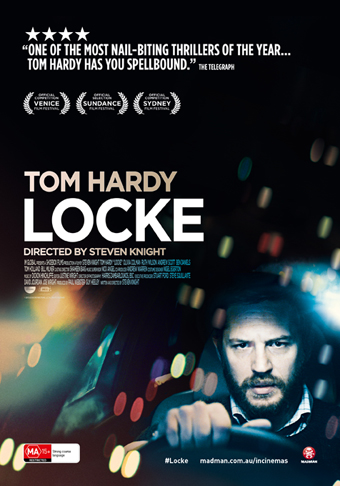
DVD: Locke
A man in a car. Alone. For a whole film. Even more alone than Robert Pattinson’s Eric Packer on his existential slippery slope in David Cronenberg’s adaptation of Don DeLillo’s novel Cosmopolis. Tom Hardy’s Ivan Locke is a businessman. One phone call undoes him. He drives and drives, he phones, he talks, as career, family and psyche unravel. Acclaimed for direction, concept, camera work, sound design and above all performances—it was filmed in 10 days with Hardy working to iPad cues hidden from view and improvising—this is one of the most highly regarded British films of recent times after Jonathan Glazer’s rivetting Under the Skin.
8 copies courtesy of Madman Entertainment
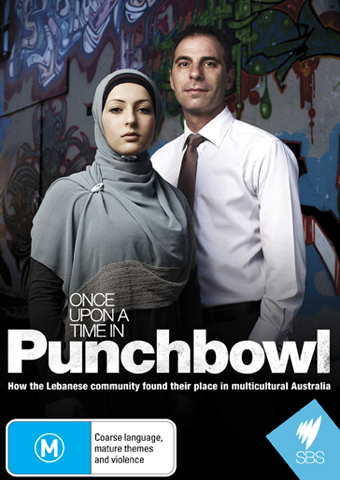
DVD: Once Upon a Time in Punchbowl
This four-part series is engrossing and enlightening and should be aired on commercial TV networks in prime time—it’s that important at a time when most Australians have little understanding of Middle Eastern cultures, or their manifestation in Australia. The series traces Lebanese settlement in southwest suburban Sydney from the 1970s to the present, interviewing families, police officers, community leaders, former drug addicts and criminals and sociologist Andrew Jakubowicz. Along with its precursor Once Upon a Time in Cabramatta (2012), Once Upon a Time in Punchbowl is another important step towards understanding Australian culture of the 21st century. There are more steps to take.
5 copies courtesy of Madman Entertainment.
Please note you can nominate for ONLY ONE GIVEAWAY.
Email us at giveaways@realtimearts.net with your name, postal address and phone number.
Include ‘Giveaway’ and the name of the item in the subject line.
RealTime issue #123 Oct-Nov 2014 pg. 56
© RealTime ; for permission to reproduce apply to realtime@realtimearts.net
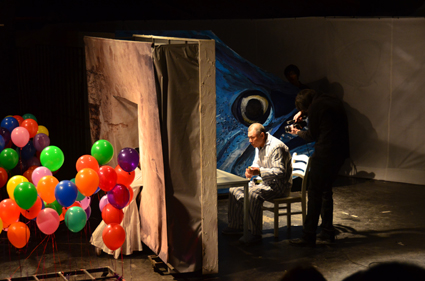
Ibsen In One Take
courtesy Ibsen International and OzAsia Festival
Ibsen In One Take
The focus of the 8th OzAsia Festival is on China’s Shandong Province, famed birthplace of Confucius and home to around 100 million people. A meeting place of ancient and modern trade routes and the location of culturally significant sites for Taoists, Buddhists and Confucians, Shandong’s historical legacy and agriculture- and natural resource-derived affluence are obliquely reflected in this year’s marquee productions Red Sorghum and Dream of the Ghost Story, by the Shandong-based companies Qingdao Song and Dance Theatre and Shandong Acrobatic Troupe, respectively.
Both are conservative, visually lavish works, seemingly model companions for the chatter about soft diplomacy and measurable cross-cultural benefit that inevitably orbits the festival. To the contrary, Mayu Kanamori’s ascetic docudrama Yasukichi Murakami—Through a Distant Lens strove for verisimilitude in its unsentimental summoning of early 20th century Japanese-Australian ghosts, and Théâtre du Rêve Expérimental’s flawed but enterprising glance at Ibsen’s oeuvre, Ibsen in One Take, provided food for thought.
Red Sorghum
Adapted from the 1987 Chinese language novel of the same name, the balletic Red Sorghum is a vast undertaking—around 50 dancers under the direction of Ge Wang and Rui Xu propel Mo Yan’s complex, generation-spanning family saga towards its bloody climax set during the Second Sino-Japanese War (1937-1945). There are unpleasantly nationalistic overtones by the time this point is reached, Japanese ‘devils’ bayoneting their way across the stage without the leavening effect of the novel’s viewpoints from both sides of the conflict. But there is no doubting the vitality and precision of the preceding two hours. Especially impressive in this regard are the lusty, though strictly gender-segregated, distillery and harvest set pieces that take in the novel’s central metaphor—the versatile sorghum grass—and the masterfully sinuous love duets between lead dancers Meng Ning and Fubo Sun. Yuan Cheng’s recorded score is more of a mixed bag, most successful when least bombastic (I wasn’t surprised to learn it had been taken to Hollywood for mixing and production). A suona horn, a Chinese folk instrument with a distinctive high pitch, is a lovely addition to the otherwise predominately Western musical palette that, like the production more generally, ends up a somewhat over-rich concoction.
Dream of the Ghost Story
Shandong Acrobatic Troupe’s Dream of the Ghost Story is similarly predicated on spectacle but is also driven by it rather than by narrative—its use of a Qing Dynasty fable about demonic intervention in a love affair between a fox fairy (Zhang Xu) and a human scholar (Guo Qinglong) is nominal, a lightweight scaffold for the 55-year-old company’s well-honed legerdemain. Liu Kedong’s set design consists of a series of telescoping, parchment-like archways that hint at Dream of the Ghost Story’s folkloric origins but leave most of the vast Festival Centre stage open for the ensuing, virtually unstopping acrobatic displays: hoop and aerial work, plate spinning, juggling with hands and feet, Chinese yo-yoing, gymnastics, contortion and balancing. It’s heady stuff—there are no safety nets, and Guo Sida and Du Weis’ full-bodied, rock-accented soundtrack ups the show’s winningly deceptive uninhibitedness, most memorably during the second half’s descent into the spirit world when massed, incandescent skeletons judder, twitch and stomp à la Michael Jackson’s Thriller. A shamelessly entertaining fusion of ancient Chinese variety art and contemporary Western excess.
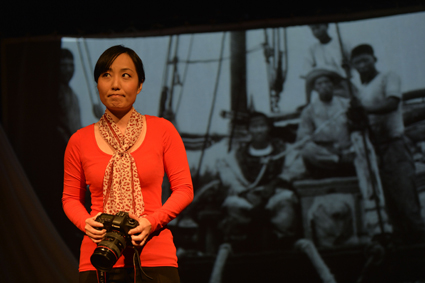
Arisa Yura, Yasukichi Murakami—Through a Distant Lens
Elise Derwin, courtesy Darwin Festival
Arisa Yura, Yasukichi Murakami—Through a Distant Lens
Yasukichi Murakami—Through a Distant Lens
The supernatural is also present in Yasukichi Murakami—Through a Distant Lens, a lean documentary performance work that quietly seeks to rehabilitate the memory of Japanese-Australian businessman and photographer Yasukichi Murakami who died in a Victorian internment camp in 1944. Murakami (Kuni Hashimoto) appears as a ghost to Mayu (Arisa Yura), playwright Mayu Kanamori’s analogue within the play. Their relationship begins with him softly rebuking her for taking photographs without, as Kanamori phrases it in her program notes, “taking notice, making an effort to hold space in reverence, trusting and responding in humility.”
The chronological rift between Murakami and Mayu only becomes clear when, by way of demonstration, Murakami sets up his box camera and photographs unseen members of his young family in Broome. Beautiful, high-resolution projections of Murakami’s actual photographs of fellow Japanese immigrants and pearling crews appear throughout the production but the play makes it plain that a shadow remains over his career—many images it is thought he is responsible for, some of which today reside in the National Archives and grace the covers of notable works of history, remain uncredited to him.
Director Malcolm Blaylock and visual designer Mic Gruchy imbue what is in essence a love letter to an unjustly overlooked life with the same reverence for space and attentiveness to detail Murakami demands of Mayu’s photographs. To say that Blaylock employs naturalistic performance, film, projection and a live score (composed and performed by Terumi Narushima, and which employs both traditional Japanese and esoteric instruments) makes the work sound cluttered but it is, rather, a dramaturgically crystalline—and ultimately moving—meditation on place, photography and the politics of recognition. (See also page 6.)
Ibsen in One Take
Henrik Ibsen’s problem plays have long exerted a significant influence on the course of modern theatre in China. Indeed, it took a conference on the playwright’s work in the 1920s for a Chinese word to be coined to distinguish spoken word drama from that which was, traditionally, sung. Ibsen in One Take, written by Oda Fiskum and directed by Wang Chong, feels like both an expression of and a reaction against the country’s longstanding fascination with A Doll’s House, The Master Builder and Hedda Gabler. There are close echoes of and occasionally exactly duplicated dialogue from each of these plays. The lugubrious plot centres on four iterations of the same man, called simply Him: as a child (Yang Boxiong), a young man, an adult (both Li Jialong) and an old man (Tan Zongyuan) who, nearing the end of his life, is confined to a hospital bed and reduced to pondering his past to assuage the boredom. Brief, intimate scenes flavoured with Ibsen’s familiar high-tension domesticity are arrived at through flashbacks.
The scenes are filmed by an onstage two-man camera crew whose vision appears on a large screen overhanging the space (the screen also displays English translations of the Chinese language dialogue). There are big problems, not the least of which is the conceit of filming the live actors ‘in a single take.’ Without a clear rationale, the footage feels extraneous; I felt no compulsion to watch the screen except for the surtitles. It is strange, too, that opportunities for enriching the production through the filming are often either mishandled or missed altogether. For example, a potentially delightful moment when a spray bottle is used to simulate rain falling on two actors is squandered because the water doesn’t show up on the screen. The camera usually lingers in close proximity to the actors’ faces, its gaze failing to either explicate or surprise, and the elusiveness of Fiskum’s script—a dour, slightly rudderless construction which strays too far from Ibsen’s psychological insights to prove affecting—remains largely unalleviated by its presence.
8th OzAsia Festival 2014: Qingdao Song and Dance Theatre, Red Sorghum, Festival Theatre, 3 Sept; Shandong Acrobatic Troupe, Dream of the Ghost Story, Festival Theatre, 5-6 Sept; Yasukichi Murakami—Through a Distant Lens, performers Arisa Yura, Kuni Hashimoto, Yumi Umiumare, Space Theatre, Adelaide Festival Centre, 9-10 Sept; Théâtre du Rêve Expérimental, Ibsen in One Take, Space Theatre, Adelaide Festival Centre, 16-17 Sept
RealTime issue #123 Oct-Nov 2014 pg. 5
© Ben Brooker; for permission to reproduce apply to realtime@realtimearts.net
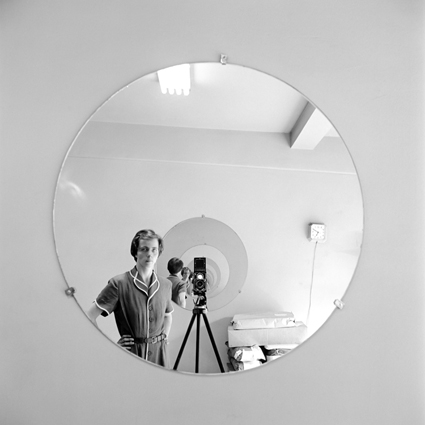
©Vivian Maier/Maloof Collection
Nothing thrills quite like the recovery of lost art works, radical re-assessments, the outing of forgers or, better, discovering the impressive archive of a hitherto unknown artist. American nanny and private photographer Vivian Maier (1926-2009) only ever sent a small selection of her photographs to gallerists or publishers in France and one to a family she worked for. One hundred thousand negatives of her images of street life, principally in Chicago, were discovered and some printed after her death, to great acclaim.
Not only was Maier an obsessive and very private photographer, she also exhibited eccentric characteristics, another plus for those taken with the curious lives and motivations of artists: “Residents of the Chicago suburb of Highland Park had gotten used to the nanny (taking photographs) along with her French accent, her penchant for wearing men’s coats and boots, and the look and gait that led children to call her ‘bird lady’” (David Zak, Smithsonian Magazine, Nov, 2011).
Maier’s black and white photographs are crisply precise (taken with a medium format Rolleiflex twin-lens reflex camera) and formally strong, yet blessed with a sense of street-life immediacy and moments of reflection—including images of herself, camera in hand. One gallerist, writes Zak, described her as “having the skill of an inborn melodist.”
Melbourne’s Centre for Contemporary Photography (CCP) is presenting a selection from Maier’s huge body of work alongside images by a fascinating array of Australian photographers Patrick Pound, David Wadelton, Debra Phillips and visual artists who, like Maier, turn the camera on themselves—Cherine Fahd, Gabriella and Silvana Mangano, Clare Rae, Simone Slee and Kellie Wells.
Maier’s work has now been exhibited internationally and a book, Vivian Maier: Street Photographer, has been edited by John Maloof, the real estate agent who ‘discovered’ her by purchasing 30,000 of her images for $400 at an auction, purely out of curiosity. Finding Vivian Maier, a feature-length documentary by Maloof and Charlie Siskel, has been programmed in a multitude of international film festivals and will screen in the Melbourne Festival as a companion piece to Crossing Paths with Vivian Maier before its cinema release.
2014 Melbourne International Arts Festival: Crossing Paths with Vivian Maier, curators Naomi Cass, Louise Neri, Karra Rees, CCP, Melbourne, 3-26 Oct; Finding Vivian Maier, directors John Maloof, Charlie Siskel, ACMI, Melbourne 16, 18, 23 Oct
RealTime issue #123 Oct-Nov 2014 pg. 55
© RealTime ; for permission to reproduce apply to realtime@realtimearts.net
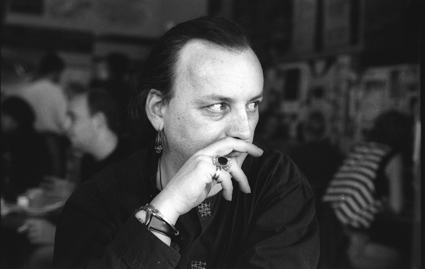
Christopher Barnett, courtesy Antenna Documentary Film Festival
In Adelaide and Melbourne in the early 1980s the hard talking, hard living poet Christopher Barnett was a force to be reckoned with—socially, artistically, politically, not that he made these distinctions.
A charismatic public performer, this self-styled “Cultural Bolshevik”—a homage to his hero, Valdimir Mayakovsky (see p42)—and a key collaborator with Nicholas Tsoutas and Peggy Wallach in the All Out Ensemble, Barnett left Adelaide for Fitzroy and then in the mid 80s relocated to Nantes in France where he became notable for co-founding an experimental company, Le Dernier Spectateur, working with the disenfranchised.
The film’s maker Anne Tsoulis writes, “To understand what shaped the artist, we explore his formative years, raised in poverty in a dysfunctional Adelaide family to becoming the teenage poet and enfant terrible. We discover that, at an early age, his Communist ideals helped him to survive his own challenging circumstances.”
The 53-minute documentary includes footage of readings, reunions, a rare homecoming to suburban Adelaide after a 20-year absence and a visit by road in winter to visit Thomas Harlan, a radical documentary maker and translator of Barnett’s Blue Book.
These Heathen Dreams is screening in Sydney’s 2014 Antenna Documentary Film Festival. In The Conversation, 8 Aug 2014, you’ll find Wendy Haslem’s review of the film screening at the Melbourne International Film Festival and in the 29 Nov, 2013 edition you can read Anne Marsh’s appreciation of Barnett, “The greatest Australian poet you’ve never heard of,” on the occasion of the launch of a book of his poetry, titled when they came/ for you: elegies/ of resistance, published by Wakefield Press.
2014 Antenna Documentary Film Festival, These Heathen Dreams, Journey of a Cultural Bolshevik, director Anne Tsoulis, producer, Georgia Wallace-Crabbe, Chauvel Cinema Two, Sydney, 8 Oct, 8pm
RealTime issue #123 Oct-Nov 2014 pg. 55
© Keith Gallasch; for permission to reproduce apply to realtime@realtimearts.net
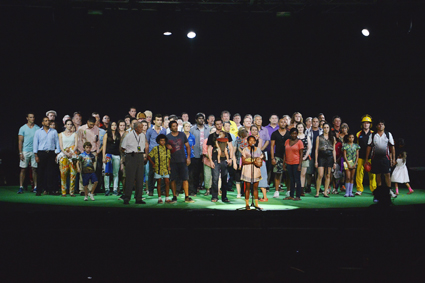
100% Darwin, Rimini Protokoll, Darwin Festival
Elise Derwin, courtesy Darwin Festival
100% Darwin, Rimini Protokoll, Darwin Festival
Two productions in the 2014 Darwin Festival reviewed here involve distinctive collaborations between Australian and Asian artists, exploring fusions of traditional and contemporary cultural practices. With Asia as northern Australia’s nearest neighbour and being closer to Darwin than other Australian cities, this kind of exchange is becoming more common, with artists engaging in longer-term and ongoing projects. This creative fusion is reflected in the rich mix of ethnicities in the city’s population, as was evident in 100% Darwin.
100% Darwin
Held in the amphitheatre in Darwin’s tropical Botanic Gardens, 100% Darwin is a surprisingly moving, community-building experience. Germany’s Rimini Protokoll have created 100% cities since 2008 starting with Berlin, then 20 other cities around the world. They work with 100 locals with the aim of “performing the diversity” of each city. Casting director Bec Reid selects the first person; in Darwin it was baby Jordan. Each person then has 24 hours to find the next who must fit a specific criterion so that by the 100th person there is a huge cross-section of Darwin’s population represented—diverse ethnicities, ages, political views, sexualities, professions, interests. Ninety percent of the cast members have never been on stage before.
They come one by one onto the slowly revolving stage, each bringing their own special object (equally diverse, from teddy bears to microscopes, photos, tattoos, art and fishing rods). Each introduces themselves with a short snippet: “my vagina was made in Thailand,” and things they love or odd habits they have: “I always put my left shoe on first.” We get to know them and then the statistics begin. Through a series of questions the performance explores who is who, does what and believes what, with people moving to stand beside the “me” and “not me” signs that are held and sometimes dropped if no-one aligns themselves. The performers are supported and guided throughout by live music from local musicians David Spry and The Moral High Ground. It’s surprising and confronting as questions posed move from the easy: “who lives in Palmerston?” to: “who has tried and failed to save a life?” to: “who believes in the death penalty?” and “who has thought about taking their own life?”
This is reality theatre in which Helgard Haug and Daniel Wetzel’s direction ensures the two hours never drag by using different modes of posing and answering the questions that form the core of the piece—participants moving to yes/no areas of the stage, dancing, miming their hourly lives, showing coloured cards, asking questions of each other, asking questions of the audience, shining torches in the dark with birds-eye-view cameras showing results on screens at the sides of the stage. They reveal themselves to the audience and, like reality TV, it is totally absorbing.
Some of the revelations about what people felt shocked me. A large number agreed with the death penalty and would kill for their family and their country. Despite this, a feeling of connection between diverse people was generated and a liking for the very people whose opinions I would strongly oppose.
Book of Shadows: Chapter One
Book of Shadows is an NT/Indonesian collaboration incorporating live actors, traditional Balinese and contemporary shadow puppetry and new media. In a festival usually reserved for completed works it was refreshing to participate in a work-in-progress showing with a discussion and feedback session. It shows the vast amount of work that goes into making such a stylistically complex piece. This work is in its infancy. It has beautiful imagery and depth of combined visuals—kaleidoscopic colour film sequences, animations and elegant shadow puppetry —giving it the visual wow factor although the content still needs clarity and purpose.
Book of Shadows has a plethora of elements and is a deliberate mash-up of multiple Greek and Balinese traditional myths in what is an, as yet, unclear and over-complicated story. Beck Adams’ cave-like set with its scrunched and hanging layers of paper lit in ethereal blue was instantly alluring and provided multiple areas for action and projection. The combination of live and recorded sound moving from electronica to simple thumb piano was evocative, echoing the mix of contemporary and traditional visuals. With strong dramaturgical input this piece could be stunning.

Arisa Yura, Yasukichi Murakami—Through a Distant Lens
Elise Derwin, courtesy Darwin Festival
Arisa Yura, Yasukichi Murakami—Through a Distant Lens
Yasukichi Murakami —Through A Distant Lens
Through a Distant Lens is a delicate and beautifully simple evocation of the life of Yasukichi Murakami, photographer, inventor, entrepreneur and part of Darwin’s high society in the 1930s. The performance begins with the whole end wall of Brown’s Mart theatre covered in a projection of trees moving gently in the breeze and the musician at the side of the stage playing traditional Japanese instruments mixed with recorded sound—wind and birdsong.
Writer Mayu Kanamori, a contemporary Japanese-Australian photographer and performance maker, probes Murakami’s colourful past and searches for truths about his life and his photographs—the latter lost when he was interned as an ‘enemy alien’ in Victoria after the bombing of Darwin in 1942. Diverse story-telling techniques are used to unearth secrets and truths which are based on historical research: direct address, acted scenes, projected still images and interactive film of Murakami’s stern traditional mother played by Yumi Umiumare .The character of Murakami appears as a ghost with camera in hand to talk about life and art with young Mayu. They banter, philosophise, dance together, watch projected images of his family and friends and meditate on the nature of photography. The old sepia photographs of Murakami’s Japanese family tell both his personal story and that of many Japanese Australians of the time. We see the formal family weddings, the Japanese pearl divers’ graveyard in Broome, Captain Gregory the flamboyant pearl lugger owner and friend and business associate of Murakami, Tatura internment camp and Murakami’s own portraits of his children. Finally we see images of his funeral. This is a gently moving production with elements seamlessly combined and supported by a haunting soundtrack and live music. The opening night at Brown’s Mart was especially poignant as the two front rows were filled with Murakami’s descendants. (See also p5.)
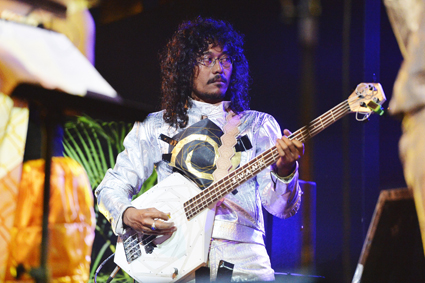
The Lepidopters
photo Elise Derwin, courtesy Darwin Festival
The Lepidopters
Lepidopters, A Space Opera, Part Four
Punkasila, Indonesian mystic art music punk band, renowned Australian classical pianist Michael Kieran Harvey, singer-dancer Rachel Saraswati and local Darwin artists and musicians came together to create this behemoth tipped as a “sci-fi-meets-alien-moths-meets-Javanese-mysticism visual/video /musical/installation performance experience.”
An eclectic mix of Gamelan, post-punk, classical/jazz piano and projected illustrations, this space opera is an Australian/Indonesian collaboration that defies definition and challenges audiences—some leaving, some whooping. Silver-suited band Punkasila with big hair and geometric electric guitars (Gary Glitter comes to mind) take centre stage with Harvey on piano and Saraswati combining the traditional and post punk in both her vocals and movement. Divided into movements, this production is a roller coaster of confusion and entertainment, opening with Harvey’s looped jazz piano, followed by the Darwin Gamelan Orchestra and Choir, then a punk band, live piano and flute with traditional Indonesian backing, a guitar and synth duet and even local Indigenous performer June Mills performing a Larrakia welcome to country with acoustic guitar. The projected animations continued throughout all the musical sections with hand-drawn images telling the story of the alien moth invasion, its meaning not clear to all—but that was immaterial as the performers took the willing on a journey and left others to fend for themselves.
Darwin Festival, 100% Darwin, concept, direction, dramaturgy Rimini Protokoll, Darwin, The Amphitheatre, George’s Green, 9 Aug; Book of Shadows: Chapter One, Brown’s Mart Theatre, 10 Aug; Yasukichi Murakami—Through A Distant Lens, writer, creator Mayu Kanamori, dramaturg Jane Bodie, director Malcolm Blaylock, Brown’s Mart Theatre, 19, 20 Aug; Lepidopters, A Space Opera, Part Four, creator, musician Danius Kesminas, visuals Erwan ‘Iwank,’ Hersi Susanto, Terra Bajraghosa, Slave Pianos, The Lighthouse, Darwin, 7-24 August
RealTime issue #123 Oct-Nov 2014 pg. 6
© Nicola Fearn; for permission to reproduce apply to realtime@realtimearts.net
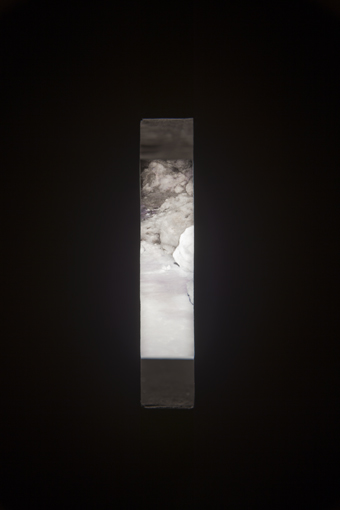
Scott Miles, Nothing under the sun, courtesy the artist
Stepping into what seems to be a darkened corridor, I wait for my eyes to adjust…but they don’t. There’s just darkness; and in the distance, a small square of dim, glowing light. My hand touches the matt black paint on the wall to my left; the right wall, I think, runs straight ahead. So I feel my way with my hand, and a metre or so along I find a vertical slit; I look through. It reveals a room containing a large image in black and white, of luminous, snow-covered rocks or ice. I guess that if I follow this wall, I will find a break or a corner, will be able to turn left and left again, to access this room.
I keep going, very disoriented, but drawn forward by the touch of my hand on the wall, which sometimes changes texture as if there is a smooth steel edge of a panel, and then another panel. I’m not sure whether perhaps the wall is curving. I continue in this absolute black; surprised, fascinated, apprehensive. As I approach the end, the distant glow turns into a small light box on the wall, and then into a very small painting on reflective copper—an orange sun in a black landscape—and my hand finally reaches a large opening. A long, dim room extends back towards the entrance.
Before even beginning to ‘see’ Scott Miles’ Nothing under the sun, I’ve experienced a really strange sensory place, nearly lightless but for a vague, sun-like impression, far away. While negotiating the dark, I’ve been pursued by weird taps, pitches and clicks that remind me of bat or dolphin sonar; and pale, flange-ing drones like humming hard-drive fans. I’ve glimpsed, teasingly, light reflected off snow.
In the long ‘gallery’, when I reach it, I can see—just. On a video screen, what seems to be snow flurries towards the viewer, apparently caught in the camera’s own light. Further along, there’s a large, round painting—ice and rocks again—in subtle, monochrome bands, tinged faintly pink and greenish. For a moment, I think I’ve found the room behind the slit—I think I can see the slit. I feel along the wall for it, for assurance. But there is no aperture, and that other room remains hidden.
And then I realise the painting is not round at all; its rectangular shape becomes clear in the shadows beyond the circular beam of light that illuminates it. That’s how dark the room is.
Nothing under the sun draws on Scott Miles’ experiences in Greenland’s Upernavik artists’ retreat, during winter, when the sun did not broach the horizon for many weeks. It was so dark, he said, he took photos in order to see his surroundings (West Space artists’ talk, 28 August). The icy ground was treacherous, so getting around was difficult. Over time, he became acutely aware of sound and learned to move carefully so as not to slip or fall. In his paintings he wanted to experiment with “the removal of light,” and equally, “to bring the conditions of that experience into the exhibition environment”—in particular, to create a sense of duration.
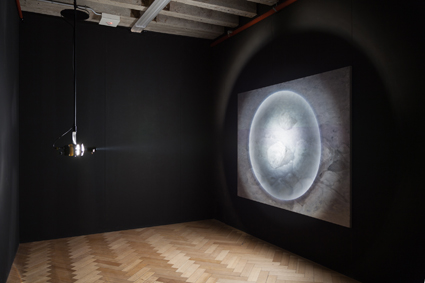
Scott Miles, Nothing under the sun, courtesy the artist
The result is an unusual combination of painting—arguably the endangered polar bear of contemporary artforms—and light/sound installation. The gallery illumination is as faint as the starlight Miles became attuned to, consequently the paintings are eclipsed (but not obliterated) by the darkness and the AV-based (yet representational) form of the work as a whole. Their place here feels apt: as precise as photographs, they physically manifest time, contemplation and meticulous observation. Like the polar bear, they know where they are. Around them the soundscape, neither entirely abstract nor identifiable, shifts from speaker to hidden speaker. Combining found sounds and experiments with extreme frequencies, the audio is partly inspired by an Upernavik local’s recordings of radio waves emanating from the auroras: chirping, whistling siren-calls from Earth’s magnetosphere.
The Arctic, understandably, has become a regular muse for environmental laments, and a symbol of disintegration, loss and fragility in the work of many artists. Nothing under the sun is refreshing for not fetishising the melting icebergs and crumbling glaciers, nor asking us to contemplate the demise of the frozen north. Miles’ work lets the Arctic be just what it is: a place that whistles and rolls its hard-to-believe sounds around the ears; that challenges two-legged animals to see or stand up straight, at times; and that fascinates, disorients and unsettles in ways that will always resist the overlay of human meaning.
Scott Miles, Nothing under the sun; West Space, Melbourne, 1–30 Aug
You can read about Urszula Dawkins’ Arctic experience in The Arctic Circle international arts/science collaborative residency, Svalbard, Norway in RealTime 100.
RealTime issue #123 Oct-Nov 2014 pg. 54
© Urszula Dawkins; for permission to reproduce apply to realtime@realtimearts.net
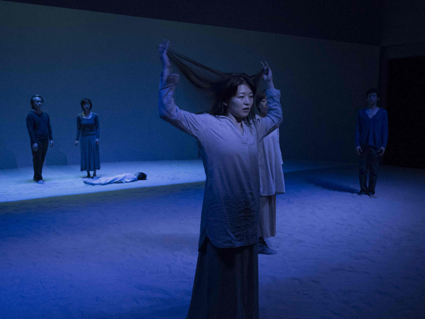
Intérieur, Shizuoka Performing Arts Company/Les Ateliers Contemporains
photo Koichi Miura, courtesy Avignon Festival
Intérieur, Shizuoka Performing Arts Company/Les Ateliers Contemporains
With threatened social welfare cuts, artists and other workers across France went on strike this summer, including on the first day of the 2014 Avignon Festival. With banners across every venue, announcements of solidarity before every show and politicians banned from theatres, a very particular political message framed the audience experience.
Works offering overt political analysis such as Solitaritate from Romania and La imaginación del futuro from Chile brought this context into sharper view. The political framework felt equally strong in Intérieur, directed by French master Claude Régy, despite his presenting no overtly political message. Analysis and action, generational political engagement and the politics of western democracies were among the topics posed at the festival under the new artistic director Olivier Py.
Solitaritate
Solitaritate by Romanian writer-director Gianina Cărbinariu is a series of comic episodes which question the current guiding ideologies of Western democratic capitalism. Performers begin the show debating which audience rows they own—individuals claiming us as their territory. Falling walls are a repeated visual metaphor—from the theatrical fourth wall to a domestic argument which leads to a brick wall falling around a couple and their neoliberal ideals. This recurring motif unites the scenes that show all human experiences and intimacies reduced to commodities. In one scene we attend the funeral of “Eugenia Ionescu”—an homage to Romania’s greatest dramatist Eugene Ionesco. It’s a self-conscious attempt for this new generation of theatre-makers to bury the idols of their past and carve out theatrical space of their own. Cărbinariu places the blatant colonialism of marking out audience territory alongside a monologue from a nanny imported to work for a wealthy European family. A huge glittering Romanian flag—hung upside down—unexpectedly drops to engulf the nanny who struggles, trying to free herself from its oppressive weight.
Cărbinariu states that putting everyday lives in the theatre is a subversive act in Romania and no doubt this is what attracted the programmers. Unfortunately, the work seems somewhat contrived, its tone naive in an international festival where the context is starkly different. In a way the programming of this show for the festival mimics the very questions of consumerist ideologies posed by the company—and the power of their production is diluted as it becomes part of the marketplace it is questioning.
La imaginación del futuro
Further questions of political context are posed in relation to Chilean theatre company La Re-sentida’s La imaginación del futuro which replays the military coup and mysterious death of Salvador Allende on 11 September 1973. The brute force and energy of this young ensemble is undeniable; however, rather than the future implied in the title we are presented with a past reimagined with irreverence and humour. Allende is surrounded by political advisors at every turn trying to enact influence, minimise damage and create spin with the construction of his famous final address filmed and re-filmed. The backdrops, costumes and the speech are manipulated and reconstructed in a live video feed. In a triumphant moment for the advisors, huge banners of Che Guevara, Fidel Castro and Salvador Allende are unveiled during a dance routine to Latino-American hip-hop group Cypress Hill.
La Re-sentida poses the question of how Chile became a dictatorship after the death of Allende and how the construction of truth and mythology is continually remade. Although these are worthwhile questions, the ensemble’s response suggests cynicism rather than proposing any liberating action. As spectators we embrace the show’s surface and join in mocking the past. However, the present tense cynicism of the production diffuses the possibility of any political action as we realise our own impotence.
While La Re-sentida have power in their analysis, their discourse fails to move on from political rhetoric while drawing a new, less nostalgic view of Allende. La Re-sentida have bravado, enthusiasm and wit, but do not transform their questions into action that results in true political engagement for the spectator.
Intérieur
There is no explicit political analysis in the work of 89-year-old Claude Régy’s Intérieur. Régy first directed Maeterlinck’s 1895 play in France in 1985. So when Shizuoka Performing Arts company invited Régy to direct a play for them, it was this piece he wanted to revisit, in Japanese, with Japanese performers. Intérieur in Régy’s hands focuses on the symbolism of death and transcendence. We are confronted by the rules this director imposes upon us on the way into the theatre. An announcement requests total silence. Maeterlinck desired us to be aware of the laws we are subject to. The writing is pared back to essentials: minimal text which is simple and direct. We look with the townspeople at the silent family inside the house. A small boy is asleep centre stage. His immobile body comes to symbolise death as we hear about the death of his sister in the river.
Every movement and phrase in this work is excruciatingly slow. At this pace, interactions become inhuman and language unrecognisable: all removed from the everyday. Theorist Walter J Ong has stated, “sound only exists as it is going out of existence.” Régy’s theatrical investigation takes this to its extreme. We are acutely aware of each syllable and the silence that surrounds it. With slow motion, we are forced to reconsider what it is to be a spectator and become acutely aware of those around us too—the audience that coughs and wriggles. The stage is covered in noiseless white sand on which the performers almost seem to float. The only defined feature is the delineation between interior and exterior: the subject of the play, marked by low lighting, shifting almost imperceptibly between one colour and the next.
The impact of Intérieur resonates long after the experience—whether one is confronted, enamoured or enraged. In reimagining Maeterlinck’s text, this production awakens the audience to reconsider their position in the act of watching. We are offered no way in which to process this—we are given no referent for the real world. Without this, and by boldly manipulating time and space, Régy manages to break the nexus between consumption and culture for the duration of the play. Intérieur brings us to a new awareness and engagement with the world surrounding us through its theatrical action which resonates as a brave political act.
2014 Avignon Festival: Theatre National Radu Stanca Sibiu, Theatre National Bruxelles (Romania/Belgium), Solitaritate, 19-27 July; La Re-sentida (Chile) La imaginación del futuro, 17-25 July; Shizuoka Performing Arts Company/Les Ateliers Contemporains (Japan/France),, Avignon, France, 15-27 July; http://www.festival-avignon.com/en/
RealTime issue #123 Oct-Nov 2014 pg. 10
© Tessa Leong; for permission to reproduce apply to realtime@realtimearts.net
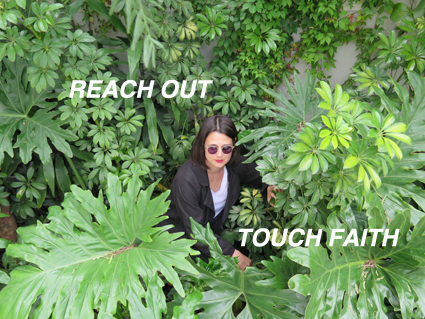
Sarah Rodigari, courtesy the artist
Going Nowhere is not a festival. That’s the first thing Arts House’s creative producer Angharad Wynne-Jones makes clear. She describes the three-day event as more of a “strategy or proposition,” and that proposition is one that gets more and more compelling the deeper you dig into it. Arts organisations have been getting down to the nuts and bolts of sustainability for some years now—theatres sport solar panels, venue bathrooms have reduced water use, programs have gone online—but Going Nowhere takes as its starting point a question. “What’s the trickiest thing that we would least like to do without?” asks Wynne-Jones.
The answer is travel. “For many artists their development is hinged on national and international partnerships, tours, institutional exchange and attending conferences, fairs, workshops and so on. The whole notion of getting on a plane is often critical to making a project happen,” says Wynne-Jones. “Making a collaboration work, being endorsed and surprised and delighted by being somewhere else.”
Going Nowhere challenges its participants to create international work without stepping on a plane. Of course there are modes of artistic production that better lend themselves to such a challenge, but Arts House has deliberately put it to the sort of cutting edge practitioners it regularly programs, often working in fields such as Live Art that crucially depend on the presence of their makers.
“People have been sending scripts and scores around the planet for centuries,” says Wynne-Jones. “It’s not a new thing. In fact, it’s only quite recently that we think of sending entire symphony orchestras from one end of the planet to the other. But it’s exciting that there’s a whole range of practice that has extended beyond the score or the text, and now how does that practice recalibrate itself through some of those old methodologies but still retain its investigative, experimental form?”
The core of the program might be the series of four commissioned works that see local artists collaborating with others in Cambridge, where Going Nowhere will also take place over the same weekend. Sarah Rodigari and UK artist Joshua Sofaer will confront head-on the fear of missing out posed by a situation in which performing artist and audience aren’t available to one another—in this case employing a surprising surrogate. Willoh S Weiland, Julian Crotti and Fritz Hauser are creating a highly theatrical Last Supper-scenario exploring the apocalyptic End Times thinking that accompanies much discourse around climate change, while a collaboration between Melbourne’s one step at a time like this and Bristol’s Helen Cole and Alex Bradley takes place in both Arts House and the audience’s own homes. Dan Koop, Andy Field and Nathan Street’s collaboration is both site-specific and transcendent of that notion, employing the ubiquitous transport loops that are available in almost every modern city—think train subways, monorails or free tram services—that tourists use to go nowhere but see everything.
“The brief that we’ve set is that we are wanting a live experience,” says Wynne-Jones. “We’re committed to that, even though all the digital possibilities exist and apparently make it seem like anything’s possible. There has to be a reason the audience needs to be there. The work can’t be completed without them. That’s potentially limiting, but that’s the discipline of it.”
Another appropriate restriction is that artists are not allowed to create waste. Purchases should be minimal and limited to recycled or recyclable material. “They have an extremely light touch in that way.”
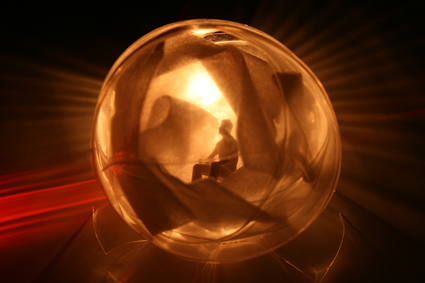
Tanya Beer, Weather Report
courtesy the artist
Tanya Beer, Weather Report
Beyond the international commissions, Going Nowhere features a sizeable suite of events, including a Tipping Point forum, PechaKucha, and several other artworks. Olaf Meyer is creating a new textural projection to transform the face of the North Melbourne Town Hall; Tristam Meecham is bringing together a range of specialists who traverse an unexpectedly wide interpretation of sustainability—from frog experts to storytellers—to create an Everyday Imaginarium on the Town Hall’s balcony garden; and Tanja Beer’s People’s Weather Report is a 24-hour sound work and installation drawing on contributions from around the world.
While it’s one thing to ask artists to rethink their own practices in order to produce a work that can cross borders while they stay put, Going Nowhere’s sheer mass poses a broader dilemma. Specifically, it highlights questions of trust that go beyond the individual maker—“not just between the collaborating artists but between the producers and the presenters,” says Wynne-Jones. “Without their artists being there, we need to be really clear that we’re honouring what we imagine they want as much as what they’re demanding that they need. I also think it involves a level of trust from the audience. We’ve been enculturated, and with good reason, into wanting and enjoying the artist’s presence. Particularly in this kind of work. To say they won’t be there is challenging.”
Wynne-Jones admits that everyone behind Going Nowhere is “setting ourselves up with an impossible problem.” The weekend isn’t aimed at producing definitive answers that will only allow for 100% sustainable works to be created from here on. Wynne-Jones herself isn’t interested in only presenting works by artists working in that way throughout the rest of the calendar.
“To be honest, I think the only people that need to be flying around the world are artists. I think they’re the best transmitters of ideas and energy and connections. Once we’ve found some kind of biofuel for aeroplanes they should be filled with artists zipping around.”
But in the meantime, she does hope that Going Nowhere will expand beyond Melbourne and Cambridge in years to come. She makes it sound like a very attractive notion. “My fantasy structure for Going Nowhere in the future is that there could be any number of organisations around the world that over a particular period of time say ‘we’re Going Nowhere’ and there’s a repository of projects that have been designed in this way and the organisations can buy one or borrow one or create one or whatever. This is a rehearsal of that.
Going Nowhere, Arts House, Melbourne, 21-23 Nov. Full program at goingnowhere.net.au.
RealTime issue #123 Oct-Nov 2014 pg. 12
© John Bailey; for permission to reproduce apply to realtime@realtimearts.net
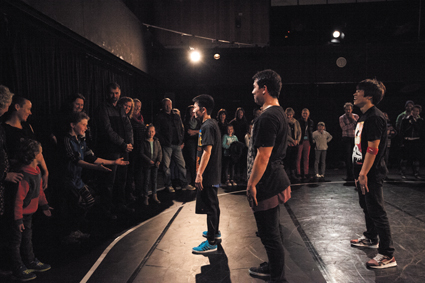
Cypher, Nick Power, Junction Arts Festival
photo Melde Ruyter
Cypher, Nick Power, Junction Arts Festival
In an early interaction with a local, I ask what he is most looking forward to seeing at Launceston’s Junction Arts Festival in 2014. As we flick through the program guide together he remarks, “This isn’t really an arts festival. It’s more an events festival.” He’s instantly a little embarrassed at his apparent ignorance about what constitutes ‘art.’ What he had picked up on though is at the centre of the curatorial vision of the festival.
The artworks in the program this year were events. Each project possessed only a subtle artistic frame around an encounter between artist and audience. The works were not just for an audience but also made with and between them. That is the nature of art as event. It is a rupture in which people are necessary. It actively privileges the public, both their gaze and their presence. To borrow a line that I love to quote, but cannot remember where from: “It is not about something, it is something.”
Events took forms that ranged from script-reading to guided walk to dance battle to workshop to party-for-one. They were situated in a range of places—theatre, gallery, shop-front, warehouse, function room, park, car park, river and other public sites across town. The event-ness of these projects offered the potential to invite Launceston audiences to displace their typical status as subordinate to an artist and their artwork and instead take on their own agency and active interpretation within the established framework.
Nassim Soleimanpour, White Rabbit, Red Rabbit
There was palpable excitement in the audience of largely conservative local theatre subscribers upon entering White Rabbit, Red Rabbit. We walked through the grand auditorium of The Princess Theatre and onto the stage. A meta-stage had been demarcated in white electrical tape, around which the audience sat in rows of chairs. Theatricality in terms of lighting and sound is renounced, and the set is simply a ladder, a table, and two glasses of water. A local actor enters carrying an envelope. He opens it and removes the script for the show. It is the first time he’s seen the text. He reads it to us.
The performance focuses on the presence of the audience, co-opting members into acting out scenes and noting biographical information on the Iranian writer and his life which we are both removed from and largely ignorant of. There is a joyous charm to be had in experiencing the actor attempting to fulfill what is stipulated in his script. Ultimately the work is a confrontation with the words he speaks: words via which the playwright has ‘travelled’ to Launceston, in order to conjure the performance through this intermediary. Everyone present is unified through the event of the script-reading. We have moved beyond a representational theatre experience and into the theatrical experience of an event. Because of this, a collective voice of the audience takes over the work in the concluding moments of the show. Despite what feels like a far-fetched provocation in the text, the majority in attendance band together to prevent the actor from drinking the glasses of water that have been said to be poisoned. Indeed, the actor too appears somewhat worried about the possible result.
Nick Power, Cypher
In Cypher we have another performance space demarcated in white tape. This is a break-dancing circle, known as a ‘cypher.’ In it the codes, conventions and gestures of ‘breaking’ and ‘battling’ are abstracted and appropriated by four break-dancers towards making a contemporary dance work that alternately has the performers competing with each other and dancing together. The cypher circle continually fluctuates and is literally deconstructed and reconstructed by the performers. The treatment of space mirrors the treatment of the break-dance practice and brings the audience in close, looks them in the eye, and encourages them to treat this cypher as the real deal.
The cypher eventually multiplies and the audience co-inhabits these spaces with the performers, before the performers hand them over entirely to the audience who dance within them. What the audience perform is shameless parody, a by-product of the representation and consumption of mediatised subcultures. As the light slowly fades, the show ends with a poignant moment of silence, a final repetition of synchronicity: we hear in the breath of the dancers the labour expended in their virtuosity. For a moment they are only human after all, and not that different from us.
Cypher is a thoroughly entertaining demonstration of the ‘breaking’ subculture. Sequences condense and repeat as rituals move towards the cathartic threshold of collapsing the work’s dance form and including the audience in an event that continues in the space post-show as enthusiastic children play at the break-dancing moves they have just seen.
Big One Little One, Confetti
After standing in a line for a little over 30 minutes I am instructed to knock on a door. It opens with screams of delight and two young women pull me into a tiny room. Silver streamers line the walls. I am offered a shot of vodka. I am spun around and instructed to strike a piñata. I am presented with a birthday cake and told to blow out its solitary candle. We dance. They strip a layer of clothing. Confetti is thrown. It’s over. I am ushered out. The concentrated joy of the minute-long work Confetti, by Australian collective Big One Little One (NSW-VIC) was the representation of a party rather than a genuine party-event. It was the formulaic machine of a party performed identically on repeat, with the audience as the anonymous trigger. The subject celebrated was the rather dehumanising act of partying itself—relentlessly and forever, and in a bittersweet way, always wanting something more.
Abigail Conway, Time Lab
UK artist Abigail Conway’s Time Lab performance exemplified one of the subtlest artistic frames at the festival. It takes the form of a workshop in which we individually make items of jewelry out of broken wristwatches. We are greeted in a shop-front by the artist and briefed on what is to happen. We are directed behind a curtain where a clinical workshop laboratory has been set up. There is an individual station for each of us, with all manner of utensils we will need for our arts and crafts session. The artist then leaves us entirely to our own devices, informally focused on making something of our time. The artist is there to provide assistance, but only really addresses us again to encourage us to finish when the hour-long workshop is nearly over. She then wants to document our pieces and have us answer personal and conceptual questions on the idea of time, for a publication that will provide a bigger picture of the travelling project.
The work privileged the workshop event over any sort of artistic conceit and was essentially handed over to us as genuine workshop participants. We became bricoleurs, for the artist and for ourselves, of transience itself. Timepieces of course are not time itself, but act as our representational measuring devices as we vainly attempt to control it. In Time Lab that representation is reconfigured into a personalised decoration—we each left with an individual pearl that somehow managed to personify the formlessness of transience.
Junction Arts Festival, 10-14 September, www.junctionartsfestival.com.au
RealTime issue #123 Oct-Nov 2014 pg. 14
© Malcolm Whittaker; for permission to reproduce apply to realtime@realtimearts.net
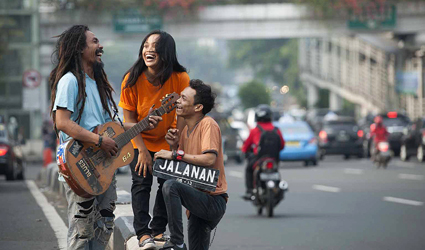
Jalanan
In an age in which many people’s experience of popular music comprises corporatised pre-packaged pap masquerading as televised talent quests, it’s easy to forget what a powerful agent of change music can be. An unexpected thread affirming the possibilities of musical expression bound a diverse range of documentaries at this year’s Melbourne International Film Festival (MIFF).
Jalanan
This debut feature from Canadian-born, Bali-based Daniel Ziv was the surprise hit of MIFF, deservedly taking out the People’s Choice Award for Best Documentary. Mixing casual interviews and observational footage, the film sparkles with the personality of its three subjects—Ho, Boni and Titi—as they eke out a living busking on Jakarta’s public buses. They don’t rely on regurgitated Neil Young songs however. These performers often pen their own tunes, rife with satire and loaded political comment. At one point, for example, we hear the dreadlocked Ho calling for Indonesia to hang officials who have corrupted the nation. Boni also sings of current events and life on the street, drawing on his experiences living under a road bridge for the last decade. Titi is one of the few female buskers working the capital, using her sweet voice to support herself as she tries to gain a high school certificate as a mature-age student.
Over the five years traced by the film, the lives of Ho, Boni and Titi undergo some radical and unexpected transformations. Despite the hardships they endure, the overriding tone of the film stresses empowerment through creative expression, a feeling reinforced by Titi’s presence at the MIFF screenings. A season of Jalanan at a Jakarta cinema has apparently made Titi something of a star in her homeland, and she played at several campaign rallies for the popularist new president-elect, Joko Widodo. An inspiring story about our rapidly transforming northern neighbour.
Pulp: A Film About Life, Death and Supermarkets
Expecting another standard issue rockumentary, I’d skipped over Florian Habicht’s film about British rock act Pulp when making my MIFF selections. But a ticket landed in my hand at the last minute through a stroke of luck for which I’m now grateful. Unlike most rock documentaries, Habicht’s film doesn’t take the viewer’s love of the band for granted. In fact, the film is only peripherally about the group. Its real interest is in the origins of Pulp’s music on the streets of Sheffield, and what their songs mean to those who live in the city. This very un-hagiographic approach is all the more surprising given the film was made in collaboration with Pulp’s frontman, Jarvis Cocker.
Habicht structures his film around Pulp’s final concert in their northern hometown at the end of a 2012 reunion tour. In the days leading up to the gig, he talks informally with Cocker and other band members, as well as many people on the streets of Sheffield. The diehard fans are here, as you’d expect. But so is a wonderfully eccentric newspaper hawker, a former colleague of Cocker’s in a local market, a wayward young couple living rough, and a range of elderly locals who would have been grey even in Pulp’s heyday of the mid-1990s.
The result is a cross-generational ode to the importance of popular music in British culture. It’s a measure of the film’s achievement that I came out a Pulp convert—not so much for what I saw of the band, but for the down-to-earth honesty they convey through their involvement in a down-to-earth project. Pulp: A Film About Life, Death and Supermarkets is a timely reminder of just how intelligent and poignant pop music can be.
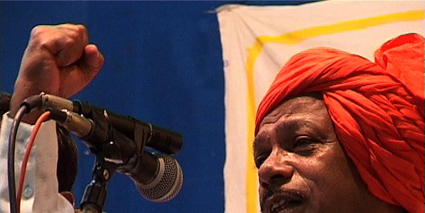
Jai Bhim Comrade
Jai Bhim Comrade
Part of MIFF’s India in Flux strand of contemporary documentaries from the subcontinent, Jai Bhim Comrade is an epic work from one of India’s master documentarians, Anand Patwardhan. Fourteen years in the making, it traces the struggles of India’s Dalit Caste (the so-called “untouchables”) in the wake of a massacre by police at a protest in 1997. It does so from a grassroots perspective, homing in on Dalit activism through performance and song.
The level of detail presented here through interviews, voiceover narration, observational footage and videoed performances is not easy to digest, especially for viewers not familiar with India’s complex history or intricate caste system. But Jai Bhim Comrade provides a fascinating insight into the country’s recent political upheavals from a point of view we never see on nightly news bulletins.
The film begins with the death of Dalit singer Vilas Ghogre, who hangs himself in the wake of the 1997 massacre. Over the next decade and a half we follow attempts to bring the police involved in the killings to justice, as well as the broader fight for empowerment of the Dalit caste. All of this takes place against a backdrop of rising Hindu nationalism, signified by the ascendance of the Bharatiya Janata Party (BJP). Frighteningly, Patwardhan’s camera shows that due to a systematic campaign of disinformation by the BJP confusion reigns in the Dalit community about who was in government in 1997.
Jai Bhim Comrade concludes with the police commander who ordered the 1997 shootings finally sentenced to life imprisonment, 14 years after the event. He is released a week later, pending an appeal that is yet to be heard. Meanwhile, Dalit musicians of the radical Kabir Kala Manch group, who perform pro-democratic, anti-caste plays and songs in rural villages, are forced into hiding as they are accused of links with Maoist Naxalite rebels.
Jai Bhim Comrade is engrossing if challenging viewing for anyone wanting to better grasp the social dynamics at play in present day India and the country’s politicised street-level culture.
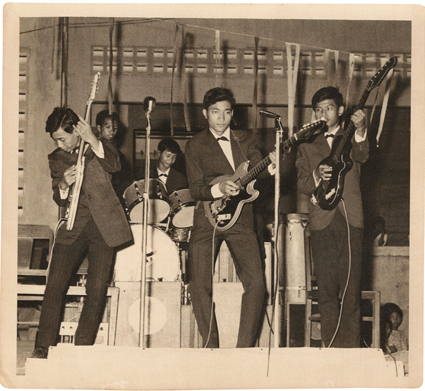
Don’t Think I’ve Forgotten: Cambodia’s Lost Rock and Roll
Don’t Think I’ve Forgotten: Cambodia’s Lost Rock and Roll
In the spirit of Golden Slumbers (Davy Chou, 2012), a documentary about Cambodia’s vanished cinema, John Pirozzi’s Don’t Think I’ve Forgotten attempts to unearth the lost history of Cambodian popular music of the 1950s, 60s and 70s. Although the film’s subtitle reads “rock and roll,” the nation’s pop of the era comprised a diverse array of crooners, Latin-Cuban dance bands, folk singers and surf guitar groups.
Pirozzi tries to cover a lot in two hours. As well as 25-odd years of music history, he sketches the political backdrop of the war in neighbouring Vietnam and the disastrous impact it had on Cambodia. A US-backed coup against the neutral government of Norodom Sihanouk in 1970 provoked a civil war that led to the genocidal Khmer Rouge regime taking control of the country in 1975. Khmer Rouge rule extinguished virtually all forms of culture and resulted in the death of around a third of the population, including many famous musicians.
With so much to cover, Don’t Think I’ve Forgotten is more about breadth than depth, but the film snappily conveys the joy popular music brought to Cambodian society as it opened up and diversified during the relatively stable years of Sihanouk’s rule. Soberingly, the film also illustrates how culture provided little defence in the face of a regime as murderous as the Khmer Rouge.
If films like Don’t Think I’ve Forgotten and Jai Bhim Comrade show some of the limitations of music as a form of cultural resistance, they also affirm that whatever the vicissitudes of history, grassroots creative expressions can always be found pulsating beneath the surface of every society. Through the unexpected connections running through these very different documentaries at this year’s MIFF, audiences were reminded of just how much music can mean when it comes from the heart and speaks to the lives of everyday people.
Melbourne International Film Festival, various venues, 31 July-17Aug
RealTime issue #123 Oct-Nov 2014 pg. 16
© Dan Edwards; for permission to reproduce apply to realtime@realtimearts.net
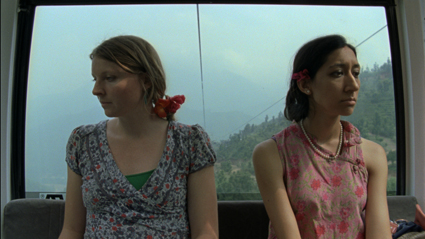
Manakamana, Stephanie Spray & Pacho Velez
Almost 25 years after the onslaught of post-colonialism in academic discourse—a well-intended yet passive-aggressive critique of preceding generations of colonisation and imperialism which shaped the concept of a ‘third world’—contemporary documentaries intent on capturing those terrains have rarely broken away from the leftist-humanist slant born of those ideologies.
While musicologists work similarly to televisual and documentary ethnographers and anthropologists, musicians and their audience rarely work this way. From Ska to Electro to Rai to Jungle to Reggaeton to Congotronics (to name obvious contenders), music has not once stopped performing as a living language, born of local conditions, shaped by transformative confluences and completely conscious of its shape-shifting identity. When industry and culture clash, it’s the stuff of people getting together and making noise despite the determining semantics of their chosen tools, instruments, processes and sounds. The resulting music dictates its own hybrid identity with its own voicing, no matter how incorrect, contradictory or unsuitable its appearance.
So what happens now when music-making and documentary practices intersect? Mostly, it’s the same old post-colonial lip service being voiced despite the styles employed. Openly problematising freshness comes from the efforts of the Sensory Ethnography Laboratory, an experimental yet institutional filmmaking venture and program established in 2007 at Harvard University. Its varied results are linked by a willingness to explore cine-doco-televisual modes of encoding and inscription which forward an excess of documented data (visual and/or aural) while attempting to refrain from narrational, discursive and/or determining modes of address and commentary. It’s a utopian impulse for sure—one born of the power of poetics overcoming didacticism—yet the after-effect of this slant on documentary practice has enhanced and accentuated how sound (and by inference, music) shapes the end results.
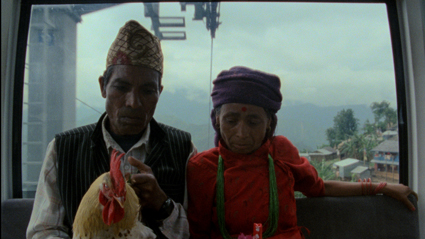
Manakamana, Stephanie Spray & Pacho Velez
Stephanie Spray & Pacho Velez’s Manakamana (2013) is possibly SEL’s most advanced example in this respect. The documentary is a suite of uninterrupted single-shots of one-way journeys in a cable-car strung high over hilly and terraced heights in Nepal, either to or from a Hindu temple at the uppermost stop of the ride. Each shot simply shows the car’s inhabitants (singles, duos and trios) sitting facing a fixed-tripod camera. Shot on Super-16mm but recorded in full and crisp digital audio, the inhabitants occupy most of the frame; we witness them observing everything we can’t fully see (beyond the layer of glass visible behind them), plus they often acknowledge the camera in a casual and nonplussed manner. It’s amazingly open in its procedure and its contents: the results are starkly experimental yet the means of production are thoroughly disclosed and evident. The surfeit of detail and the complexity of subtle inflections captured make for riveting viewing and auditing—the deliberately dumb automaton camera-work and the knowing tedium of its temporality seem to enforce rather than limit this.
Now, many critics have interpreted Manakamana in terms of ‘honesty,’ ‘truth’ and ‘reality’ due to the nature and conceit of its production. But I wonder if such knee-jerk support for ‘keeping-it-real’ documentary tropes misses the greater audiovisual complexity of the film. For many people, the absence of music and the removal of a narrational voice-over can create a ‘shock of the real’ while preventing them from realising how a documentary’s codes can determine their experience. In line with the SEL’s codes of practice, Manakamana is intent on exploring how an audience’s experience can be reconfigured by engaging with the documented material in a new and expanded way. And the locus of this activity is on the soundtrack.
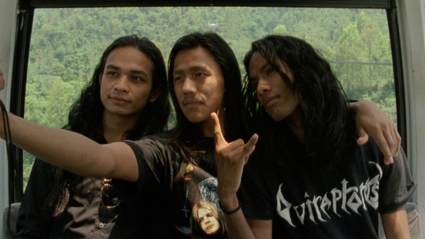
Manakamana, Stephanie Spray & Pacho Velez
Firstly, the film crystallises the contradiction between visual and aural modes of inscription: its grainy patina collides with its hyperreal sonics. The closer you squint at its images projected large (in the 2014 Melbourne International Film Festival), the deeper you fall into the swimming grain of the film’s abstracting surface. But the closer you listen to the soundtrack, the more you perceive the complex networking of occurrences which comprise the real-time synchronous passage of time and space in each cable-car journey. Plus, one hears much activity equally beyond the camera frame and beyond the cable car. In an evocative gesture toward self-reflexivity, the cable car becomes a type of camera obscura, positioned to be embodied within the world while encoding its place within that world.
Secondly, inasmuch as the cable car is a camera obscura, it is also a recording booth. Its domain centres the spherical immersive experience of sound all around—especially in a suspended cable car high off the ground— and translates to us a similar ‘other-worldly’ experience of the depicted environment as one which floats the listener in sound’s totality. This is a supremely ‘non-screenic’ effect. The bulk of all cinematic effects is predicated on an illusory window-on-the-world, which in turn is derived from the sensation of situating an audience in a black void box to witness images which appear to come from a zone beyond/behind the screen. Conversely, Manakamana documents its sensory environment by situating the imaginary ear smack in the middle of the world it visually captures.
This ‘non-screenic’ effect is highlighted by the thunderous shuddering clackety-booms which intermittently occur when the suspension cable passes through the structural towers dotted along the cable car route. Rather than mute these moments or mix them down, the film fully captures the sensation of being jolted by these markers of the film’s cyclical journey. Sharp transients, whelps of bass and peaks in volume shake everything: the car, its inhabitants and the cinema itself, as the booms erupt the otherwise pastoral appearance of the film’s contemplative tone. But soon enough, one is accustomed to these jolts just as the on-screen passengers appear inured to their disruption, and the film synchronises to the inhabitants’ relaxed relation to their environment.
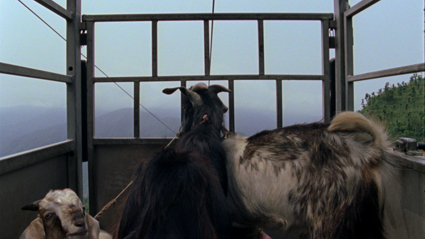
Manakamana, Stephanie Spray & Pacho Velez
But perhaps the most noticeable aspects of Manakamana’s soundtrack arise from the placing of music within this anthropological laboratory. From a trio of metal band members enthusiastically taking selfies, preening their hair while quoting/singing phrases of local folk songs from the radio, to what might be a father and son musical duo who say little but spend most of the time tuning their sarangi while playing a traditional song, the film powerfully captures the vibrancy of music as a lived language. The absence of preciousness with which these ‘characters’ breathe music while engaged in apparently oppositional activities proves how ‘second nature’ music can be, produced and experienced by musicians regardless of any contextualising or determining framework of its presentation. By the time we get to a cable car ride with five goats, one starts to even appreciate the animals’ responsive bleating as a meld of music, language and sound.
In a contemporary climate wherein everyone and everything is desperate to humanise, well, everyone and everything, Manakamana doesn’t simply provide momentary respite from this pathetically saturated realm of utopian well-wishing: it actively, materially and formally foregrounds how a commitment to an informed aesthetic practice can unleash a broader and more encompassing politics of representation. Watching the movie will only reinforce limp leanings towards the very humanism the film potentially combats. Listening to it subjects us to audiovisual incidents and environments that circumnavigate illusory humanism by instilling one with a breathtaking sense of our own insignificance.
–
Manakamana was the winner of the Golden Leopard award, Filmmakers of the Present, Locarno Film Festival
Stephanie Spray & Pacho Velez, Manakamana, 2013, 118 mins, Melbourne International Film Festival, 7, 10 Aug
RealTime issue #123 Oct-Nov 2014 pg. 17
© Philip Brophy; for permission to reproduce apply to realtime@realtimearts.net
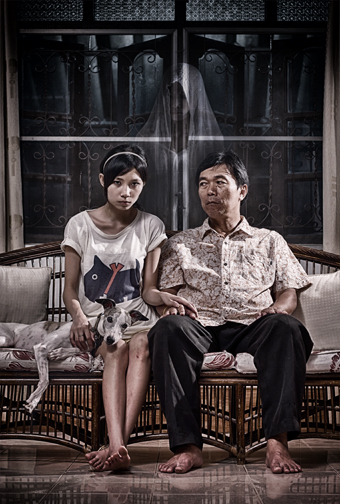
Chanthaly
It was with heady anticipation that I arrived in Hobart for the third annual Stranger With My Face Horror Film Festival. Voted one of the “Top Five Coolest Women’s Film Festivals in the World” by readers of Movie Maker magazine, SWMF was started by Hobart-based filmmakers Briony Kidd and Rebecca Thomson as part of Women in Horror Month, the February-based initiative founded in 2010 by US writer/filmmaker Hannah Neurotica, which aims to highlight female directors working in a heavily male-dominated genre.
SWMF took root after Kidd’s short film, The Room at the Top of the Stairs, was shown in another women’s horror film festival, the LA-based Viscera Film Festival. “That’s all I wanted to do initially in 2012, just screen some of the Viscera shorts as a Women in Horror Month event in Hobart. But there were other films that I wanted to include as well, and then we wanted to have talks and a script comp, and it very quickly became its own thing. So we ran with it and called it Stranger With My Face (after the Lois Duncan YA novel) because the kind of horror I’m most interested in as the programmer of the festival concerns the ‘horror within’ rather than your more straightforward external threat.”
This year’s four-day program boasted five feature films, Australian and international shorts programs, children’s workshops, a symposium, exhibitions, play readings and the popular 48-Hour Tasploitation Challenge—a short film competition open to all. It opened officially with Ann Turner’s 1988 feature Celia.
Celia is a remarkable evocation of an Australian childhood whose terrors, enmities and fantasies transform, in response to 1950s political paranoia, into something jagged and dangerous. Child star Rebecca Smart’s unaffected yet compelling presence in the title role is supported by an accomplished cast and Geoffrey Simpson’s expansive cinematography. Chris Neal’s chiming score contributes strongly to the sense of an eerie childhood netherworld. The film’s detours into fantastic surrealism, gradually dovetailing with moments of real-world violence, led Kidd in her introduction to name Celia as a precursor to Peter Jackson’s Heavenly Creatures (1994).
Opening a horror film festival with a ‘non-horror’ film, albeit one with horror elements, might be unconventional, but the decision to spotlight this lesser-known classic proved astute, for Celia introduced significant themes that resonated in the festival films to follow: unflinching identification with a female protagonist; retreat into a mythic woodland world in which (often violent) empowerment is found; and the conflicted identity suggested by SWMF’s title.
Running alongside the film program was the Mary Shelley Symposium, taking in traditional fairytales, Tasmanian Gothic, the children’s bogeyman in contemporary cinema and an illuminating history of women in horror. Common themes snaked their way through symposium and film program. Says Kidd, “The two are programmed side by side, but I wanted it to feel like they were riffing off each other in various ways. For example, Emily Bullock talked about Tasmanian Gothic and The Tale of Ruby Rose (1989) and we screened the short film Little Lamb, which is a new example of Tasmanian Gothic and the director’s mentor in making it was Roger Scholes, the director of Ruby Rose. I also realised there was a fairytale element to a lot of the films I was considering…so adopted that as an informal theme across the program.”
The Australian shorts program ranged from gorily irreverent to haunting and melancholic. Splatter gags were plentiful in Mia’Kate Russell’s queer werewolf farce Swallow (2013) and Caitlin Koller’s Maid of Horror (2013), which sees a bridesmaid usurping her friend’s big day in the bloodiest possible way. In contrast, Victoria Thaine’s The Kingdom of Doug (2013) was elegantly sparse, its subdued mood enhancing the cultish horror at its centre. Little Lamb (2014) gave us a convict-era Bluebeard with Tasmania’s dark rural landscape as grim backdrop.
International shorts were similarly eclectic. Grace Under Pressure (Jen Moss, UK, 2014) presented a cheeky spin on the wish-granting fable, while conversely, Hide and Seek (Kayoko Asakura, Japan, 2013) moved with beautiful clarity of composition from calm through to suspense, terror and ultimately horror. The standout was Substance (USA, 2014), Barbara Stepansky’s immersive, hallucinogenic account of two friends unwittingly bringing an alien powder to a winter music festival.
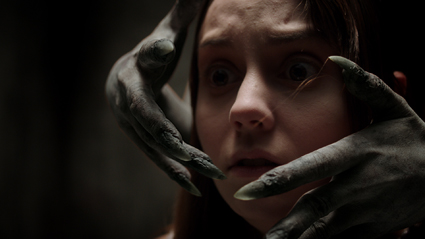
Evangeline, Karen Lam
The intense identification with a female protagonist—even beyond death—found radical expression in the festival’s ‘victim narratives’: feature films Evangeline (Karen Lam, 2013) and Kept (Maki Mizui, 2014). Partially inspired by a long series of unsolved murders of young women in British Columbia, Evangeline begins with its titular heroine (Kat de Lieva) escaping a restrictive upbringing for the excitement of college life. Lam develops this part of the narrative as though it’s a gentle coming-of-age film, allowing Evangeline to blossom as a character before, in a brutal turn of the tables, she is violently assaulted by young men she trusted and left for dead in the woods. The film now enters a subterranean world of heightened violence where fantasy and reality combine to hammer home the heroine’s suffering and rage.
Kept is, most disturbingly, based on its director’s personal experience of an abduction—faithfully reproduced, according to a Skype interview post-screening, in the film. Her attacker would subsequently go on to violently rape another young woman. Dealing with Mizui’s guilt at not reporting her attack sooner, Kept is the most difficult SWMF film to watch. Its bald detailing of sexual violence is unflinching, though the main character’s retreat into animist woodland fantasy offers some respite. It is hard not to be reminded, while watching Kept and Evangeline, how completely they upend conventional crime/horror narratives where an unformed female character is raped or murdered purely to drive the plot and further the character development of an often male protagonist and his antagonist. In Lam and Mizui’s scenarios, the viewer must remain with the victim; there is no escape from the suffering she endures, nor its consequences. The closest relative to these depictions might be the rape revenge movie, but Evangeline and Kept are deeply personal; far less formulaic.
Ground-breaking too, for different reasons, was SWMF’s closing film Chanthaly (2012), Laos’ first horror film and its first from a female director, Mattie Do. Made, astoundingly, for under $5000 and shot entirely in Do’s home, Chanthaly’s limitations work to its advantage, painting a claustrophobic picture of a young woman’s sheltered life in middle class Vientiane. The supernatural makes its presence felt ominously yet quietly. Do’s discussion afterwards with Indonesian-Australian filmmaker Katrina Irawati Graham covered the pressures and pitfalls of making a horror film in Laos, ranging from being arrested (due to Do’s recent emigration from the US) to having to justify to government officials the inclusion of scenes depicting hand-holding and a female lead wearing pyjamas.
This exploration of different perspectives and shaking up of familiar narratives is something that horror, a naturally transgressive genre, can pursue to great effect, but often does not. That SWMF showcases films outside of horror’s ‘safe zone’ makes it genuinely exciting. As Briony Kidd explains, “I’m looking for films that have something to say. There’s an assumption that genre is mainly escapism but, to me, there’s so much scope in horror to be provocative or extreme or personal or original, so why wouldn’t you take advantage of that?”
Stranger With My Face Horror Film Festival, University of Tasmania, Art School and Salamanca Arts Centre, Hobart, 21-24 Aug
RealTime issue #123 Oct-Nov 2014 pg. 18
© Katerina Sakkas; for permission to reproduce apply to realtime@realtimearts.net
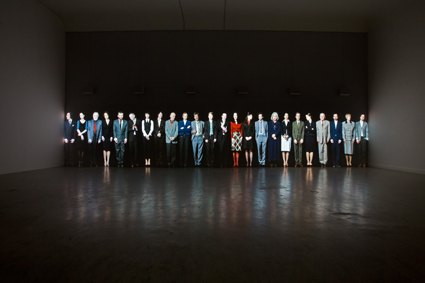
Kris Verdonck, Gossip
photo Kristof Vrancken
Kris Verdonck, Gossip
In the absence of Sydney Spring Dance (abandoned by Sydney Opera House after the 2013 season on the grounds of cost), Performance Space has done Australian dance proud in its SCORE season with works by Antony Hamilton, Natalie Abbott, Narelle Benjamin, Gail Priest and Jane McKernan, plus an installation by Belgian director Kris Verdonck. Collectively, the works demonstrated the ever-expanding conceptual and theatrical dimensions of what we understand to be contemporary dance.
Kris Verdonck
Kris Verdonck’s installation-performance video Gossip comprises a human-height screen running the length of a wall in one of Carriageworks’ Tracks. Standing in the otherwise empty, dark space we come face to face with a row of people, including the artist, oddly all of the same (digitally engineered) height though of a fascinating range of body types, physiognomies and fashions that are pretty close to our own. Perhaps they are, like us, a first night audience at the theatre or in a gallery. At first glance they appear to each stand alone, if shoulder to shoulder, some smiling, a few disinterested; but small turns of the head and discreet mouthings while staring directly at us suggest they are passing judgement in pairs and then, in trios and larger ripples along the line, gossip. It’s amusingly discomfiting and fun to witness emergent groupings and surprise when the whole gathering performs unanimously. It’s rather like the pleasure of watching Pina Bausch’s parading of her performers—each figure idiosyncratically attractive to our promiscuous gaze but the whole company enticing in itself.
At the New Media Dramaturgies conference opening on the same night, Verdonck spoke of his audience as “projecting onto his work.” Showing us video of his fascinatingly bizarre creations he described his aim as trying “to get actors to be as authentic as objects,” sometimes submitting them to the unpredictable—a Swan Lake passage in which the dancers are suspended such that they cannot properly execute their moves (“an elegant body-machine”). He imagines an equivalent “actor-machine.” While quite genteel next to Verdonck’s other sometimes violent works (focused, he says, on“one state of being, not an image”), Gossip though cleverly machined is open, subtle and certainly performed.
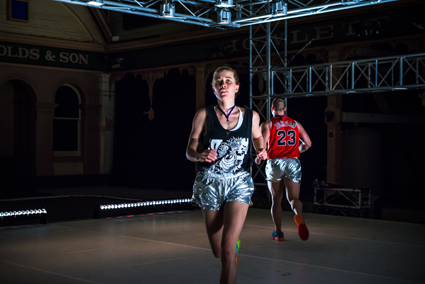
Natalie Abbott, Donny Henderson-Smith, Maximum
photo Gregory Lorenzutti for Dancehouse
Natalie Abbott, Donny Henderson-Smith, Maximum
Natalie Abbott, Maximum
Maximum, a work of labour-intensive minimalism, exploits the bodies of a dancer, Natalie Abbott, and a bodybuilder, Donny Henderson-Smith, whose cultural and personal aims in life might be very different but who share capacities for precision, strength and endurance. The pair is presented as a team (black singlets, silver shorts, the latest gym footware), jointly exercising to a strict routine that takes them from the unison pacing out of squares, circles and diagonals to a range of exercises, including lunges and, unusual for a gym workout, dance-like toe-pointing, swimming-like floorwork and barking while on all fours. The increasingly demanding exercises climax with a doomed attempt by Henderson-Smith to support Abbott as she stands, leaning far forward, on his thighs—it’s as much an effort for her as for him, her runners losing traction on his slippery shorts. Even before this series of collapses the strain on both performers has been evident, the bodybuilder less able than the dancer to sustain precise movement and rhythm.
Maximum is by turns calculatedly clinical (observe the routines, the sweat, the amplified breathlessness), fascinating (the contrasting body and skill types), funny (satirical at the expense of gym regimes), frustrating (repetition and failure) and—if you empathically ‘run with it’—rewarding. In RealTime Profiler June 30, Abbott told Gail Priest, “It’s about asking an audience to come up to that same level of intensity as the performers, asking [them] to persist with us and engage in a different way than in a more obviously spectacular dance show…” Maximum nonetheless has its share of striking theatricality: a stark white tarquette and a low-slung stylish lighting grid (the lights symmetrically arranged in the current fashion) comprise a perfect starkly illuminated cube suggestive of both gym and laboratory. Dan Arnott’s live sound likewise heightens our attentiveness, homing in on and treating the sounds of bodies at work.
While a logical extension of Abbott’s impressive Physical Fractals (RT114; identical-looking dancers working in unison and generating the sounds that Arnott treats), Maximum is not so obviously a dance work but it is the creation of a choreographic sensibility. It’s interesting to see that the dramaturg for Maximum is Matthew Day, an exponent of very idiosyncratically shaped works to which no obvious meaning can be attached however suggestive they are moment by moment in the dancer’s intensely vibrating body. Unlike Physical Fractals and the Day trilogy, Abbott’s Maximum makes visual poetry of something which we can recognise—exercise, its banalities, demands and, possibly, revelations.
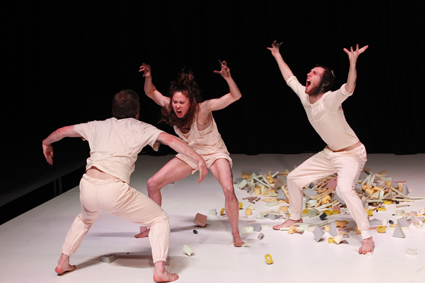
Lauren Langlois, Benjamin Hancock, Alisdair Macindoe, Keep Everything, Chunky Move
photo Jeff Busby
Lauren Langlois, Benjamin Hancock, Alisdair Macindoe, Keep Everything, Chunky Move
Chunky Move: Antony Hamilton, Keep Everything
The title of Antony Hamilton’s Keep Everything apparently refers to the choreographer’s desire to use leftover ideas from previous projects in his new work, rather than waste them. That information is incidental but Hamilton does conjure a world in which humans comprise their contemporary condition, their simian ancestry and well-worn fantasies of cyborg selves. We do keep everything, although usually barely aware of it.
As science increasingly details the oscillation between genetic and social forces in our evolution as a species we learn how much of our ancient past is still embodied in us. We keep everything in our DNA and hang onto much of the inherited cultures over which we obsess. We also learned long ago to speculate, thanks to the development of language and the conceptual sharing it allowed. So it’s not surprising that Keep Everything is speculative or that one of the three performers delivers a talk, posing questions about our similarity to other species in terms of social structure, our use of codes, but also pointing to our distinctive preoccupation with meanings and feelings. Elsewhere the performers, computer-like, flawlessly churn out spoken number series or signal eloquently, with human fluidity—but later robotically fast in the exacting dance passage that completes the work. As well, we witness our prancing simian selves, the performers almost but not quite on all fours, and a bizarrely funny dog-man. ‘Everything’ includes not only our past and future but also our affinity with other species.
Steven Mithen in The Singing Neanderthals posits language as having evolved out of gestures, calls and dance. Humans, like some other species, are dancers but we have codified and conceptualised dance and now, more than ever, use it to express ideas of a complex order, well beyond ballet narrative and formalist abstraction. Witness not only Keep Everything but also in the past-present-future vein ADT’s Devolution and Be Your Self and Chunky Move’s Glow and Mortal Engine as well as Hamilton’s post-apocalyptic Black Projects 1 and 2 in which Carl Nilsson-Polias detected an anti-humanist vision (RealTime, Dance Massive, 2013). At the end of Black Projects 1 the two strange graffiti-ists disappear into their art and in part 2 human-like creatures build themselves yet another religion.
Not everything in Keep Everything is dance, which is hardly uncommon these days, but every bit of it is realised by the performers’ virtuosity in dance, movement, speech and song spectacularly framed in a light-sound-sculpture installation. For the opening minutes of the work we stare into a totally familiar landscape on which lie two piles of initially unidentifiable detritus. The enigmatic beauty of the scene is reinforced by waves of smoke and colour shadings that further complicate our vision. After this immersive opening, figures appear, one retrieved from the detritus, and the work’s initial mutability is then amplified over and over as the three humans themselves transform repeatedly in a world that grows more sonically dense (house music, sci-fi-ish massive synth glides and weirder) and barely categorisable, intense comic book colours prompt us to see anew. This is our world made otherworldly, textured simultaneously with popular culture and big questions. But for all the exhilaration engendered by its maker and his dancers and designers, Keep Everything is a closed circuit in which we do not evolve; we simply are—Hamilton expressing a kind of happy fatalism or offering a necessary antidote to the denialism that has sustained humanism’s belief in our species’ superiority and in progress at any cost.
For more about Performance Space’s SCORE see the reviews of Jon Rose’s Ghan Tracks on page 43, Gail Priest and Jane McKernan’s One thing follows another… on page 21 and Narelle Benjamin’s Hiding in Plain Sight above.
Performance Space, SCORE: Gossip, artist Kris Verdonck, 1-10 Aug; Maximum, choreographer, performer Natalie Abbott, performer, collaborator Donny Henderson-Smith, lighting Matthew Adey, sound Dan Arnott, dramaturg Matthew Day, 27-30 Aug; Chunky Move, Keep Everything, director, choreographer Antony Hamilton, performers Benjamin Hancock, Lauren Langlois, Alisdair Macindoe, Mobile lighting Benjamin Cisterne, sound design Julian Hamilton, Kim Moyes, AV design: Robin Fox; Carriageworks, Sydney, 13-16 Aug
RealTime issue #123 Oct-Nov 2014 pg. 20-22
© Keith Gallasch; for permission to reproduce apply to realtime@realtimearts.net
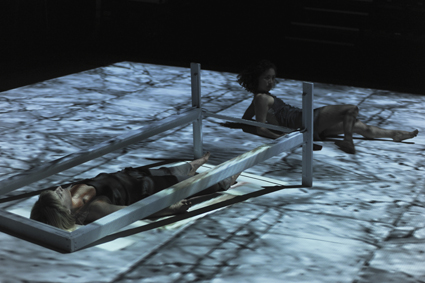
Sara Black, Kristina Chan, Hiding in Plain Sight
photo Heidrun Löhr
Sara Black, Kristina Chan, Hiding in Plain Sight
Hiding in Plain Sight asks for conceptual engagement. Narelle Benjamin draws upon Mircea Eliade who participates in a philosophical tradition that marches toward a holistic return to a self that is fragmented, alienated, empty and without home. Home is more than bricks and mortar; it is being at home with oneself. When this home becomes hearth for others, a re-balancing of the fundamental order of the heart occurs [ordo amoris]. But can we ever be home?
Two cross-legged figures sit facing each other on either side of a doorframe without door. The stage is divided, lasered in half by a white beam, symmetrically left and right, back, front, East, West, dark, light, appearance, reality—all depending upon where one sits in the saddle. The traverse staging sets up an immediate desire to change sides, but only in serving the logic of ‘getting the whole thing at once,’ a suggestion that this is not possible in the condition to which I’m constrained. Window frames without windows hang opposite each other further negating the space with emptiness and filling it with possibility. Doors and windows insist on being opened, closed or left ajar. Without door or window they become mysterious portholes to something else.
Dancers, Kristina Chan and Sara Black nuzzle their necks in a unified nape space, soft, exploratory. Emergent heads cock on a lateral plane in a metronomic beat: 1, 2, 3. This staccato motion posits an underscore of subtle and considered deliberation. We hear voices in a busy market place. Huey Benjamin’s score eclectically rolls out noises of impact: material, poking through a wall of static haze. These weighted sounds curl together then release like the dancers’ spines: tail to head, with the auditory ‘thwack’ of fans: 1, 2, 3. Musically we ratchet from trough to peak in a concertina arrangement cranked between earth and the ethereal.
The identity limit of a form is met vigorously in the dancers’ distal sweeping and wrapping up of limbs: foot pulled to buttock, head arcing to meet points that flip the whole body in transition. Synchronously, they reach with outer tips, taut, then softening, both yielding to the visceral patterns that underlie the beauty of the choreographer’s famed “Nellie’s knots.” This quality of effortless movement is extended through the versatility of the costumes: bodies covered but never lost. Together they deliver other patterns through dancing with fans: the art of not revealing. No longer birds of paradise, they spar, punching and blocking with even touch upon a thin line of separation. Apart, the dancers motor in their spatial halves in idiosyncratic ways. Black sharply accents through torso, arms, fingertips with a bolt of force that propels and slices through the silky contemplative movement that Chan often inhabits—arms behind, tentacles worm with proboscis hands anointing the space. There is an inner/outer dynamic. Sensorial motivations buoy, explode and haunt the choreographic form along its pathway—what lies beneath now in plain sight.
Floating like clouds, Sam James’ black and white floor projections are a cosmological meditation on scale: patterned surfaces magnified, universes miniaturized; a tree grows. The hypnotic motility of these visual symbols gathers all the elements of the dance and brings it almost home.
Performance Space, SCORE: Hiding in Plain Sight, choreographer Narelle Benjamin, performers: Kristina Chan, Sara Black, video Samuel James, music Huey Benjamin, lighting Karen Norris, costumes Justine Shih Pearson, fan designs Victoria Brown; Carriageworks, Sydney 22-30 Aug
RealTime issue #123 Oct-Nov 2014 pg. 22
© Jodie McNeilly; for permission to reproduce apply to realtime@realtimearts.net
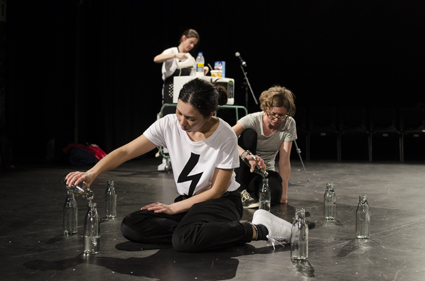
Angela Goh, Lizzie Thomson, Jane McKernan, One thing follows another
photo Lucy Parakhina
Angela Goh, Lizzie Thomson, Jane McKernan, One thing follows another
It may not be a stretch to regard the performing arts today as gladiatorially pitted against the hyperreal X-Factor, The Voice and their like, contests which blur into one, hell-bent on delivering battle after battle of virtuosic talents while needlessly magnifying nondescript personalities.
One thing follows another offers a quieter alternative, taking its inspiration from the humble intermedia explorations of Fluxus, a movement which yielded works that eschewed bombastic expression, some of them sardonically catalogued by composer Gail Priest and choreographer Jane McKernan. Aided by fellow devisors Angela Goh and Lizzie Thomson, competition manifests below the surface, as the artists examine their own performance-making practices driven here by games of chance that trigger improvisation.
As the audience approach their seats in the arena, each member is given a brown paper bag containing spartan surprises: a Mintie and a handcrafted zine of reading matter which quotes seminal texts, instructions and provocations that speak to the conceptual forebears of the artists. We walk past the performers seated at a card table in the middle of the performance space as if in a miniature boxing ring, engrossed in a craft-making working bee, a mental warm up for the Big Game.
Lest we get too comfortable with the sporting metaphors, the group delivers Yvonne Rainer’s No Manifesto‚ aimed at reducing dance to its essential elements, thus muting our desire to read this endeavour as a deliberate exercise in gimmickry and interactivity. Regardless, it is impossible to ignore the three prominent video monitors above the performers, which are assigned the role of ominous timepieces, always reminding us of how much further we travel into the show’s allocated 56 minutes. Each of the 14 sections unfolds in minor increments of duration, making us aware of the finite nature of the offerings which alternate between movement, text and live sound-mixing, lulling us into an almost predictable rhythm of form and order.
But the music consciously refuses to intertwine with the action, creating Cagean disruption of notions of accompaniment and causality. Priest loops, distorts and mixes pre-recorded sounds and her own live utterances from a neat electronic sound table while the others carve up the space.
Halfway through, a muted game of handball is played alongside a sequence that could only be described as ‘mathematical notation charades‚’ involving two dancers flitting around and, with great commitment, taking instruction from simulated ticker-tape displaying mathematical symbols—fed manually as close-ups through a live video feed from a smartphone. The result is both whimsical and engrossing.
When the performers reunite around the table, a convivial game of Snap starts with little fanfare, characterised by aggressive table-slapping percussion—arousing the familiar sensation of palms flinching. Here the nostalgic audience is at one with the players.
Towards the end, the performers expand the number of proverbial plate spinnings simultaneously, including inviting volunteers to re-enact Tomas Schmit’s act of transferring water between glass bottles to the point of complete evaporation, conjuring the most overt reference to the Fluxus canon with regard to the measuring of a fluid time and ephemerality of action and matter.
Soon after, McKernan prepares and subsequently microwaves a packet mix cake, an olfactory awakening but then a backhanded treat when offered to the audience by way of a lottery. Having spent the better part of the 56 minutes inviting us to meditate and luxuriate in an expanded sense of time, it is a very apt coda to the evening. We are reminded that, beyond the theatre, where we may find ourselves in the land of the time-poor, you can speed things up in life, but nothing beats a real cake made from scratch and patiently baked in a real oven.
We are reminded that ‘time is a container,’ that we, the audience, determine those parameters within which we choose to engage with live performance. We conventionally ask of the live moment that it help suspend our sense of time as we encounter a plethora of purposefully prescribed sounds, images and emotions. In this endeavour, the opposite has been true, the show activating familiar anxieties that come from obsessively measuring time.
The assemblage of events in One thing follows another adds up to a disciplined ‘Flux-off,’ a refreshing mind-map of the movement’s spirit in celebrating the unassuming and the mundane, while inverting the brash aesthetic that has accompanied popular culture’s own obsession with the disposable.
Performance Space, SCORE: One thing follows another, co-creators Jane McKernan (choreographer), Gail Priest (composer), performer-devisors Angela Goh, Jane McKernan, Gail Priest, Lizzie Thomson, video consultant Samuel James, lighting design Clytie Smith, Carriageworks, Sydney, 20-23 Aug
RealTime issue #123 Oct-Nov 2014 pg. 23
© Teik-Kim Pok; for permission to reproduce apply to realtime@realtimearts.net
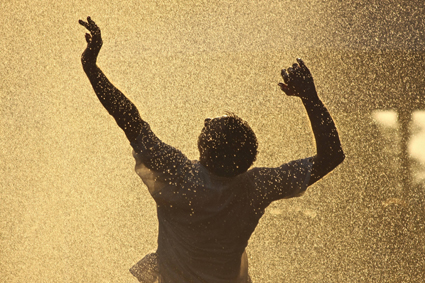
Michael Schumacher
photo Yana Paskova
Michael Schumacher
Improvisation is an established performance methodology that emerged from the American Postmodern rupture in dance more than 50 years ago. One proponent, choreographer William Forsythe, has activated several generations of dancer-collaborators to produce what could be considered a ‘Forsythe lineage’ of dance artists experimenting with improvisational methodologies. One key artist is USA-born Michael Schumacher.
Schumacher has danced with and produced award-winning choreography for many major companies including the Frankfurt Ballet, Twyla Tharp Dance, Pretty Ugly Dance Company, Netherlands Dance Theatre III, Jirí Kylián and the Dutch National Ballet to name a few. I spoke by phone with the amiable and erudite Schumacher ahead of his visit to Perth to perform with cellist Alex Waterman as well as conduct masterclasses for the MoveMe Improvisation Festival in November.
William Forsythe
A brief overview of Forsythe’s work is important to contextualise Michael Schumacher’s current practice. Forsythe forged his choreographic aesthetic by deconstructing the ballet vocabulary while director of Ballet Frankfurt (1985-2004). He also generated multiple ways to visualise and archive dance ideas, including documenting his ‘improvisation technologies’ (available as a CD-ROM), devising methods for visualising the information in One Flat Thing Reproduced (2006) (http://synchronousobjects.osu.edu) and collaborating on the shared archival platform www.motionbank.org. As director of the Forsythe Company (2005-2015), he extended his exploration of improvisational methodologies by facilitating dancer-collaborators to self-compose within ensemble parameters and devised interactive installations to mobilise audience-participants.
Postmodern pioneers
While Schumacher belongs to Forsythe’s balletic lineage, he also shares several concerns of postmodern improvising pioneers such as Anna Halprin, Steve Paxton, Simone Forti, Lisa Nelson and Deborah Hay who first started working with a Western (as opposed to an African or Classical Indian) approach to improvisation in the USA around the middle of the 20th century. Schumacher is part of an interesting generation of dance artists because the boundaries between previously divergent dance lineages now bleed freely. Classical or codified forms have been deconstructed and radicalised, while improvising performers consolidate techniques, producing a richer and more complex array of ‘intra-disciplinary’ creative choices.
The Schumacher perspective
I asked Schumacher what he loved most about improvisation. He explained that primarily his fascination stems from the fact that improvisation resists codification and delights in the fact that everyone does it differently. In his practice he prefers not to create rules around improvising, for example, “if you’re not going deep enough it’s not authentic. I say ‘authentic to whom?’ In my experience, rules are not important.” He suggests that his open approach is a result of his practice of the Alexander Technique in which he, “releases tension patterns and with that comes the release of ideas about how things should be done.”
While at Ballet Frankfurt Schumacher worked extensively with tasks but he favours the non-delineated approach of “finding the score organically and then recognising it” as this method produces a different quality of attention he prefers. He says of composing in real time that, “it’s been extremely valuable to me to know how to not ramble on in aimless pursuit of new information. In five minutes you have enough material to build a 15-minute composition. It doesn’t take a lot of time, but it does take a certain amount of attention.” He explained that he arrived at this insight through ongoing practice. “When I first entered into it, it was more of an automatic, intuitive flow which relied heavily on my kinaesthetic experiences. Then, I found that the rest of my sensory body was not aware of what was going on around me. In performance, I was not totally present and I missed a lot of potential interactions. That’s what led me back to sensory perception and conscious presence.”
What Schumacher terms ‘conscious presence’ utilises the multidimensional facilities of the human instrument which he describes as “the ultimate technology on the planet.” Conscious presence accesses another level of consciousness through the senses. He says, “the sensation has a huge impact on the execution. It’s a sensory experience, not just a kinaesthetic experience.” He describes the methodology of conscious presence as to “experience without associating” while listening and observing.
Schumacher explains, “The way to describe the experience of listening on the cellular level has a lot to do with not naming, not analysing. It’s not rational at all. It’s simply sensing: listening with my skin, listening with my bones, listening with my organs, listening with my eyes…” Through the practice of conscious presence, Schumacher has developed an appreciation for observation as a creative act. He adds, “So much of the time that we work with improvisation or anything creative, we feel that we must produce something. We have to do something in order to be part of the creative process. I am realising it’s not true. We know through quantum theory and philosophy that observation changes whatever we’re observing. Observation is participation.”
Somatic practices became a major influence for Schumacher after completing his formal training at the Julliard School, when he discovered ‘release’ classes. He says that the Alexander Technique and T’ai Chi Chuan are “the biggest influences on my dance in terms of the technique. I think the funny thing about T’ai Chi is that it actually taught me how to do ballet…and then, when I went to work in Frankfurt, [my classical technique] really grew and developed in a way that I didn’t expect.” He says, “There is a valuable contribution to the experience of moving and to executing something that’s virtuosic when you are also listening to the effect that the movement has on you. This might be in terms of physiology, kinesiology, biology and physics: that you’re really experiencing something more than just creating an image.”
When asked about narrative in his work he says, “Every moment we’re telling ourselves the story of us. In my training as a dancer and in the earlier improvisational experience that I had, there wasn’t much acknowledgement of that. It was always just execution and a virtuosic approach to movement through improvisation. I am interested in broadening that space where it’s not only about the virtuosic, it’s also about the sensing body.”
Michael Schumacher is a compelling addition to a strong line-up at MoveMe Improvisation Festival, which also includes Ros Warby, Rosalind Crisp, Andrew Morrish, Peter Trotman, Jo Pollitt, Paea Leach, Jacob Lehrer and David Corbet.
For more about Michael Schumacher, his works and MoveMe Improvisation Festival visit moveme.org.au; www.strutdance.org.au
STRUT National Choreographic Centre and collaborating organisations: MoveMe Improvisation Festival, Perth, 22-30 Nov; artists Michael Schumacher and Alex Waterman, Rosalind Crisp, Ros Warby, Andrew Morrish, Peter Trottman, Jo Pollitt, Paea Leach, Jacob Lehrer and, David Corbet, Madeleine Flynn & Tim Humphrey; selected works tour to Sydney’s Critical Path, Melbourne’s Dancehouse and Brisbane’s Judith Wright Centre, with Ausdance QLD.
RealTime issue #123 Oct-Nov 2014 pg. 24
© Nalina Wait; for permission to reproduce apply to realtime@realtimearts.net
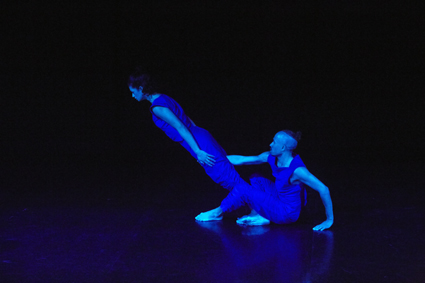
Niharika Senapati, Tyrone Robinson, Imanuel Dado and Storm Helmore, Precipice
photo Traianos Pakioufakis
Niharika Senapati, Tyrone Robinson, Imanuel Dado and Storm Helmore, Precipice
An axle of light cleaves the silence like a strange attractor in the deep night of space. Bodies balance on this precipice of becoming, staring across infinitude while succumbing to the forces of attraction and repulsion.
Rachel Ogle’s cosmic dance, Precipice, glances gravely into being as an impressively contained universe of matter and motion, of sound and light. It is difficult to determine whether the four dancers are actually distinguishable from the dimensions which they inhabit. They are enigmatic carriers of ceaseless patterns which both bind and confound the senses. In those first moments of approaching, falling away and returning, velocity gathers pace until the dancers’ energy splinters sound and illumination with screams of presence. Then, with a snap, the cry of human loss is cut as the audience is plunged back into the dark and soundless abyss. The cosmos seems to fold human agency and desire into yet other bits of matter circulating into eternity. But, in this work, the dancing and the dancers do still matter.
In earth-bound terms, the dancers’ sporadic encounters often wheel into irregularity. One dancer’s twisting instability is juxtaposed with a horizontal folding of the three others, edged sharply in their carefully composed unison of turning. Vibrational momentum wraps angle and speed unto itself, incipient with form and variation, straining towards thought and communication. There is the cosmos in planes of abstraction, and there is the cosmos of human imagination and interconnection, which demands an emotional response. Both exist, signalling significance, even if the miniscule and the daunting whole do not logically hold.
Here is where I found the precipice in the work, in the sheer drop in which matter on the grand scale turns human, pivoting around vortices towards meaning. Ultimately, the work is a conversation between the human and the cosmos where wonderment and debility collide though not necessarily in negative terms. The dancers’ counterbalancing highlights the logic of human cause and effect, before spinning interdependence back into the limitless space of potentiality. Duos that merge into quartets—intimate ideas about family and community—only to eddy back into prehuman atmospheres. Precipice’s strength lies in its capacity to precipitate this odd convergence of incommensurable understandings.
The lighting (Ben Cisterne) and soundscapes (Luke Smiles) partner the dancers: together they assemble and dissemble form and traverse the space of unknowing to forge ideas, often indistinct but always compelling. Near the end of this abstract space odyssey, there is a stunning moment of disappearance, when the audience is plunged into darkness and hit by a blinding light in a single instant. The assault on sight is a little disturbing until focus returns on the stilled image of Niharika Senapati’s silhouette, black in a curved universe of light, hovering hesitantly on the edge of some unseen chasm. The light recedes, drifting slowly into the distance until only her after-image remains, a ghostly sliver wandering the cosmos. Curiously, at the same time the departure of these effervescent particles evokes the rightful place of an embodied human dancer within the overwhelming thought of cosmic infinitude. Precipice settles the universe within while turning endlessly beyond.
Precipice, choreography Rachel Ogle, performers: Storm Helmore, Tyrone Robinson, Niharika Senapati, Imanuel Dado, visual design Ben Cisterne, composer: Luke Smiles/motion laboratories, costumes Colleen Sutherland; Studio Underground, State Theatre, Perth, 21-24 Aug
RealTime issue #123 Oct-Nov 2014 pg. 26
© Maggi Phillips; for permission to reproduce apply to realtime@realtimearts.net
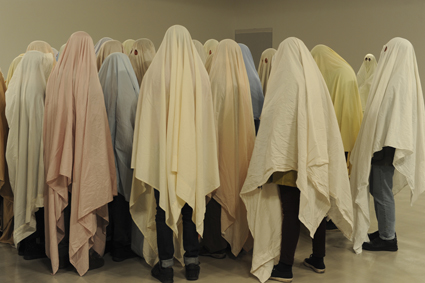
Luke George, Not About Face
courtesy Campbelltown Arts Centre
Luke George, Not About Face
The audience is ushered into an empty white gallery and, as with preparations for a kids’ game, we are assisted in putting sheets over our heads. Before long I stand among an assembly of ghosts in hues of pistachio, lilac, blush and fawn. The intention may be anonymity but I feel self consciously recognisable. The friend who has accompanied me is unaccustomed to the independent dance scene, though familiar with the protocols of theatre and the gallery. He chooses to pull his beanie over his bed(sheet) head and takes a series of photos on his iPhone—we are in a gallery after all.
All I can do is fidget, finding ways to wear my shroud: air underneath, shaping from outside, gather in, smooth over, endless methods in an attempt to get comfortable, in order to concentrate on the performance. Some audience members adjust themselves in a similar manner, while a few renegade spirits slouch against the walls. The majority follow the leader leaning into the alabaster ghost in the centre of the gallery.
There is something in the air of Not About Face as Luke George directs us to press harder, feel the vibrations between us and shake with him. Like a corporealist evangelist he passionately intones about bodily fluids, saliva and brain cells, bringing our attention to the aura that is so close “I could be you and you could be me.” I recognise the zeitgeist, a collective choreographic consciousness characterised by throwaway yet earnest detachment between the flesh performing and the bodies watching—through their Casper eyeholes. Still covered in their sheets his audience curls up on the floor ‘spooning’ each other. Unlike George and most of the audience, I don’t want intimacy, collective desire or to vibrate together. Tonight I don’t feel empathy. I feel coerced and I’m not in the mood for post-irony. Nearing the end, George discards his shroud and dances ecstatically in a skimpy lycra wrestling unitard. Like a charismatic preacher George’s dancing does tap into a collective consciousness of bodies and flesh. His moves are an interesting mix of brittleness and assurance. I enjoy the exuberance of the dance. This part of the experience does affect me and I am left in a state of agreeable bemusement.
Coming out from under our hot shrouds we enjoy the relief of the cool night air before shuffling into the Performance Studio for the second work of the evening, Cheerleader of Europe. The lights shine down on the audience. This is one of those theatrical settings where you feel implicated, in quite a different way from the earlier work. You can’t hide under your sheet, nor sit there in the dark, or relax and do nothing.
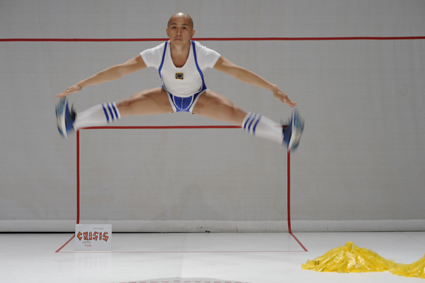
Daniel Kok, Cheerleader of Europe
courtesy Campbelltown Arts Centre
Daniel Kok, Cheerleader of Europe
The compact Daniel Kok, from Singapore, wearing the second lycra wrestling unitard of the evening, charms us with a tragic ‘true’ tale of army cadets and a fatal shooting, followed by a chirpy cheerleading routine. Hand coloured flags and “Song of Joy” set the scene for ruminations on the European Project. Once again there is dancing flesh and a proclamation, “My body is right here in front of you…the organs in between…with toes to live the dream…” Once again hints of the collective choreographic consciousness pervade the half-hearted if entertaining movement vocabulary. The manipulative, smooth, dictatorial tone serves as a complementary accumulation to the evangelical voice of the first work.
An awkward apolitical conversation with an audience member who lives here and is ‘European’ ensues. Banal questions such as “Do you feel Australian?” offer little in the way of enlightenment for this audience as to our position in the world. In between, Kok offers apologetically, “I don’t want to put you on the spot.” My European friend mutters, “Well you did,” and I laugh under the bright light. Other than a short, sketchy, informal introduction where he informs us of the previous context for this work, Daniel Kok hasn’t rethought the purpose of this performance, originally for a European audience, in its recasting for an audience in Greater Western Sydney, Australia.
I look for guidance as to how I should respond to these performances. A list in the Program Notes categorises “4 Levels of Engagement in a Performance” (Kok). I take on the advice, as it appears that I am a “meta-critical,” “critical spectator” “engaged in pluralist and agonistic audienceship!” Both works overtly deal with “the nature of the unseen and unspoken agreements/traditions between performer and audience” (George). While George remonstrates with the audience if they don’t do what he wants, Kok “wishes to marshal the community towards a sense of unity” where “everyone must be happy in the end.”
“Come on, do something. We are from Europe,” Kok cheers. “We are from Europe,” he urges us to chant. I can’t summon up the puff to make any sound but my friend sitting next to me, repeatedly utters in his gravelly Eastern European accent: “We are NOT from Europe, We are NOT from Europe. We are NOT from Europe.” Now, in the end, as confetti falls, Kok gets his wish. I am happy. But I am happy that we are NOT from Europe.
Luke George, Not About Face; Daniel Kok, Cheerleader of Europe; Campbelltown Arts Centre, NSW, 1-2 Aug
RealTime issue #123 Oct-Nov 2014 pg. 26
© Julie-Anne Long; for permission to reproduce apply to realtime@realtimearts.net
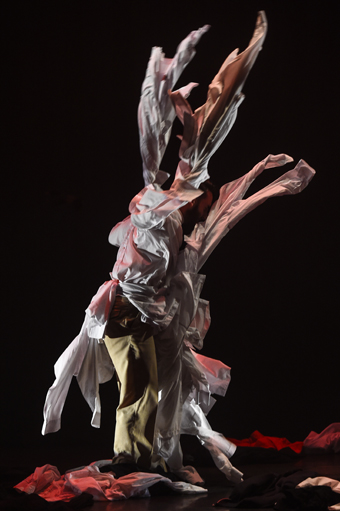
Timothy Walsh, In, Gavin Webber, Threefold, photo Leigh Turner, Bottlebrush Studio
Threefold brings together three choreographers, each with a distinctly different aesthetic, for a triple bill of short, powerful, contrasting works. Bosco Shaw’s clever lighting design paradoxically enhances both the delineation of each work and the coherence of the trio of creations, reinforced by the same six mind-blowing dancers performing throughout.
The flow from Huang Yi’s minimalist Echo, focussed on pure gesture, light and shadow, to Gavin Webber’s twitchy acid trip In, to Raewyn Hill’s soul-clutching A dance for the forgotten, is the perfect order for presentation. The audience is prepped by wonderment in the first, raised to fever pitch in the second and have their hearts broken in the third.
A collaboration between Dancenorth and Tasdance, Threefold comprises a suite of two independently commissioned works—Gavin Webber for Dancenorth, Dancenorth’s artistic director Raewyn Hill for Tasdance—and one joint commission by Huang Yi from Taiwan, in his premiere work for an Australian audience.
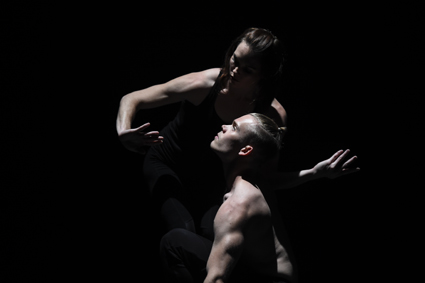
Echo, Huang Yi
photo Leigh Turner, Bottlebrush Studio
Echo, Huang Yi
Huang Yi, Echo
Echo played out with unnerving precision to a soundtrack of low, incessant industrial rumble. Confined in intermittent squares or spots of bright light, with no discernible beat or phrases to work to, astonishingly the dancers seemed to synchronise every gesture to apparently random loud metallic clangs, clunks and booms.
The number of dancers seemed to change as they moved into the light pools with their shadows and were then absorbed back into the surrounding darkness. The lights switched off and on, merged, separated, as did the dancers, variously moving solo, in duo or ensemble; embracing, chasing, counterbalancing, dragging and re-placing each other. Gestures hinted one moment at capoeira, another at flamenco or ballet. This was dance quick, slow motion, sharp, fluid, combative or complicit, but always exquisitely precise. Spoiler alert: hidden technology was the key to perfect synchronicity in the absence of countable rhythm: rather than the dancers reacting to the sounds, the noises were activated externally by smartphone in response to the dancers’ movement.
Gavin Webber, In
Gavin Webber’s In ends with a dancer facing the audience to apologise: “Yeah, shit got out of hand, sorry,” a fitting conclusion to a chaotic journey (somewhere between a romp and a nightmare) through themes of conformism, bullying, manipulation, aggression, peer pressure, escapism and exhibitionism. Webber uses a recurring motif from his works as former artistic director at Dancenorth: clothing—worn, removed, exchanged, folded, piled, dumped from above to engulf and slapped on the floor in rhythm to Hendrix-like wailing guitars. Commencing with five dancers in business suits with one standout in casual exercise gear, there’s trouble from the start as she’s harrassed to change. But even as she conforms, the bar keeps changing as fast as the clothes do. These brittle, posturing and confused people indulge in a relentless, highly physical, sometimes almost violent game of sabotage while vying for their moment in the sun. “I’ve got something to say about current issues,” shouts one as he’s thrown around by another, “but it may not be pretty.” We never hear what it is as she weighs him down with layer upon layer of jackets.
The piece builds to a prolonged red-lit guitar trance party of frantic shaking bodies, and after the increasing sense of alienation reaches its pitch, the final apologetic statement is like being slapped out of it.
Raewyn Hill, Forgotten
Raewyn Hill’s A dance for the forgotten is the compressed essence of a 60-minute work made for the Tasmanian festival Ten Days on the Island in 2007. Like its place of conception, Port Arthur, the work contains layers of history and tragedy which, supported by the moving score (Eden Mulholland’s reworking of Pergolesi’s Marian Vespers), gives its themes a timelessness. The set conspires in suggestive simplicity. The space is atmospherically sidelit by vertical lighting set into tall wings, two at one side of the stage, one on the other. The dancers, clad in Alistair Trung designed costumes which defy period classification, surge from side to side through golden shafts of light on the otherwise black stage, the physical expression of the call and response in the gothic chant. They surge back, but someone is left behind. “Erynne!” they scream, reaching for the lost one, and sobbing breaths punctuate the music again and again.
A characteristic of Hill’s work is her ability to have multiple performers move as a single organism, from which dancers disassociate and reattach without losing a sense of connection. This is used to outstanding effect, evoking our common humanity and shared grief over unspeakable tragedy. A final series of lifts, a succession with each dancer moving the next, is interrupted with a plea to “Get down!” but a dancer’s hands fling back in slow motion, his chest recoiling, and it is over.
The physical and emotional diversity of Threefold must tax the dancers to the limit, but the energy never flagged in the commitment of Dancenorth’s Alice Hinde, Erynne Mulholland and Andrew Searle and Tasdance’s Sarah Fiddaman, Brianna Kell and Timothy Walsh.
TasDance/Dancenorth, Threefold, Dancenorth, Townsville 7-10 Aug and toured to Mackay, Cairns, Launceston and Hobart.
RealTime issue #123 Oct-Nov 2014 pg. 27
© Bernadette Ashley; for permission to reproduce apply to realtime@realtimearts.net
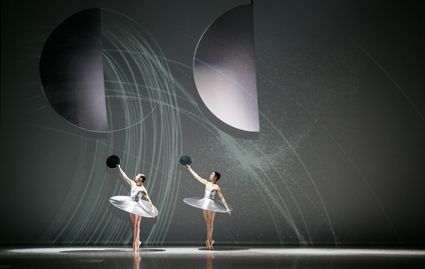
Abigail Boyle and Laura Jones in Satellite
courtesy Royal New Zealand Ballet
Abigail Boyle and Laura Jones in Satellite
Daniel Belton’s career is a victory over the tyranny of distance. Based in the regional New Zealand town of Dunedin (closer to Antarctica than Hobart is), Belton has turned to producing dance films for international festivals. His most striking works however are difficult-to-tour multimedia dances such as Soundings (2000).
Satellites (2014) is a collaboration with the Royal New Zealand Ballet, enabling Belton to again work on a grand scale, placing multiple live bodies in front of and behind semi-translucent projections and sculptural objects.
The steely, silver and grey visual aesthetic of Satellites evokes planetary metaphors and Modernist visions of outer space. Jac Grenfell’s projected animations sketch Saturnalian arcs traced by small bodies mathematically circling around off-screen behemoths. The audience gazes from above or at a slight angle into these misty discs of interstellar dust, while dancers holding small mirrored rounds create a similar sense of backscatter across the space. The upper quadrant of the proscenium is often occupied by two vast, metalic discs, spinning gently.
The tableau is in this sense powerful and coherent, fusing 1950s dreams of spatial conquest and science fiction, with early Modernist and Futurist precedents from Europe. One could imagine Satellites as a grand early Soviet ballet. Indeed Belton and costume designer Donnine Harrison end the work with the entry of one then two ballerinas clothed in sleek, metallic dresses and tutus which are modelled on Oskar Schlemmer’s designs for the Bauhaus’ Triadic Ballet (1922).
Choreographically, the piece has an overall drag of left to right. Although figures do enter from the right (notably the closing ballerinas), these events act as a counterpoint to the way in which figures enter from the left, coalesce and gesture back from whence they have come, arms held out in forceful lines like Olympic heroes, often with the reflective discs featuring, before they seem to drop off to the right. This larger pulsion of movement echoes the circuits which the projected planetoids take, down the upper arm of curves rolling around left to right. It is as though cosmic tides wash the dancers away into utopian infinity.
As ballet-trained dancers, the performers of the Royal New Zealand Ballet emphasise the clear lines of Belton’s choreography, moving into statuesque combinations and holding the apogee of movements and poses rather than being swept into expressive flow (though this is undercut somewhat by the baggy pants worn by the male dancers). Broadly, the concept of scattering seems to act as a dominant organising principle as dancers break off into varied groupings from larger, unified associations, reassembling at irregular intervals into collectives of two or more.
This loose, open feeling in the choreography, together with elements of pedestrian or relaxed movement, is set against a sense of grandeur and a highly sculptural, material stage design with which the dancers must engage—suggesting Twyla Tharp meets Merce Cunningham (and perhaps a touch of Schlemmer’s contemporary, Leni Riefenstahl).
Scholars debate whether Cunningham’s sculptural complexity and precision made him Modernist (in the sense of Schlemmer) or Postmodernist like Tharp, but Tharp’s lighter touch and generally more gentle framing of the body seems closer to Belton’s approach. Belton’s scenographic framing by contrast presents something closer to Cunningham’s tendency to trawl through the history of Modernism for formal inspiration (such as in Cunningham’s Walkabout Time, featuring a set by Jasper Johns inspired by Marcel Duchamp’s The Bride Stripped Bare by Her Bachelors, Even, 1923).
Satellite’s unstable positioning with respect to the divide between Modernism and Postmodernism is most evident in the collision of an otherwise utopian, almost spiritual visual palette, as opposed to Jan-Bas Bollen’s music, which owes more to Postmodern themes of communication breakdown. Bollen has previously created notated homages to composer Iannis Xenakis, but here his soundscape is sophisticated glitch-funk such as that popularised by labels like mille plateau and Bip-Hop in the 1990s. Key elements of Bollen’s acoustic palette include the digitally processed sounds of electricity sparking, or the effect of short-circuits upon amplification devices.
While the planets and the dancers move smoothly, the sound does not. Rhythmic pulses are interrupted by our futuristic technology, glitching and becoming embedded within interstellar noise. One can envisage an alternative version of Satellites in which the dance fragments along with the sound—planets careening off their orbits like so much chaotic space debris and the dense static force of Bollen’s sonic bed overwhelming our attempts to reclaim this material from Modernism’s confident utopianism.
Royal New Zealand Ballet, Satellites, part of the Allegro program, choreography, conceptual design Daniel Belton, stage design, sculpture Jim Murphy, costumes Donnine Harrison, animated projection Jac Grenfell, music Jan-Bas Bollen, Regent Theatre, Dunedin, NZ, 23 Aug
RealTime issue #123 Oct-Nov 2014 pg. 28
© Jonathan Marshall; for permission to reproduce apply to realtime@realtimearts.net
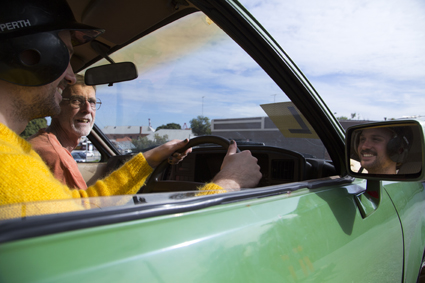
Proximity Festival 2014
promotional photo Tarryn Gill
Proximity Festival 2014
Proximity Festival, Australia’s celebration of one-on-one performance, finds big dreams, plans and talents being brought to bear on the most intimate artistic performance experience.
Proximity Festival 2014 has a new home at the Fremantle Arts Centre for its three programs running from 22 October to 2 November. Producer Sarah Rowbottam has been sharing the helm with co-founders James Berlyn and Kelli McCluskey since the festival’s inception, and is enthusiastic about the many “firsts” added to the one-on-one performance festival’s composition each year.
2012 welcomed the first Proximity Festival, with daily bumping in and out of an eclectic collection of shows at The Blue Room Theatre in the middle of the frenzy of Fringe World, where it won the Spirit of Fringe Award. 2013 found Proximity Festival occupying an entire venue, enjoying more established settings in the studios, gallery spaces and random nooks and crannies of PICA and introducing the public Symposium and artists’ Lab programs. This year, moving away from Northbridge to the Fremantle Arts Centre, the Symposium program has changed to include all festival artists in the keynote, an intensive weekend Masterclass for the general public has been introduced, a national curatorium has been assembled and artist Julie Vulcan has been invited in as provocateur, bringing new ideas and experience to the core curatorial team.
The 12 micro-performances range widely not only in their use of space, but in the scope of their coverage of artistic practice and topics. Rowbottam is enthusiastic about the power of the “subtle but strong messages” possible in the un-themed collection. In Let’s Make Love, Jen Jamieson scientifically examines the bonding hormone oxytocin with you, but minus the romance, while in The Queue, Toyi-Toyi Theatre will test your ‘Australianness.’ Air from different eras generates atmosphere in Emily Parsons-Lord’s Different Kinds of Air, A Plant’s Diary; voices lead the way in Dance with Me by Sylvia Rimat; and Ian Sinclair’s Learner may cause stress as you teach him how to drive. Vulcan says, “some of the simplest ideas are the most beautiful” and some of the most basic ideas are also the most evocative. “Not all performances in a program will affect you in the same way. Even if only two out of four capture your attention, the other two are a bonus, which would be the case in any hour-long performance”, just as most staged theatre, consisting of spaced climactic points, will not be uniformly compelling.
Three programs of four shows apiece accommodating a total audience of 12 each night work against the aims of most arts festivals. Stepping away from the notion of bigger being better, Rowbottam cites fellow festival founder James Berlyn’s belief: “There are equally big pay-offs for audience and performers in small-scale, intimate and one-on-one works”—a philosophy that sees Proximity Festival create a space for the audience and artist to grow and create something new with each and every performance.
Before the festival, the artists are put through a two-week developmental program, Proximity Lab, overseen by the festival’s provocateurs, a process that Rowbottam says is “important in breaking preconceptions.” The Lab and Masterclass also bring together artists with an interest in the form. Vulcan is enthusiastic about the “richness of gathering artists together, an inspiring aspect” that develops one-on-one practice. And the festival is educating audiences about this artform; she is confident that “growth will come through word of mouth.”
Rowbottam is also keen on making artists self-sufficient beyond discovering the essentials of their art, with a pragmatic workshop on how to market themselves and create opportunities in the commercial reality of the contemporary art world. Alongside developing a sense of the global market for one-on-one works, Rowbottam wants artists to “keep to the spirit of the performance, while considering everything that can go wrong,” to consider personal and artistic boundaries both for artist and audience in the potentially confrontational nature of one-on-one presentation. Vulcan says that artists “can forget about the needs of the audience and assume the audience wants to be there and creating with them.” As provocateur she encourages the artists to think in terms of an exchange of gifts via performance, to consider what is being given and on what levels.
With a national curatorium, guest provocateur, a more diverse opening night, its Lab and Masterclass, Proximity Festival is finding every way to grow, save for raw audience numbers. But each night is sold out. More inquisitive audiences seek the experience of participation. The opening night Party for 1 promises to be lots of fun, with lateral thinking shaping the planning process. Rowbottam reminisces about rejected plans for 2013’s initial opening night, which included sitting down at the bar for a quiet drink with all 12 audience members, but this year’s plan looks more interesting, offering a celebration of one-off performances, music and “hidden surprises,” along with the cake. Even the keynote speech at the Symposium is evolving, with the 12 performers each delivering intense insights into their work with one-minute manifestos.
Proximity Festival 2014 promises great things, not only in itself, but in the development of artists, audiences and tourable works in the years ahead.
See RealTime Profiler 6 for Ben Brooker’s interview with Cat Jones, a 2014 Proximity Festival artist.
Proximity Festival 2014, advisor, provocateur James Berlyn, co-curator, producer Sarah Rowbottam, co-curator Kelli McCluskey, provocateur Julie Vulcan, artists James Berlyn, Caroline Garcia, Jen Jamieson, Cat Jones, Loren Kronemyer, Tanya Lee, Emily Parsons-Lord, Sylvia Rimat, Hallie Shellam, Ian Sinclair, Alina Tang, Toyi-Toyi Theatre; Fremantle Arts Centre, 22 Oct-2 Nov; www.proximityfestival.com
RealTime issue #123 Oct-Nov 2014 pg. 13
© Nerida Dickinson; for permission to reproduce apply to realtime@realtimearts.net





























































































